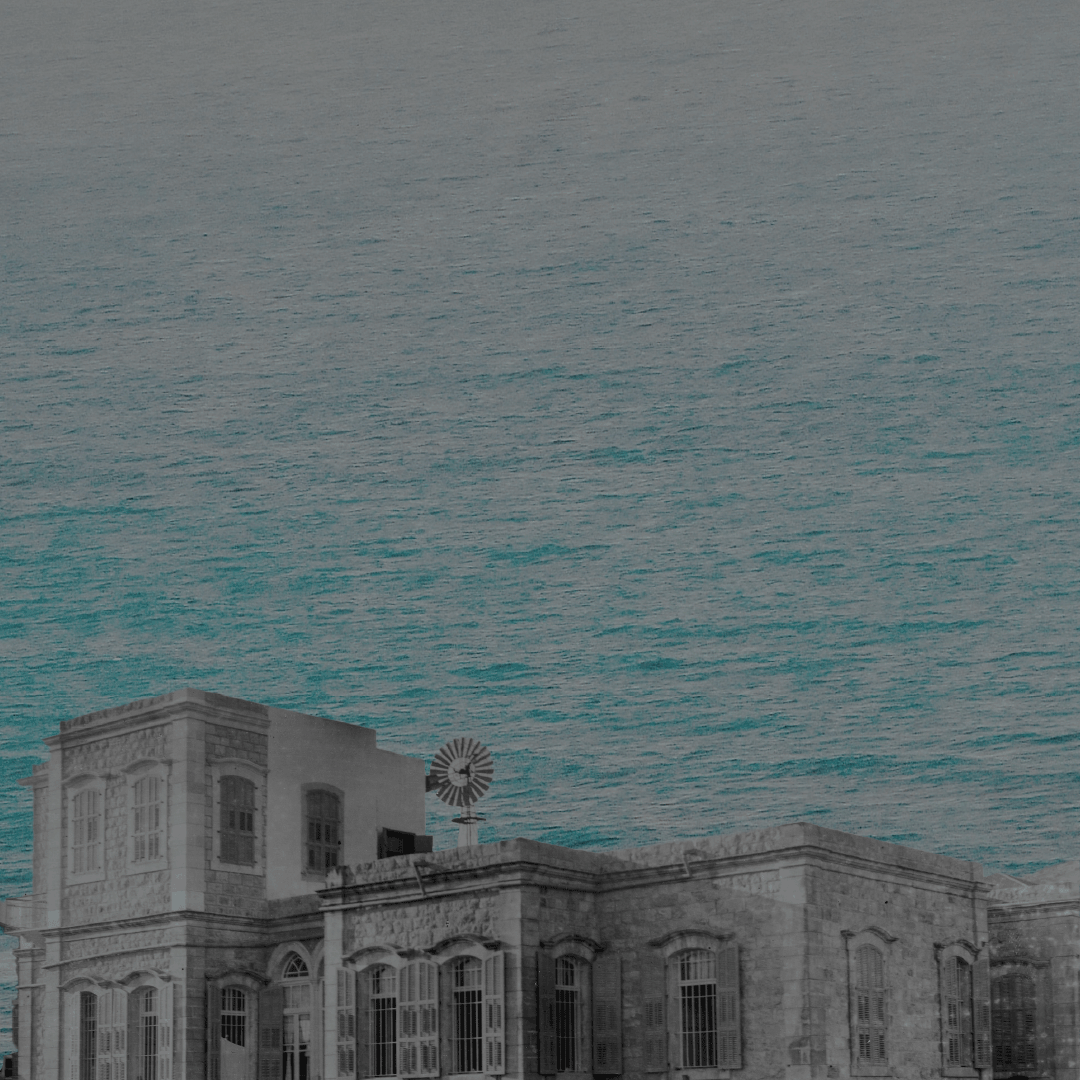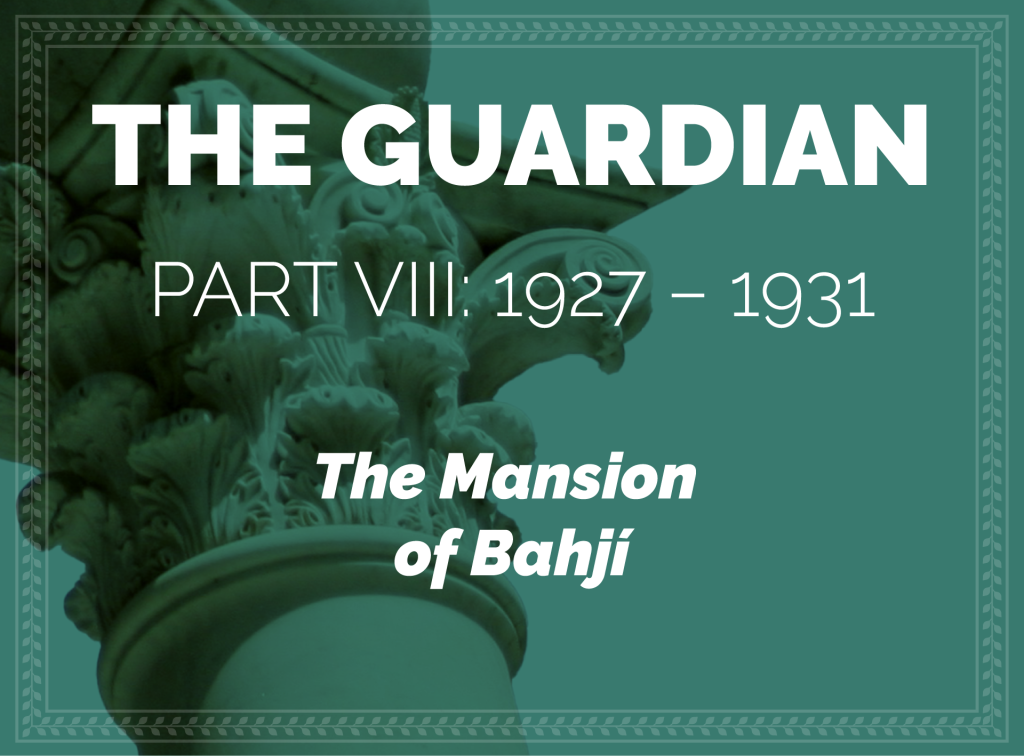
Written and illustrated by Violetta Zein
This part covers the life of Shoghi Effendi from the age of 30 in 1927 to the age of 34 in 1931.
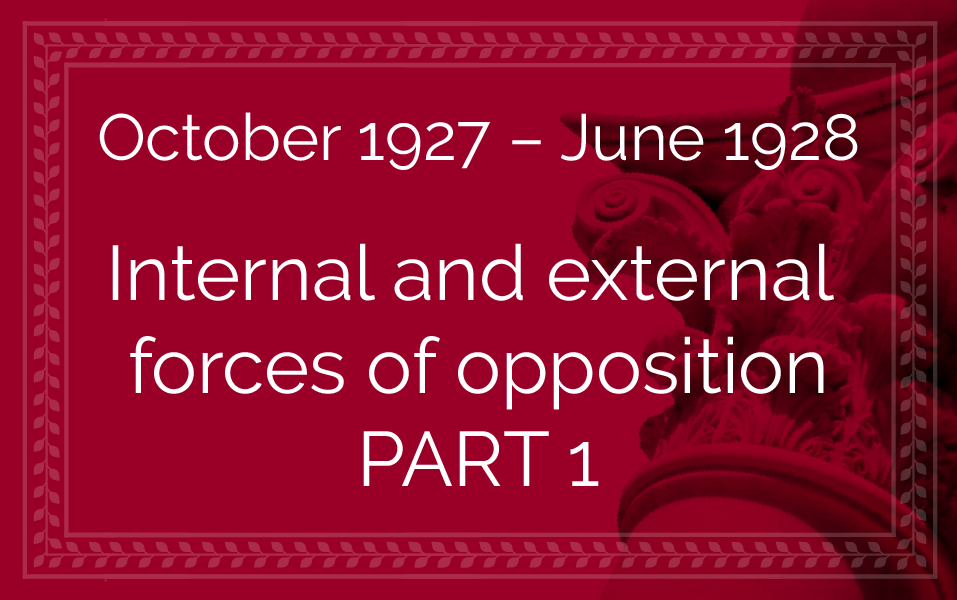
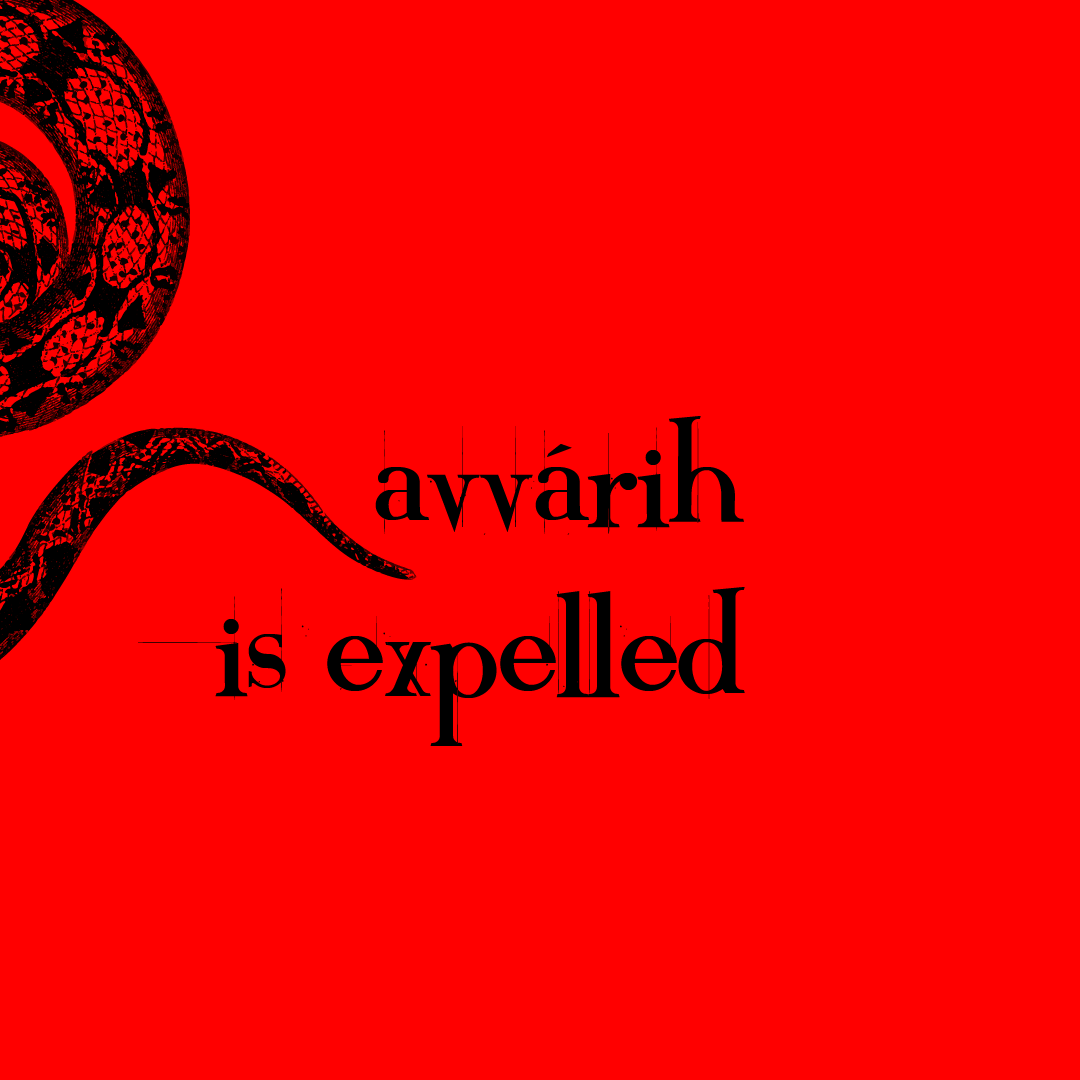
Avárih returned to Persia, he worked as a teacher in high school for the rest of his life.
He changed tactics and began writing letters to the members of 'Abdu'l-Bahá’s family saying there had been a misunderstanding, and if Shoghi Effendi would only arrange an annual income for him, he would stop working against the Guardian and actively opposing the Covenant of Bahá'u'lláh.
Once the Guardian formally expelled him from the Faith, on 17 October 1927, and branded him a Covenant-breaker, his life was shattered.
His wife left him and refused to associate with him. She remained a devoted and much-praised Bahá'í because of this immensely courageous act.
He was separated from his only child.
He was denied entry into his own home.
He was shunned by the entire Persian Bahá'í community.
He was abandoned by his lifelong friends.
He never gained any income from the book he had written on the Faith and published in Egypt.
Eventually, Avárih became a Muslim, and continued to attack the Faith openly, writing a three-volume attack on the Faith, and the Guardian officially declared him a Covenant-breaker.
Avárih wrote several letters of repentance to the Guardian, in which there was absolutely no indication of repentance.
When the Guardian did not respond to his hypocritical letters, he unleashed his satanic nature and wrote the vilest, most abusive letters to Shoghi Effendi, using vile, offensive languages, and vowing revenge, saying he planned to destroy the Faith of Bahá'u'lláh altogether.
In the revolting history of Covenant-breakers, there would never be anyone as vile as Avárih.
Out of rage, Avárih became a Muslim and allied himself with the most fanatical elements of the Shí’ah clergy, the most orthodox Christian missionaries in Ṭihrán, and every person he could find in the Persian capital that was opposed to the Faith. With those friends in his pocket, Avárih used his fiendish subtlety to appeal to government officials for financial assistance.
He continued to attack the Faith openly, and wrote a three-volume attack on the Faith. He denounced the teachings of the Faith, discarding them as ineffective, he rejected the Will and Testament of 'Abdu'l-Bahá, he attacked the Blessed Persons, Missions and motives of Bahá'u'lláh and the Báb.
But he did not stop there.
He revived the malicious lies of the 19th century, claiming that Bahá'ís were the sworn enemy of Persia, the wreckers of the faith of Islam.
Avárih’s full-time occupation was to strike terror in the heart of the Bahá'í community, to sow seeds of doubt in the minds of any Muslim Persian who was even slightly favorable to the Bahá'ís, to poison the minds of any Persian who was indifferent to the Bahá'í community, and to reinforce the capacity for oppression and persecution of the Bahá'ís for all those in positions of power.
He labored for years in vain.
He was a failure at everything, even Covenant-breaking.
Thankfully, the end of the nauseating story of Avárih ends with his death in 1953
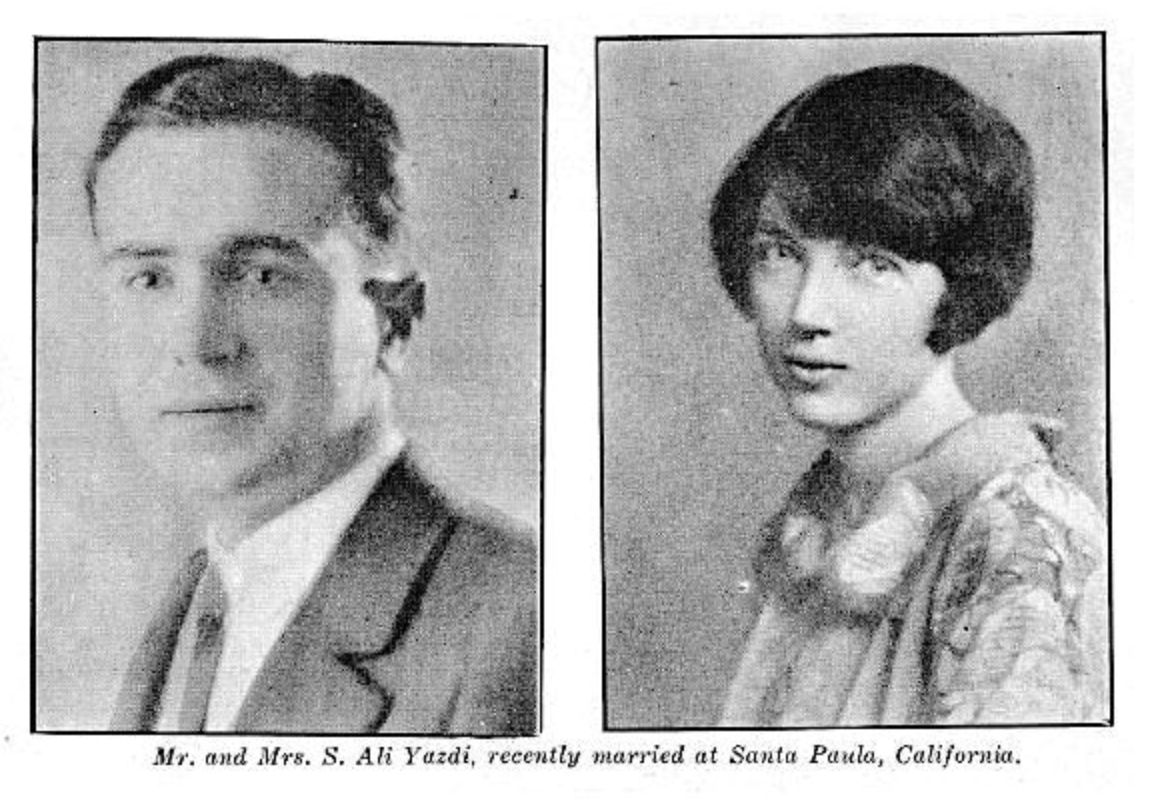
‘Alí Yazdí and Marion Carpenter Yazdí shortly after their marriage, a few years before their pilgrimage. Source: Wikimedia Commons.
Marion Carpenter was born in Michigan in 1912, and was the first Bahá'í to attend the University of California at Berkley, and the first Bahá'í to attend Stanford University. As a young girl during World War I, she had begged 'Abdu'l-Bahá for permission to come to the Holy Land on pilgrimage, but communications were cut off and she never received a response.
When she started her studies at UC Berkley in the fall of 1920, she wrote to 'Abdu'l-Bahá again, requesting permission to come on pilgrimage, and 'Abdu'l-Bahá sent her a loving Tablet in answer to her letter in which He answered all her questions and wrote:
I hope that you…may make the visit, but at present it is not possible.
In August 1921, a handsome young Persian Bahá'í arrived at UC Berkley. He was remarkable from every point of view: he was profoundly deepened in the Teachings, he was utterly devoted to 'Abdu'l-Bahá, he was exemplary in his studies, he had a wonderful character, and he was all-around a fascinating person.
His name was ‘Alí Yazdí.
Marion could not get enough of ‘Alí’s stories about 'Abdu'l-Bahá, whom he had met countless times between 1910 and 1919 both in Ramleh, Egypt, and in Haifa.
Three months after Marion and ‘Alí Yazdí met, 'Abdu'l-Bahá passed away on 28 November 1921, so Marion never had the bounty of meeting Him in person. But she had ‘Alí Yazdí now, and she would live and breathe his stories about the Master. ‘Alí and Marion married in 1926, and two years later in 1928, Marion finally was able to go on pilgrimage, and ‘Alí was finally able to see Shoghi Effendi again after a separation of 8 years, since they had last seen each other in Oxford in 1920.
The last time they had met, Shoghi Effendi was a 23-year old student at Oxford and ‘Alí Yazdí was 21 years old, on his way to UC Berkley. Now, 8 years later, Shoghi Effendi had been the Guardian of the Cause for 7 years already and ‘Alí Yazdí had become a civil engineer.
When he was leaving, Shoghi Effendi encouraged ‘Alí to write to him and their friendship lasted to the end of the Guardian’s life. ‘Alí Yazdí did not want to burden the Guardian, he was all too aware—having spent so much time with 'Abdu'l-Bahá in his youth—the heavy responsibilities which the Head of the Bahá'í Faith had to bear. But ‘Alí did write to the Guardian on special occasions, when he had particularly good news, and the Guardian—as he had when he was a young man—always responded very warmly to his old friend’s letters.
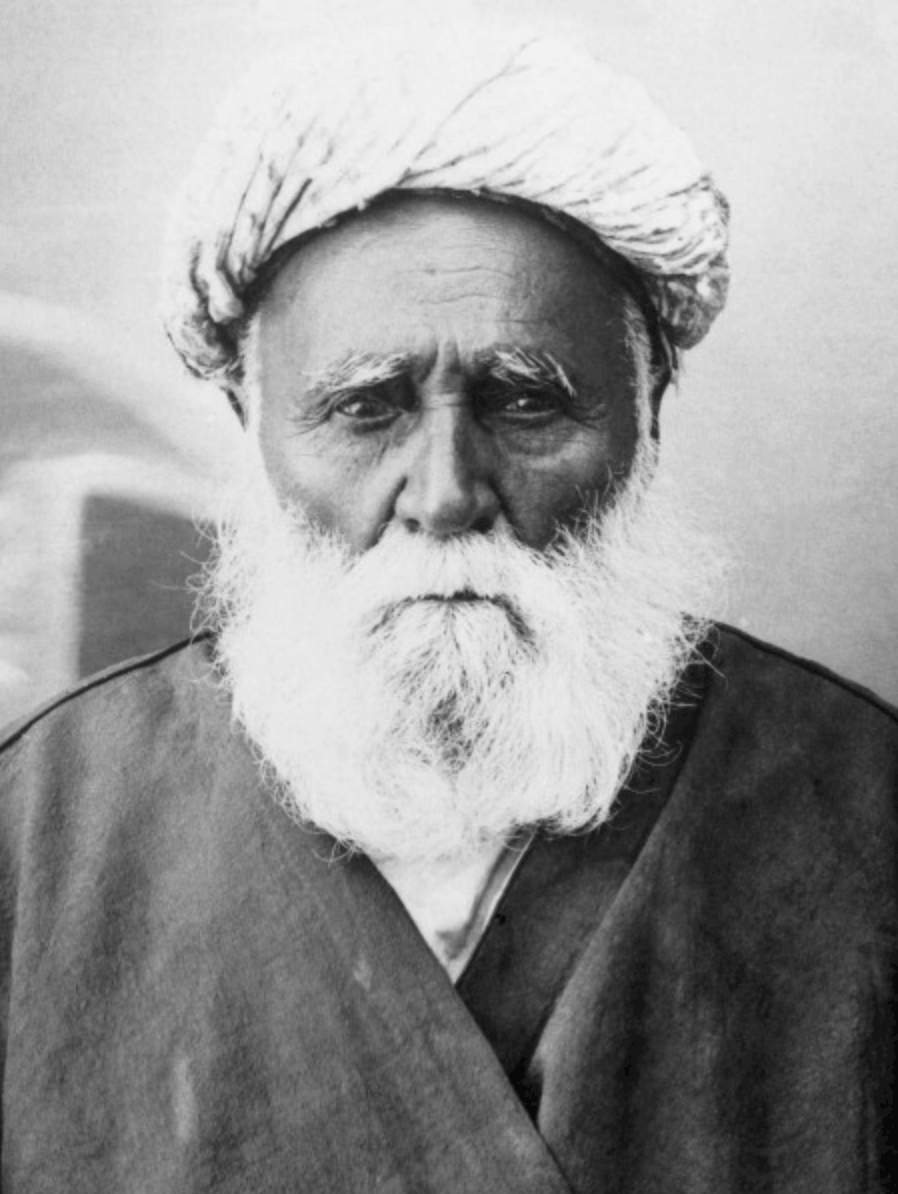
The eminent Ḥájí Amín, Apostle of Bahá'u'lláh, Hand of the Cause, Trustee of the Ḥuqúqu’lláh. Source: Bahaimedia.
Hand of the Cause Ḥájí Amín died in 1928, but we do not know the day or month, therefore this post is placed at this point in the chronology purely arbitrarily. Ḥájí Amín, Hand of the Cause, Apostle of Bahá'u'lláh, and the second Trustee of the Ḥuqúqu’lláh for 47 years, was a man of many names.
He was born Abu’l-Ḥasan-i-Ardikání. After he went on pilgrimage he was known as Ḥájí born Abu’l-Ḥasan-i-Ardikání, but he was also known as Mullá Abu’l-Ḥasan, and by his titles, Ḥájí Amín, and Amín-i-Iláhí (Trusted of God). He became a Bahá'í at the age of 17, and self-funded his travels around Persian by being a scribe and living a very simple, almost austere life.
Arriving six months after Bahá'u'lláh, Ḥájí Amín was the first Bahá'í to return to Persia with news of His whereabouts.
In 1880, Bahá'u'lláh appointed Ḥájí Amín the second Trustee of the Ḥuqúqu’lláh and he travelled around Persia and neighbouring countries like Azerbaijan and the region of the Caucasus for 11 years until he was arrested.
In 1891, Hands of the Cause Ḥájí Amín and Ḥájí Ákhúnd were imprisoned in Ṭihrán. Naṣiri'd-Dín Sháh, who liked to have photographs taken of his noteworthy and resilient prisoners—he had commissioned several portraits of Badí’ being tortured—did the same again with Ḥájí Amín and Ḥájí Ákhúnd. He had them photographed seated on the ground wearing their heavy chains around their neck with their jailers towering over them.
That photograph showed nothing but calm and fortitude. 'Abdu'l-Bahá loved the photograph so much he kept a copy near his room in 'Akká.
After 3 years of imprisonment, Ḥájí Amín was released in 1894, and spent all his time traveling for the Ḥuqúqu’lláh. In 1912, Ḥájí Amín travelled to London and brought 'Abdu'l-Bahá Ḥuqúqu’lláh contributions including what is probably the most precious Ḥuqúqu’lláh contribution of all time, two small loaves of dry, black bread and an apple, the humble dinner of a poor Turkmen worker in ‘Ishqábád. 'Abdu'l-Bahá pushed away his plate, opened the handkerchief in which it had been carried, broke off pieces of the bread and handed them to those present, saying:
Eat with me of this gift of humble love.
Ḥájí Amín made a total of 19 pilgrimages to the Holy Land and spent the rest of his life working as the Trustee for the Ḥuqúqu’lláh, until the day he died.
Ḥájí Amín passed away in Ṭihrán prior to July 1928 at the age of 92.
Shoghi Effendi elevated Ḥájí Amín posthumously to the rank of Hand of the Cause of God in an untranslated letter written in a mixture of Persian and Arabic and addressed to the Friends in Persia. Adib Masumian, provisional translator of the Writings of the Bahá'í Faith, has translated the last paragraph of this momentous message dated July 1928, as a gift for this chronology, and for this, we are immensely grateful:
The shocking news of the ascension of the honorable Amín-i-Iláhí to the Abhá Kingdom was the cause of immeasurable sorrow and regret. For many successive years, that distinguished individual, that noble soul, was intimately engaged in service to the sacred Threshold with an astonishing resolve and devotion. Not a moment’s peace did he enjoy; not a minute did he rest. In his firmness and faithfulness, he was an example to the companions and righteous ones—and in the extent of his sacrifice, the loftiness of his endeavor, the purity of his intent, and the immaculacy of his nature, he was the leader of the beloved and virtuous. He was accounted as one of the active Hands of the Unseen Abhá in that country [Persia], and numbered with the specially favored souls near to the divine Court. His is an exalted station, and his resplendent services will not be effaced with the passing of centuries and ages. The value of these sanctified souls is not known today. Soon will the men of the earth take pride in them, and the denizens of this realm remember the traces they left behind, and the masses of humanity vaunt them over all the world. May God grant him a dwelling-place in the vastness of His paradise, rain down the showers of his mercy and beneficence upon his radiant grave, and immerse him in the depths of His forgiveness and pardon. He is, in truth, the Sustainer, the Forgiver, the Pardoner, the All-Powerful, the Most Exalted, the Almighty.
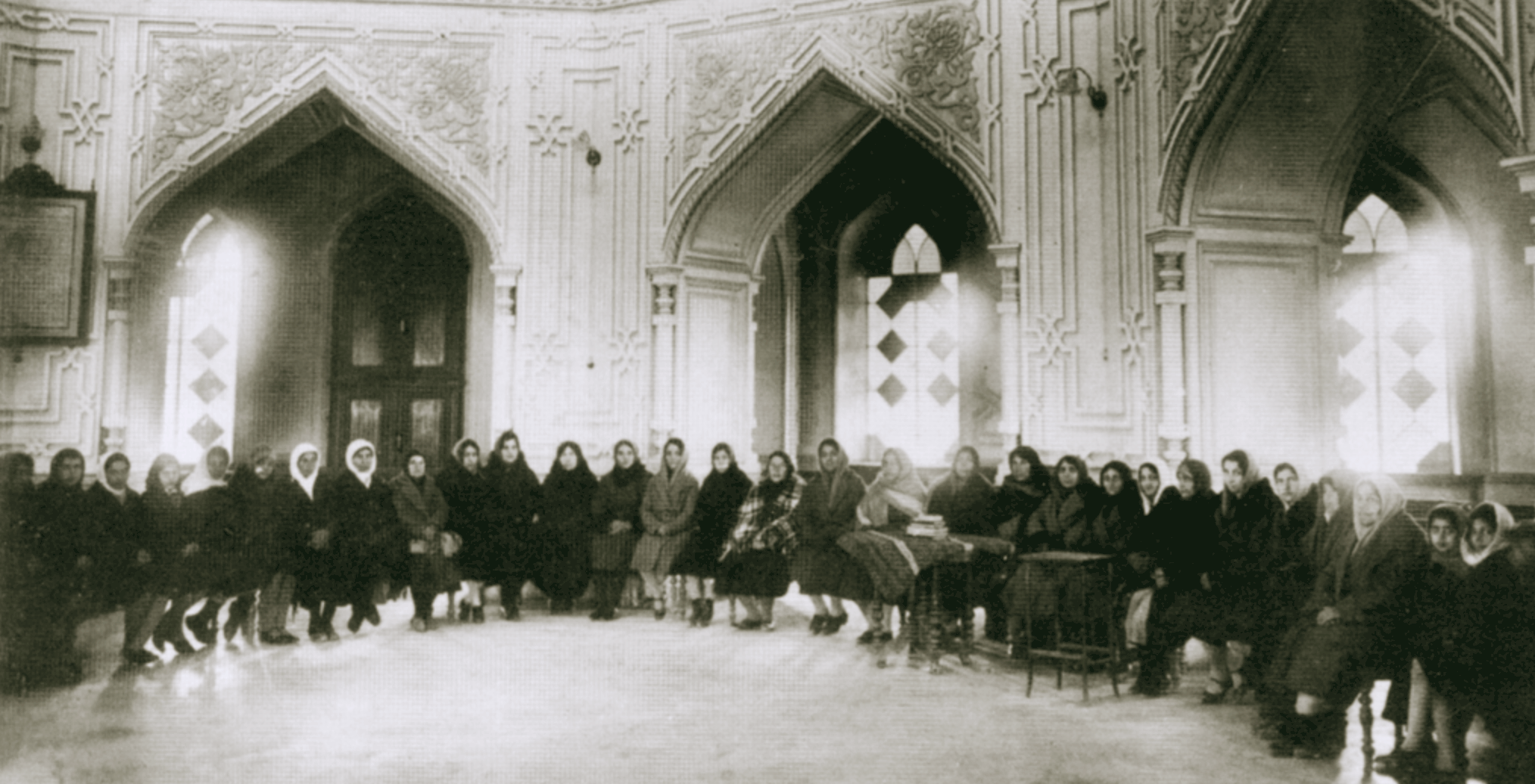
A women’s meeting inside the House of Worship in ‘Ishqábád, Turkmenistan, which was seized by the Soviet Union on 22 June 1928. The women and girls would take turns reading or chanting prayers. The exquisite interior of the Mashriqu’l-Adhkár is evident in this photograph. Source: Bahá'í Historical Facts.
‘Ishqábád, Turkmenistan was home to one of the oldest Bahá'í communities in the world after Persia, and many Persian Bahá'ís emigrated there at the end of the 19th century to enjoy a safe haven from the constant persecutions in their native land. Bahá'ís built the very first House of Worship in Bahá'í history under the guidance of 'Abdu'l-Bahá in ‘Ishqábád, opened Bahá'í schools and, by 1928, had elected several Local Spiritual Assemblies in ‘Ishqábád, Moscow and other cities in the Soviet Union and two Central Spiritual Assemblies.
By 1928, the Soviet Union was on its second anti-religious campaign, following the first which started in 1921 and ended in 1928, This second campaign would last from 1928 to 1941, and further the goals of replacing religion with agnosticism and atheism and a materialist world view, fundamental goals of the communist state. They wanted to erase religion, and the Bahá'ís were swept up in a blanket state policy. Until 1928, the Bolsheviks, who had assumed power in 1917, had allowed the Bahá'ís to carry on with their community activities, but under Stalin’s regime, starting in 1922, the Bahá'í community came under increasing pressure and later, open persecution.
This is the major way in which the persecution of Bahá'ís in the Soviet Union differs from persecution in Persia: they were not specifically targeted just because they were Bahá'ís, they were victims along with all other religious communities.
On 22 June 1928 Shoghi Effendi received a cable from the ‘Ishqábád Assembly as follows:
In accordance general agreement 1917 Soviet Government has nationalized all Temples but under special conditions has provided free rental to respective religious communities regarding Mashriqu’l-Adhkár government has provided same conditions agreement to Assembly supplicate guidance by telegram.
The Guardian took immediate action, cabling the Moscow Assembly to vigorously intercede with the Soviet authorities and prevent the expropriation of the House of Worship in ‘Ishqábád, and he instructed the Local Spiritual Assembly of Moscow to petition government authorities on behalf of the Bahá'ís of Russia.
Shoghi Effendi later explained in a long letter dated 1 January 1929 on this subject that the Russian Bahá'ís had been brought under the "rigid application of the principles already enunciated by the state authorities and universally enforced with regard to all other religious communities."
Shortly after 22 June 1928, the Soviet Union had—faithful to their anti-religious state policy—expropriated the House of Worship of ‘Ishqábád, suspended all Bahá'í meetings, suppressed all Bahá'í communities, Local and National Spiritual Assemblies, prohibited fund-raising, required frequent inspection of their meetings, imposed strict censorship on their correspondence, suspended all Bahá'í newsletters, and deported leading Bahá'ís and well-known Bahá'í speakers and Assembly officers.
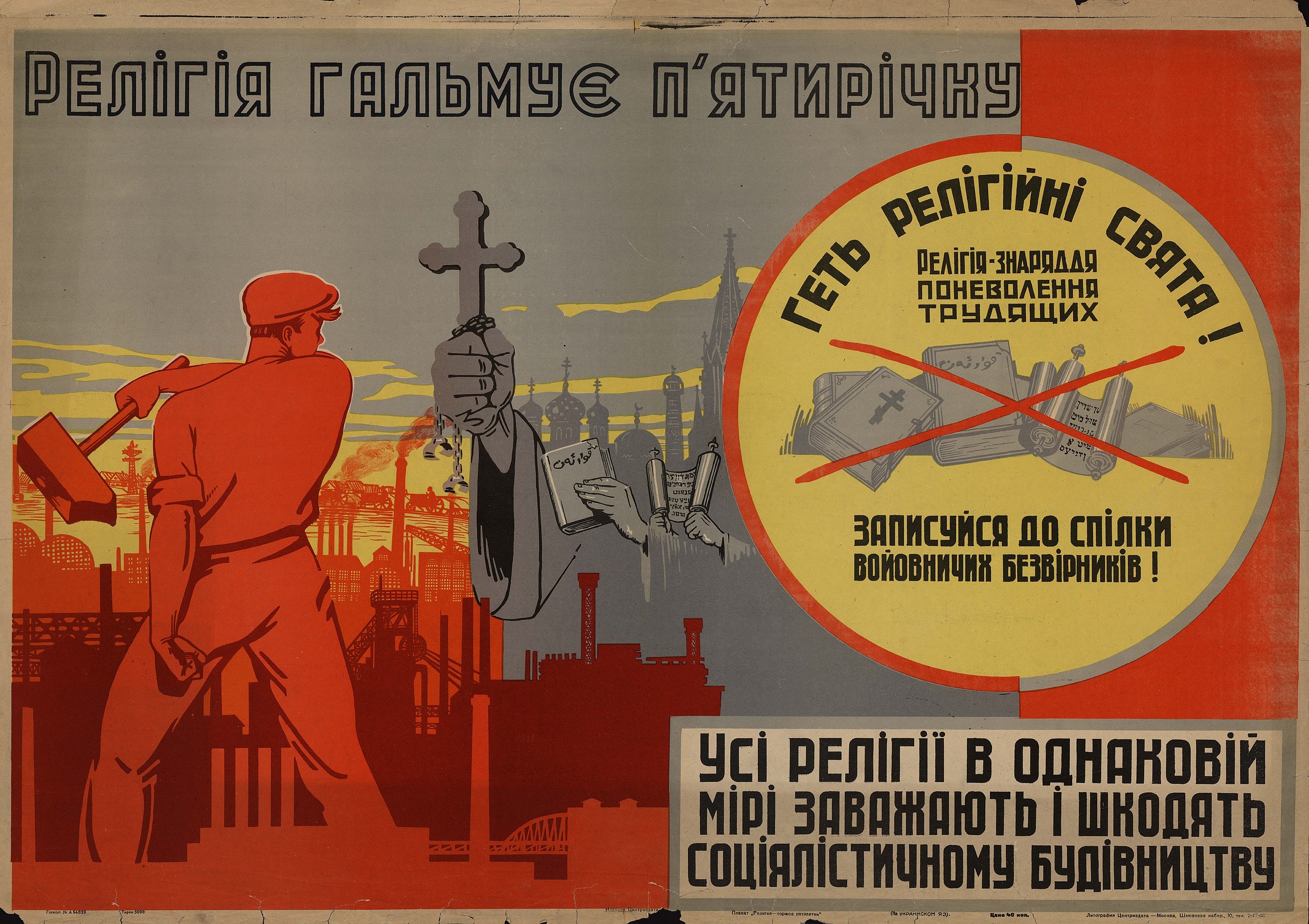
Soviet Union poster promoting their anti-religious campaign during which the House of Worship in ‘Ishqábád was seized. The poster reads: “Religion slows the five year plan! Down with religious holidays!” Source: Wikimedia Commons.
Shoghi Effendi went on to say that after the Bahá'ís in Turkistan and the Caucasus had unsuccessfully exhausted every legitimate means for the alleviation of these restrictions imposed upon them, they had resolved to “conscientiously carry out the considered judgment of their recognized government” and “with a hope that no earthly power can dim...committed the interests of their Cause to the keeping of that vigilant, that all-powerful Divine Deliverer...”
The Guardian described the Bahá'í community’s law-abiding response to these sanctions, which he describes as "measures which the State, in the free exercise of its legitimate rights, has chosen to enforce":
the followers of the Faith of Bahá'u'lláh have with feelings of burning agony and heroic fortitude unanimously and unreservedly submitted, ever mindful of the guiding principles of Bahá'í conduct that in connection with their administrative activities, no matter how grievously interference with them might affect the course of the extension of the Movement, and the suspension of which does not constitute in itself a departure from the principle of loyalty to their Faith, the considered judgment and authoritative decrees issued by their responsible rulers must, if they be faithful to Bahá'u'lláh's and 'Abdu'l-Bahá's express injunctions, be thoroughly respected and loyally obeyed.
Three months later, in September 1928, Shoghi Effendi wrote a letter to Martha Root in which he describes not only the events in the Soviet Union but their effect on him:
It has been a very depressing summer this year for me as the condition of the Cause in Russia is going from bad to worse. The Mashriqu’l-Adhkár has been appropriated by the State, closed and sealed. A very large sum is required from the friends if rented to them, otherwise they threaten to sell it to others in parts. The situation is very critical and many families have migrated to Persia. Meetings are suspended, Assemblies dissolved, heavy restrictions and penalties imposed...this and other happenings have made me feel very down-hearted and sad.
One thing the Guardian did not approve of was the return of the Russian Bahá'ís to Persia. He informed the ‘Ishqábád Assembly that "departure friends Iran exceedingly harmful." In the past, the Guardian had already encouraged Bahá'ís living in ‘Ishqábád to learn the language and publish literature in Russian, and in 1929, he encouraged them to obtain Russian citizenship if possible, weather the storm and stay strong at their post.
In April 1930, the Guardian launched a campaign to attempt to recover the House of Worship in ‘Ishqábád, which the Bahá'ís had succeeded in renting, but which it looked like they might soon lose for good. In the end, the Soviet government refused to concede, and Shoghi Effendi was forced to cable:
…abide by decision State Authorities.
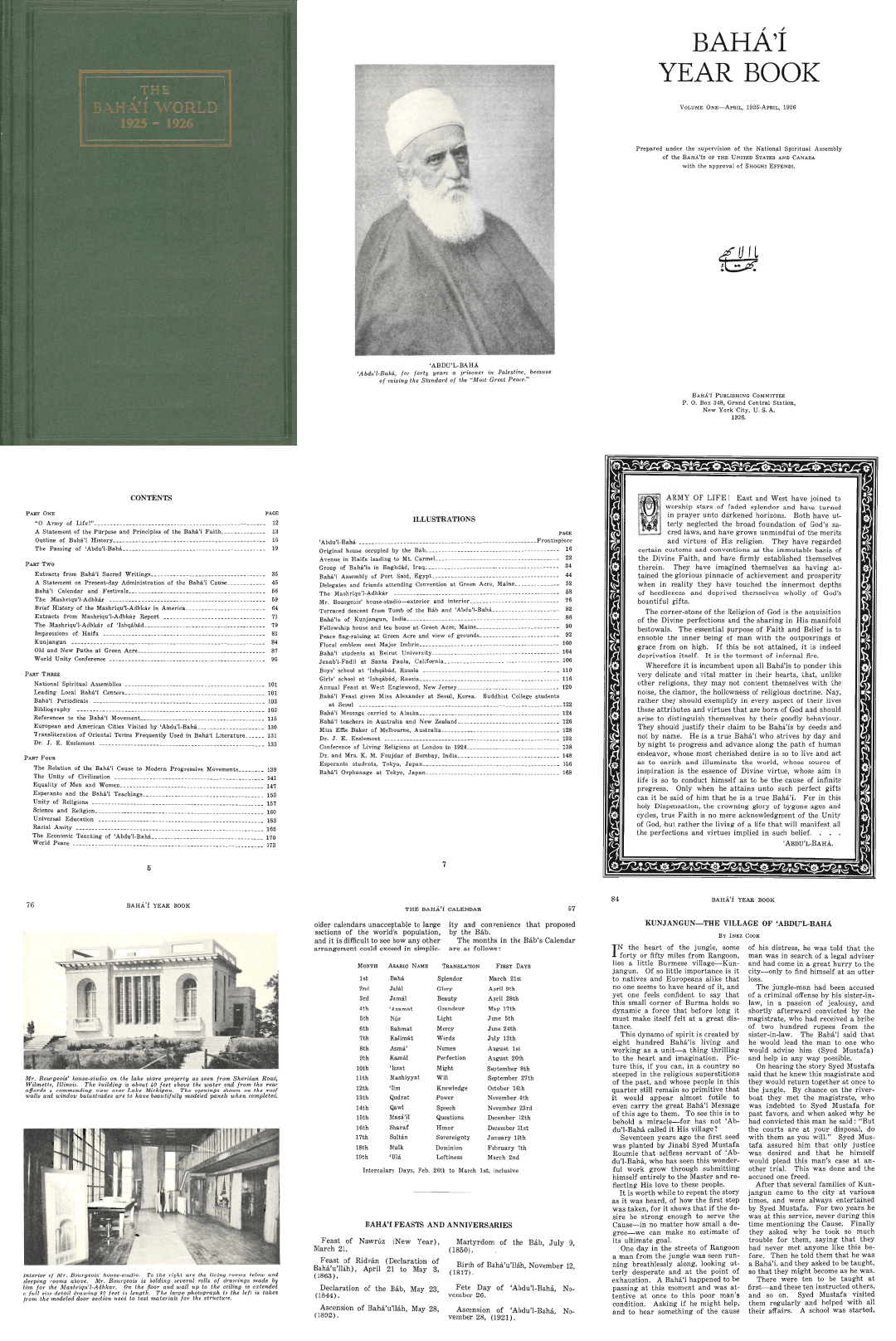
The Bahá'í World Volume 1: A sample of the extraordinary diversity of this publication, from rare photographs of the studio of Louis Bourgeois, the archictect of the Bahá'í House of Worship in North America, to an article about “'Abdu'l-Bahá’s village” in Burma, a useful Bahá'í calendar, etc.
The year after the publication of The Bahá'í World’s first volume covering the accomplishments of the Bahá'í community from 1925 to 1926, Shoghi Effendi had already expressed his attachment to the publication, writing to a person who was not Bahá'í:
I would strongly advise you to procure a copy of the Bahá'í Year Book…which will give you a clear and authoritative statement of the purpose, the claim and the influence of the Faith.
On 6 December 1928, Shoghi Effendi wrote a letter addressed to “the beloved of the Lord and the handmaids of the Merciful throughout the West,” and devoted, in its entirety, to the importance of The Bahá'í World. The Guardian enthusiastically described the publication and his commitment to and interest in it and emphasized its great value, encouraging all believers to widely circulate it. This is how Shoghi Effendi begins describing The Bahá'í World:
This unique record of world-wide Bahá’í activity attempts to present to the general public, as well as to the student and scholar, those historical facts and fundamental principles that constitute the distinguishing features of the Message of Bahá’u’lláh to this age. I have ever since its inception taken a keen and sustained interest in its development, have personally participated in the collection of its material, the arrangement of its contents, and the close scrutiny of whatever data it contains.
I confidently and emphatically recommend it to every thoughtful and eager follower of the Faith, whether in the East or in the West, whose desire is to place in the hands of the critical and intelligent inquirer, of whatever class, creed or color, a work that can truly witness to the high purpose, the moving history, the enduring achievements, the resistless march and infinite prospects of the Revelation of Bahá’u’lláh.
In the remainder of this letter, Shoghi Effendi calls The Bahá'í World eminently readable and attractive, reliable and authoritative, up-to-date, accurate, comprehensive, accurate, concise and persuasive, thoroughly illustrated, unexcelled and unapproached by any other publication, and capable of arousing unprecedented interest in the Faith among all strata of society.
The Guardian also sends out an earnest appeal to the worldwide Bahá'í community to a prompt and widespread dissemination of a book he describes as faithfully and vividly portraying the ”far-reaching ramifications and most arresting aspects” of the all-encompassing Faith of Bahá'u'lláh.
Shoghi Effendi had carefully designed The Bahá'í World to be suitable for the public, for scholars, and for libraries, and to combat malicious rumors and misrepresentations about the Faith.
He had wildly succeeded.
An American professor wrote back to Shoghi Effendi with enthusiastic gratitude at his gift of a volume of The Bahá'í World:
I cannot tell you how much I appreciate being able to study the book, which is exceedingly interesting and inspiring in every way…I congratulate you especially for developing the literature, and keeping alive such a wholesome spirit amongst the persons of many different groups who look to you for leadership.
One of Shoghi Effendi’s greatest tributes to the quality of this volume he so loved and was so invested in, were a series of special tributes to the Bahá'í Faith, written by a proud Queen Marie of Romania especially for The Bahá'í World. The Queen also gave permission for her photograph to appear as the frontispiece for Volume 5, and facsimiles of the Queen’s handwritten and signed appreciation for the Faith were published as frontispieces for Volumes 4, 6, and 8.
In 1931, when Shoghi Effendi received one of the Queen’s especially written tributes for publication in The Bahá'í World, he responded:
No words can adequately express my pleasure at the receipt of your letter enclosing the precious appreciation which will constitute a valuable and outstanding contribution to the forthcoming issue of the Bahá'í World.
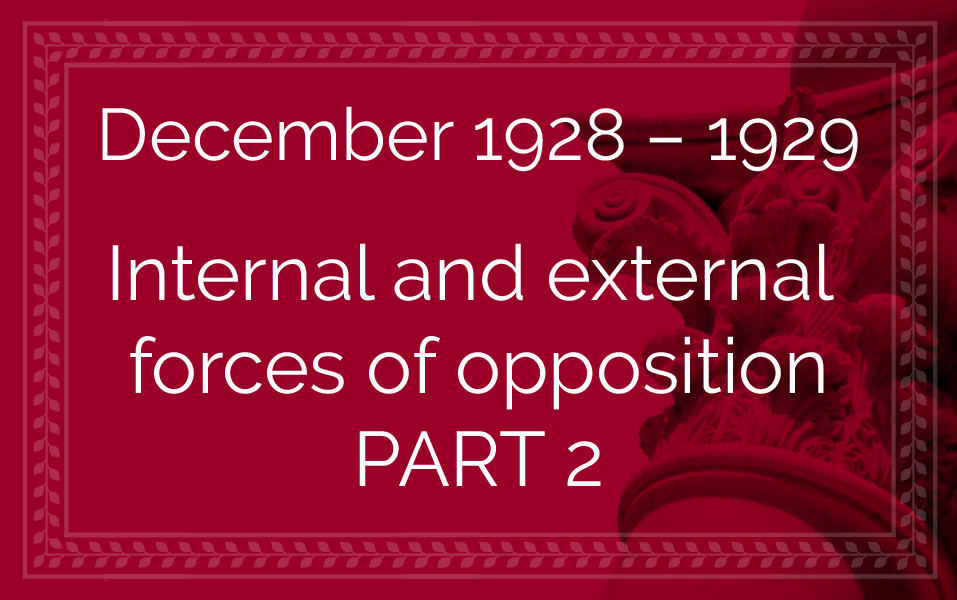
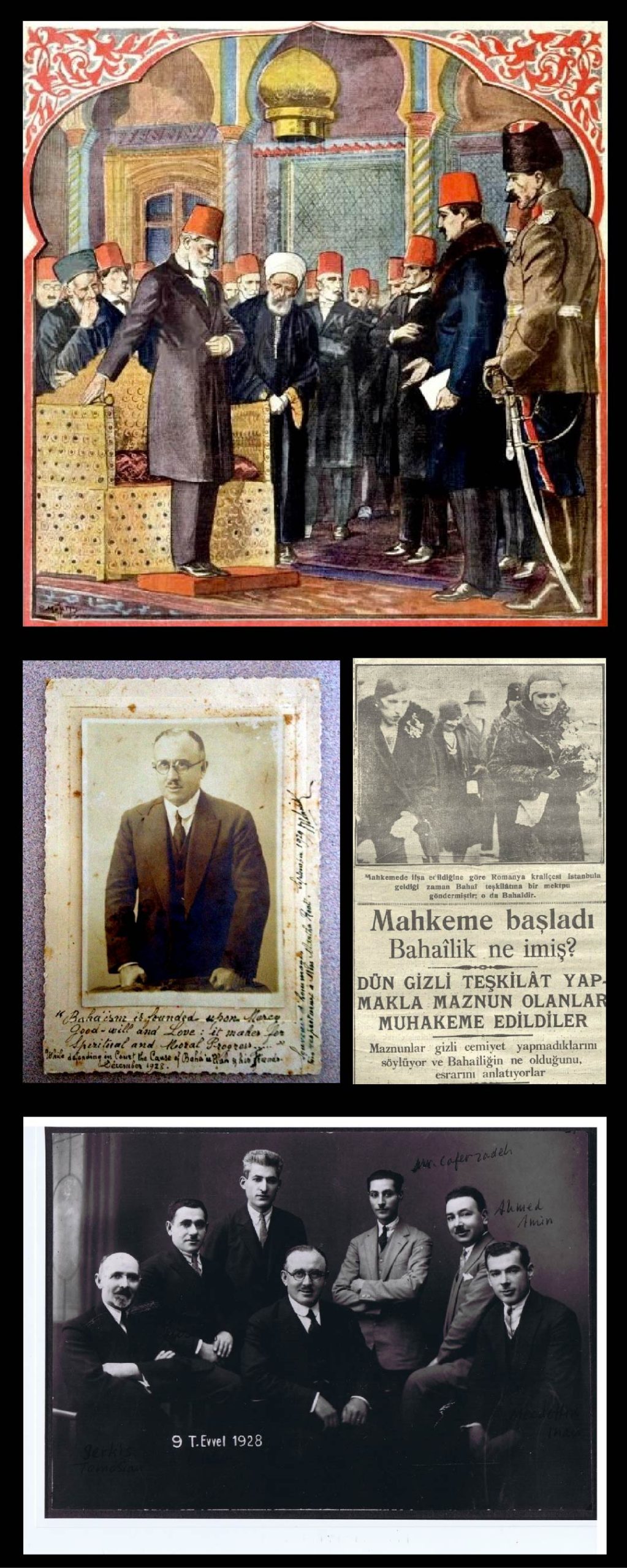
Top: One of Atatürk's many reforms, the abolition of the Caliphate, from Le Petit Journal illustré, 16 March 1924. Among the many other reforms of Atatürk were the Eliminating of religious “associations” from political arena, covered in the story below. Source: Wikimedia Commons. Left: A photo of Nuri Sadik Bey, the chairman of the Local Spiritual Assembly of Istanbul, while defending the Bahá'í Faith in Court. Source: The Martha Root Archives, National Spiritual Assembly of Hawaii (courtesy of Payam Afsharian via Dr. Necati Alkan). Used with permission. Right: Front page article from the Istanbul newspaper Milliyet dated 9 December 1928 about Queen Marie, the title reads: "The trial began: what is Baha’ism supposed to be? Yesterday those who set up a secret organization were tried." The caption of the photo of Queen Marie reads: "As was disclosed during the trial the Romanian Queen sent a letter to the Baha’i organization when she arrived in Istanbul; she also is a Bahá'í." Source: Dr. Necati Alkan.
Bottom: A photograph of the seven members of Local Spiritual Assembly of Istanbul, taken on 9 October 1928, the day they were arrested. Source: Mehrdad Mohregi via Dr. Necati Alkan, used with permission.
This section was a collaboration with the foremost specialist of the Bahá'í faith in the Ottoman Empire, Dr. Necati Alkan.
After the Young Turk Revolution in 1908, specifically after losing World War I in 1918, the Ottoman Empire fell apart and the Republic of Turkey was proclaimed in 1923, followed by an intense policy of secularization—separating Islam and state affairs—and wide-ranging civil reforms in 1928, which included removing Islam as the state religion in the Constitution and adopting the Latin alphabet for the Turkish language.
It came to the Turkish government’s attention that certain so-called religious groups had, in the past, provided cover for political agitators. They discovered that the Bahá'í Faith was not only an organized religion, but that it openly pursued its activities of teaching and propagating the Faith, and they became suspicious.
The Government searched the homes of Bahá'ís in Izmir (Smyrna) and Istanbul (Constantinople), seized all the literature they could find, questioned the believers and sent a number of them to prison. Some of the literature confiscated from the Local Spiritual Assembly of Istanbul were one of the tributes of Queen Marie of Romania to the Bahá'í Faith and her letter to the Bahá'ís of that city.
The case was widely reported in the European and of course the Turkish press, whose sympathy lay with the Bahá'í community, and the great deal of publicity ensured that the Bahá'ís were allowed a full and impartial hearing when the case reached the Criminal Tribunal on 13 December 1928.
This tribunal was a great step in the unfoldment of Baha’u’llah’s Cause, as Shoghi Effendi stated:
Never before in Bahá'í history have the follower of Bahá'u'lláh been called upon by the officials of a state…to unfold the history and principles of their Faith…
The President of the Local Spiritual Assembly of Istanbul was called on to explain the principles of the Faith, which he did brilliantly.
In the end, the Bahá'ís were found totally innocent and made to pay a fine of 25 Turkish Liras for not having registered their association with the government, and not having obtained proper authorization to hold public meanings.
The effects of this case, both locally and internationally, were deeply significant. The Faith had been publicly found to be a divine, independent, world religion. This was how the Guardian presented this historic verdict to the Bahá'ís of the West in his letter dated 12 February 1929:
As to the verdict…it is stated clearly that although the followers of Bahá'u'lláh, in their innocent conception of the spiritual character of their Faith, found it unnecessary to apply for leave for the conduct of their administrative activities and have thus been made liable to the payment of a fine, yet they have, to the satisfaction of the legal representatives of the State, not only established the inculpability of the Cause of Bahá'u'lláh, but have also worthily acquitted themselves of the task of vindicating its independence, its Divine origin, and its suitability to the circumstances and requirements of the present age.
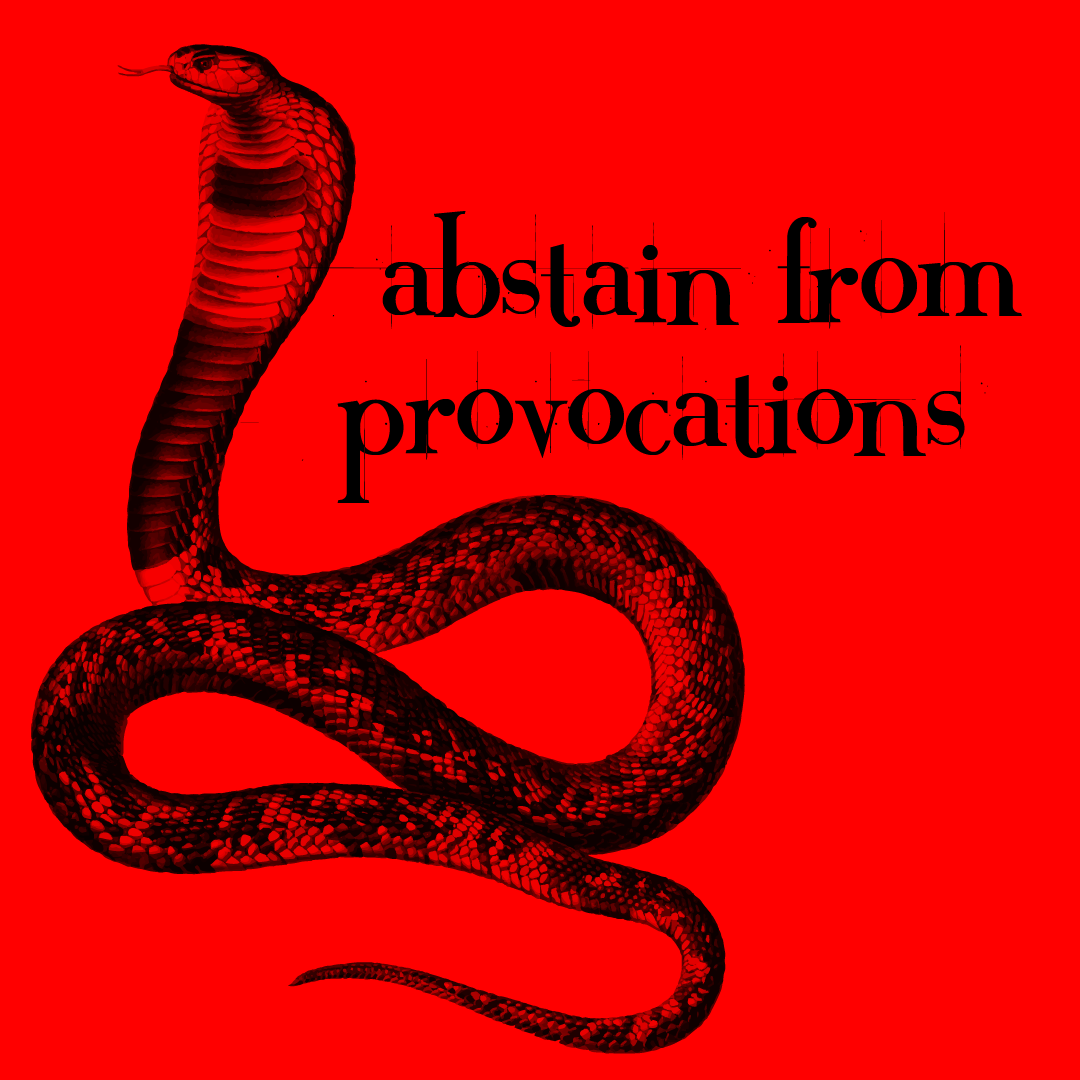
Shoghi Effendi categorically stated that the Will and Testament of 'Abdu'l-Bahá was authentic beyond the shadow of a doubt. It had been authentified several times by several people, so many people still alive in 1930 knew 'Abdu'l-Bahá’s handwriting by heart, and recognized his seals.
Ruth White, the most notorious American Covenant-breaker, threw herself into her lunacy.
She wrote countless letters to the National Spiritual Assembly of the Bahá'ís of the United States and Canada, as well as to some believers, in which she vehemently objected to the directives of Shoghi Effendi and the administration of the Cause through the local and national institutions.
She wrote to the United States Postmaster General, asking him to prohibit the National Spiritual Assembly of the United States and Canada from using the United States Postal Service to, in her words:
To spread the falsehood that Shoghi Effendi is the successor of 'Abdu'l-Bahá and Guardian of the Bahá'í Cause.
On 31 December 1928, Ruth White wrote to the civil authorities in Palestine, and made an official request that they declare the Will and Testament of 'Abdu'l-Bahá a forgery.
This caused the Guardian unneeded worry at a time where he was already overburdened with work and stress.
In January 1929, the National Spiritual Assembly of the United States and Canada forwarded the Guardian a pamphlet published by Ruth White and on 27 February 1929 the Guardian responded, writing :
I have in a letter addressed to the National Assembly set forth my views regarding the contents of Ruth White’s pamphlet. I have thus far received no intimation from the Palestine authorities, and have no reason to believe that they will consider it worthy of their consideration. The friends, however, should avoid hurting her feelings and should abstain from provocation.
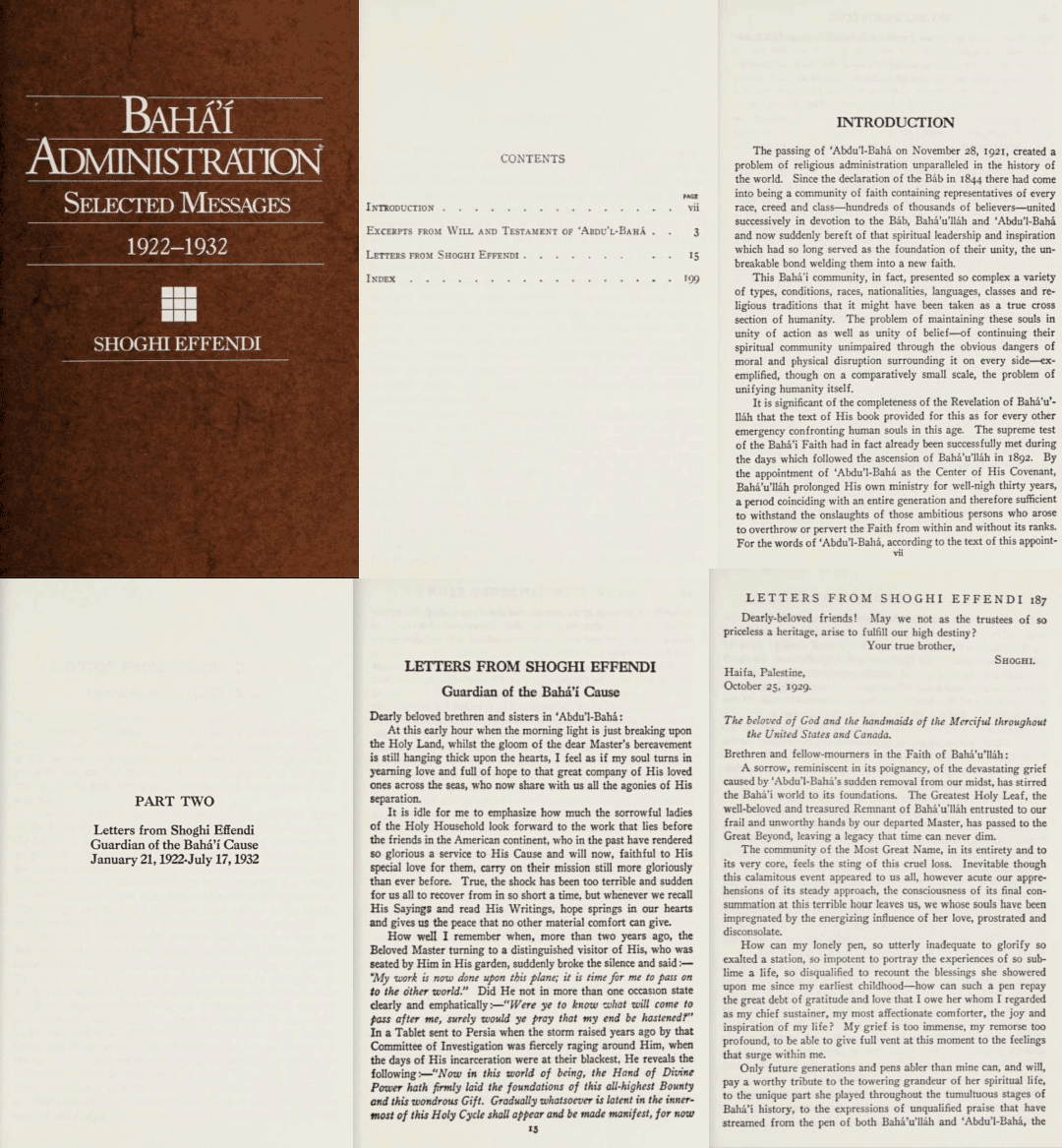
Images of the cover, table of content, first page of Horace Holley’s introduction, part 2 containing the letters of the Guardian, the first page of the first letter dated 21 January 1922, and the first page of the last letter dated 17 July 1932. Source: Internet Archive.
Bahá’í Administration was the very first compilation of Shoghi Effendi’s letters to ever be published in 1928. The compilation was revised twice and its current form is the 1941 publication and covers a period of ten years of letters from Shoghi Effendi addressed to the Bahá'ís of the United States and Canada from 21 January 1922 to 11 April 1933.
In the first letter included in Bahá'í Administration, dated two months after the Ascension of 'Abdu'l-Bahá, Shoghi Effendi expresses his deep sorrow at the passing of the Master, describing it as a “shock…too terrible and sudden for us all to recover from in so short a time.”
The last letter in the compilation, dated 11 April 1933 and titled Personalities Subordinated discusses various considerations regarding the delicate issue of removing voting rights.
After the book was published in its last edition Shoghi Effendi, in a letter written to a National Assembly on his behalf, made the following comment about its importance:
Two years after its publication, the Guardian suggested to the National Spiritual Assembly India that it carefully deepen itself on all the ramifications of the Bahá'í Administrative Order by studying Bahá'í Administration in a letter dated 9 may 1934:
The Guardian would strongly urge each and every member of the National Spiritual Assembly to carefully peruse, and to quietly ponder upon the outer meaning and upon the inner spirit as well, of all his communications on the subject of the origin, nature and present-day functioning of the administrative order of the Faith. A compilation of these letters has been lately published in the States under the title 'Bahá'í Administration', and a complete knowledge of that book seems to be quite essential to the right handling of the administrative problems facing your National Spiritual Assembly at present.
This majestic excerpt from Bahá'í Administration, from a letter dated Letter of 24 September 1924 is from a section of that letter called Our Inner Life, and it exemplifies the Guardian’s writing at its best, at its most momentous as it calls Bahá'ís, though few in number, to the greatest heights of heroism:
Humanity, through suffering and turmoil, is swiftly moving on towards its destiny; if we be loiterers, if we fail to play our part surely others will be called upon to take up our task as ministers to the crying needs of this afflicted world.
Not by the force of numbers, not by the mere exposition of a set of new and noble principles, not by an organized campaign of teaching – no matter how worldwide and elaborate in its character – not even by the staunchness of our faith or the exaltation of our enthusiasm, can we ultimately hope to vindicate in the eyes of a critical and sceptical age the supreme claim of the Abhá Revelation. One thing and only one thing will unfailingly and alone secure the undoubted triumph of this sacred Cause, namely, the extent to which our own inner life and private character mirror forth in their manifold aspects the splendor of those eternal principles proclaimed by Bahá’u’lláh.
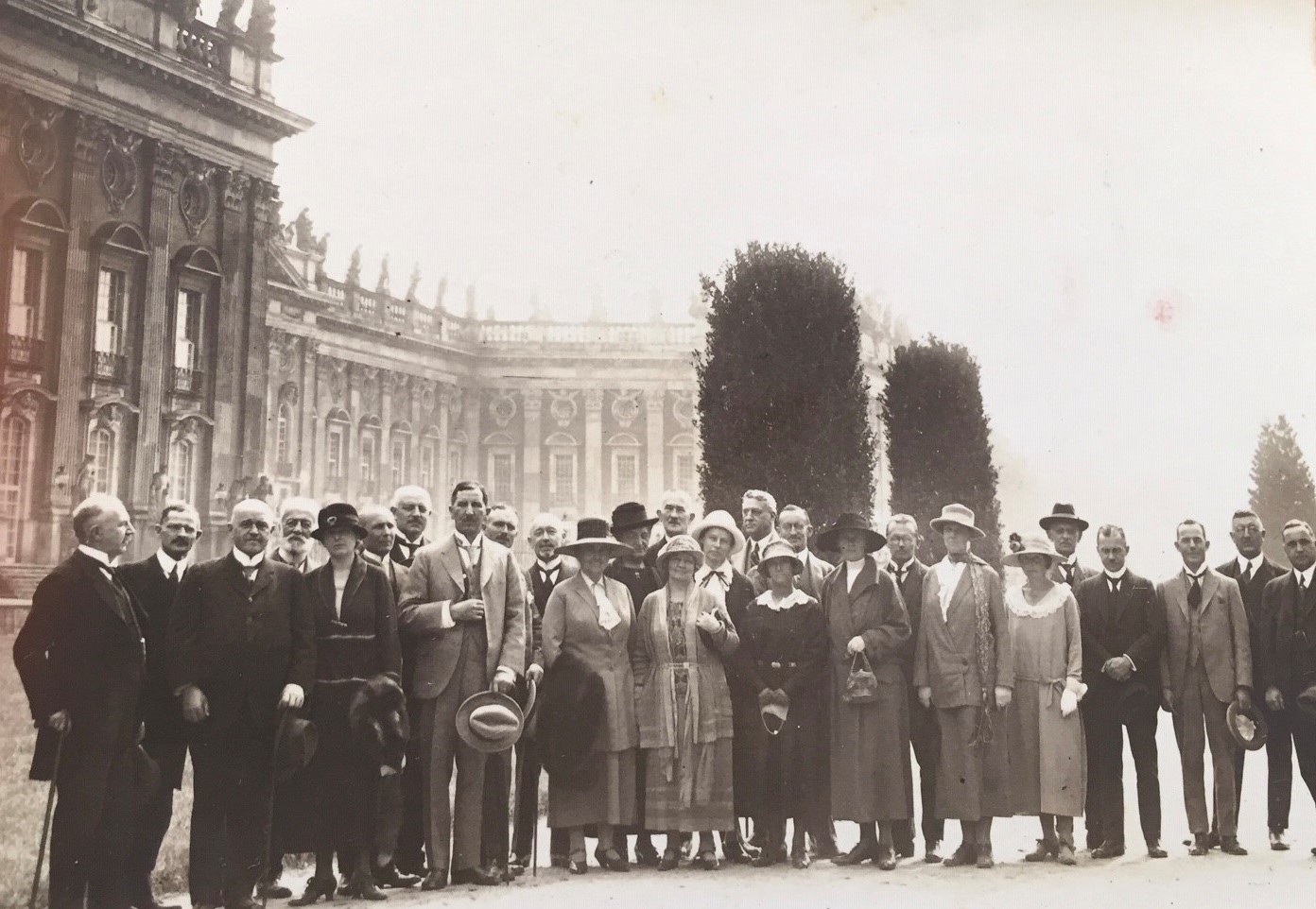
The Permanent Mandates Commission in Geneva in 1924. Source: Wikimedia Commons.
Shoghi Effendi never rested until the case of the Most Great House was brought before the League of Nations. On 11 September 1928, the National Spiritual Assembly of the Bahá’ís of Iraq submitted a petition to the Permanent Mandates Commission of the League of Nations in Geneva, Switzerland, for the return of the House of Bahá’u’lláh in Baghdád, a petition which reads, in part, that one of the most Holy Places of the Bahá'í community:
…has been unlawfully wrested from their possession and they have been deprived of the spiritual solace and inspiration of its use in their worship. This it is alleged has been brought about through the machinations of the leaders of the Shí‘ah sect of Islám…It is against this alleged violation of their constitutional treaty guarantees that your petitioners seek your aid and protection.
Between 26 October and 13 November 1928, the case of the Most Great House of Bahá’u’lláh in Baghdád was taken before the fourteenth session of the Permanent Mandates Commission of the League of Nations, where it was accepted and approved.
The British Government issued a memorandum unequivocally stating that the Shí’ah had "no conceivable claim whatever" to the Most Great House, and that the decision of the judge of the Iraqi tribunal was not only "obviously wrong," but "unjust" and "undoubtedly actuated by religious prejudice."
Three months after what seemed to be a permanent victory, Shoghi Effendi sent a short cable in February 1929, but asked not to give the victory much publicity:
League Council pronounced in favor Bahá'í Petition regarding Bahá'u'lláh House. Faith triumphant over deadliest enemy. Inform believers. Avoid for present widespread publicity. Cause much indebted to Mountfort's magnificent achievement.
On 4 March 1929, The Council of the League of Nations adopted the conclusion reached by the Mandates Commissions upholding the claim of the Bahá’í community to the Most Great House of Bahá’u’lláh in Baghdád. The Mandates Commission recommended that the Council of the League of Nations request the British Government to address the injustice suffered by the National Spiritual Assembly of Iraq in the case of the Most Great House directly with the Iraqi Government.
But the next month, in April 1929, King Faisal, a Sunní, caved under the pressure applied by the Shí’ah who threatened unrest, and the Most Great House was not returned to the Bahá’ís.
The matter was far from resolved.
In November 1929, the case of the Most Great House was again brought before the sixteenth session of the Permanent Mandates Commission of the League of Nations which received a petition drafted by Mountford Mills.
The right of the Bahá’ís to the House was upheld and the government of Iraq was strongly pressed to find a solution but the Most Great House was still not returned to the Bahá'ís.
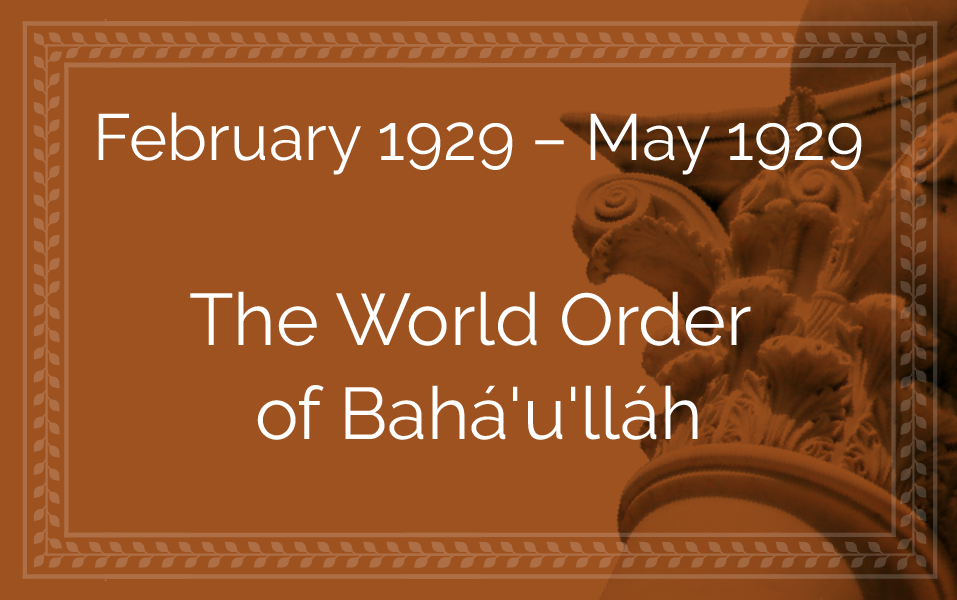
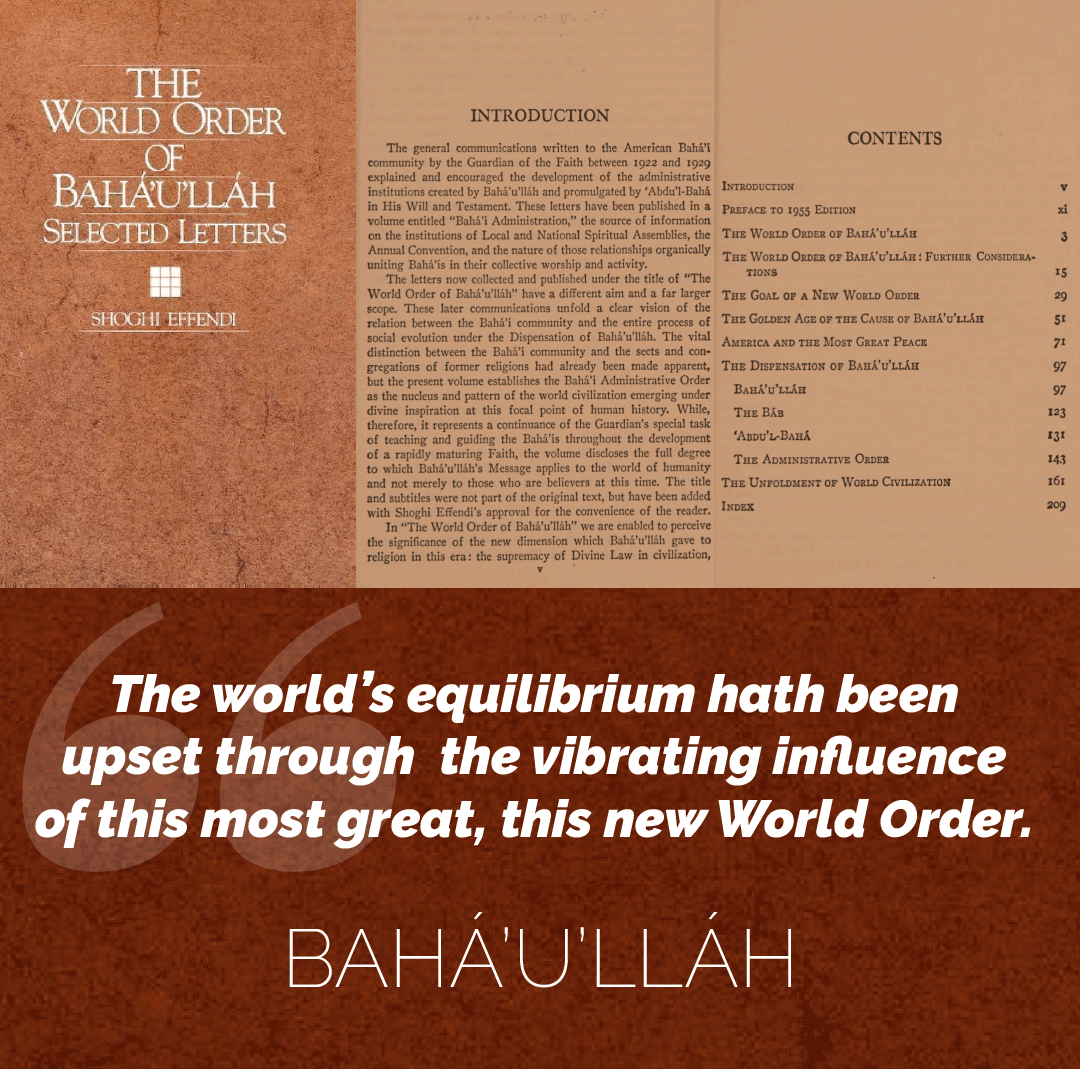
In the middle of the Great Depression, Shoghi Effendi published two very important compilations of letters addressed to the Bahá'ís of the United States and Canada and other western countries in a compilation. The first was The World Order of Bahá'u'lláh, published on 27 February 1929.
The following year, on 21 March 1930, the Guardian updated the compilation and released it under the title The World Order of Bahá'u'lláh: Further Considerations.
In these dark hours of worldwide economic chaos, disrupting the very foundations of the Old World Order, the Guardian felt the time had come to explain to the Bahá'ís of the West not only the sources, but the broad outlines of the New World Order ushered in by Bahá'u'lláh.
The aim of these two compilations was to clarify the meaning and purpose of the Bahá'í Faith, its beliefs, its implications, its destiny and its future, in order to guide the Bahá'í communities in North America and in the West to a better understanding of their duties and privileges and their destiny, while the Guardian led the unfoldment of Bahá'u'lláh’s Administrative Order.
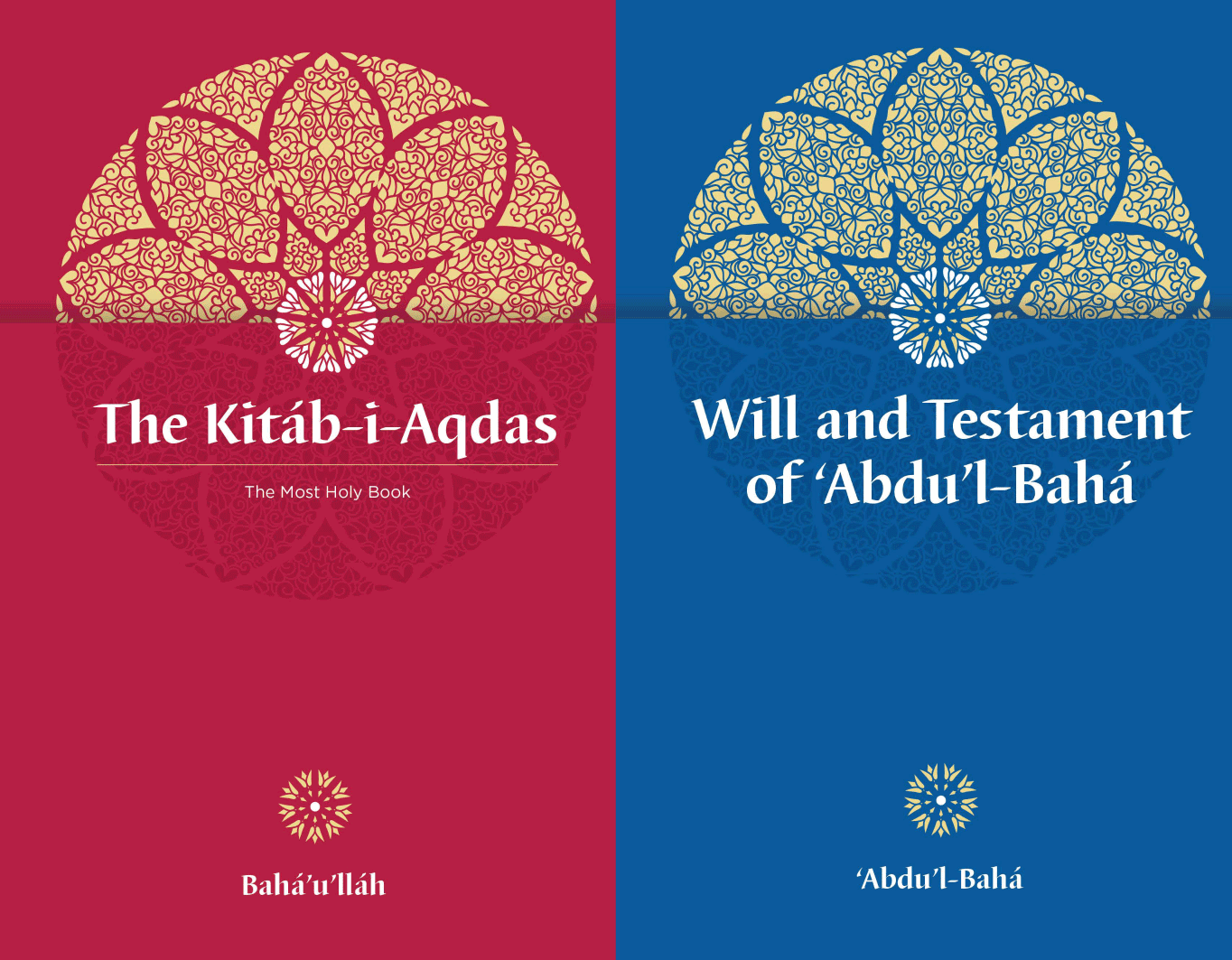
One of the ways in which Shoghi Effendi did this was to call the Bahá'ís’ attention to the commonalities between the Kitáb-i-Aqdas and the Will and Testament of 'Abdu'l-Bahá, respectively authored by the Founder of the Bahá'í Dispensation and the Center of the Covenant of Bahá'u'lláh’s Faith.
Shoghi Effendi, the authorized interpreter of the Bahá'í Holy Writings, made seven extraordinary statements regarding the intertwined relationship between Bahá'u'lláh’s Kitáb-i-Aqdas and the Will and Testament of 'Abdu'l-Bahá:
- Together, they constituted “the chief depository wherein are enshrined those priceless elements of that Divine Civilization, the establishment of which is the primary mission of the Bahá’í Faith.”;
- They both had the same purpose
- They both had identical provisions for successorship—Bahá'u'lláh expressly naming 'Abdu'l-Bahá as His successor, and 'Abdu'l-Bahá explicitly naming Shoghi Effendi as His;
- The Will and Testament, in the Guardian’s own words, “confirms…the provisions of the Aqdas.”
- It also “supplements” these same provisions;
- In the same sentence, the Guardian states that 'Abdu'l-Bahá’s Will and Testament “correlates the provisions of the Aqdas.”
- In Shoghi Effendi’s words, the Will and Testament of 'Abdu'l-Bahá and the Kitáb-i-Aqdas were “inseparable parts of one complete unit.”
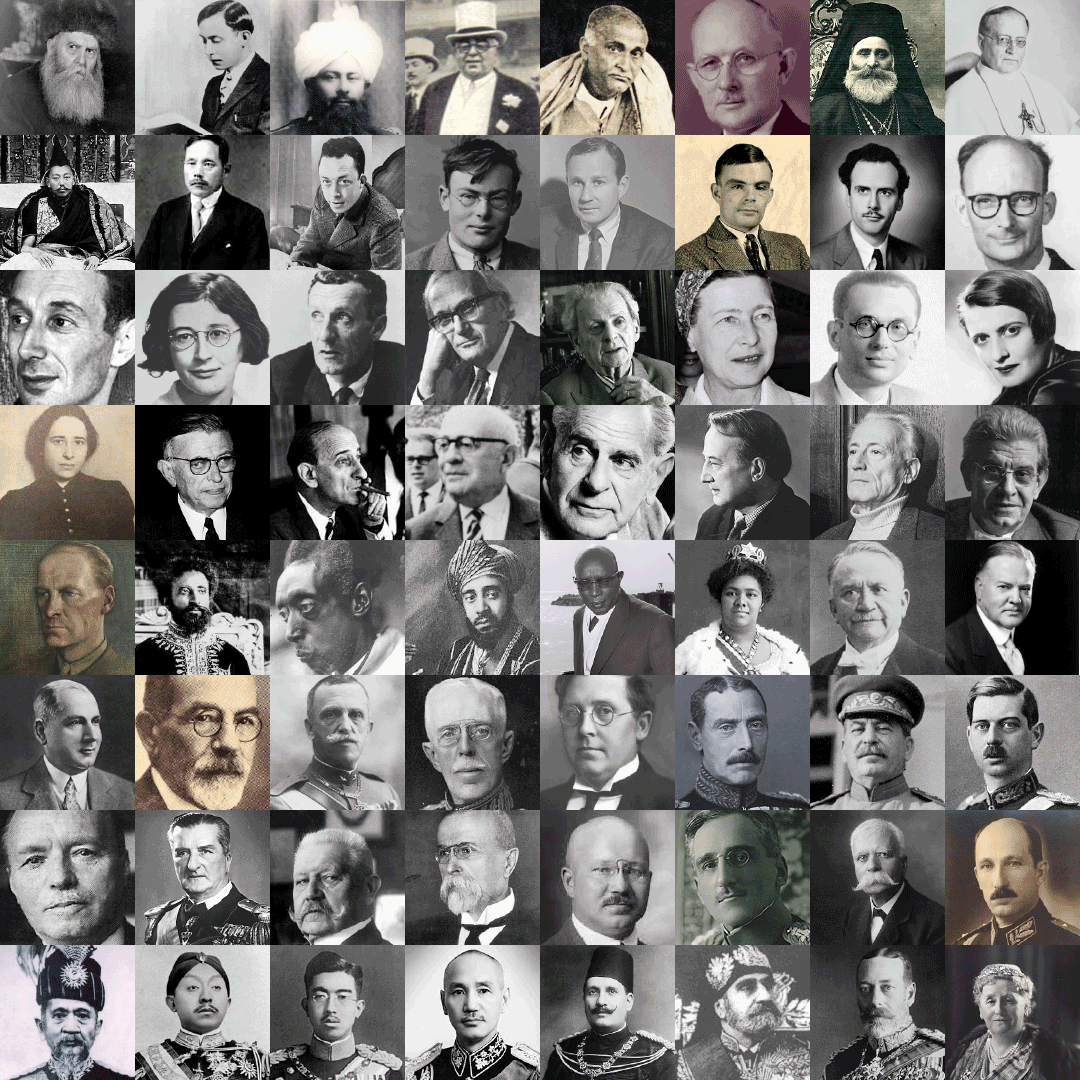
A photomontage of 64 of the world’s leaders in 1930, when Shoghi Effendi referred to them in a letter in the World Order of Bahá'u'lláh. Sources: World’s religious leaders in 1930 (Wikipedia), Philosophers of the world in 1930 (Wikipedia), Kings, Queens, and Presidents of the world in 1930 (Wikipedia).
This excerpt from The World Order of Bahá'u'lláh lays out in elevated and sublime terms the Revelation of Bahá'u'lláh and his New World Order as the last hopes for a fledgling humanity, and the heavy responsibility that rests on the small band of His devoted followers:
Leaders of religion, exponents of political theories, governors of human institutions, who at present are witnessing with perplexity and dismay the bankruptcy of their ideas, and the disintegration of their handiwork, would do well to turn their gaze to the Revelation of Bahá’u’lláh, and to meditate upon the World Order which, lying enshrined in His teachings, is slowly and imperceptibly rising amid the welter and chaos of present-day civilization. They need have no doubt or anxiety regarding the nature, the origin or validity of the institutions which the adherents of the Faith are building up throughout the world. For these lie embedded in the teachings themselves, unadulterated and unobscured by unwarrantable inferences, or unauthorized interpretations of His Word.
How pressing and sacred the responsibility that now weighs upon those who are already acquainted with these teachings! How glorious the task of those who are called upon to vindicate their truth, and demonstrate their practicability to an unbelieving world! Nothing short of an immovable conviction in their divine origin, and their uniqueness in the annals of religion; nothing short of an unwavering purpose to execute and apply them to the administrative machinery of the Cause, can be sufficient to establish their reality, and insure their success. How vast is the Revelation of Bahá’u’lláh! How great the magnitude of His blessings showered upon humanity in this day! And yet, how poor, how inadequate our conception of their significance and glory! This generation stands too close to so colossal a Revelation to appreciate, in their full measure, the infinite possibilities of His Faith, the unprecedented character of His Cause, and the mysterious dispensations of His Providence.
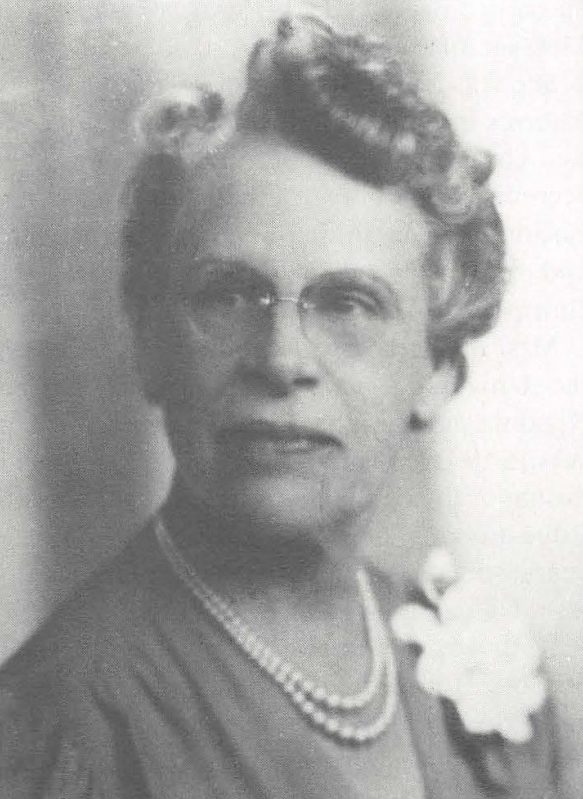
In a letter to Mary Maxwell dated 8 March 1929, May Maxwell shares the five steps for prayer and meditation which Ruth Moffet had heard from Shoghi Effendi during her pilgrimage, and which she widely disseminated. These, of course are pilgrim notes, and not to be considered as having the same weight as letters from Shoghi Effendi.
Step 1
Pray and meditate about it. Use the prayers of the Manifestations as they have the greatest power. Then remain in the silence of contemplation for a few minutes.
Step 2
Arrive at a decision and hold this. This decision is usually born during the contemplation. It may seem almost impossible of accomplishment but if it seems to be as answer to a prayer or a way of solving the problem, then immediately take the next step.
Step 3
Have determination to carry the decision through. Many fail here. The decision, budding into determination, is blighted and instead becomes a wish or a vague longing. When determination is born, immediately take the next step.
Step 4
Have faith and confidence that the power will flow through you, the right way will appear, the door will open, the right thought, the right message, the right principle or the right book will be given you. Have confidence, and the right thing will come to your need. Then, as you rise from prayer, take at once the fifth step.
Step 5
Then, he said, lastly, ACT; Act as though it had all been answered. Then act with tireless, ceaseless energy. And as you act, you, yourself, will become a magnet, which will attract more power to your being, until you become an unobstructed channel for the Divine power to flow through you. Many pray but do not remain for the last half of the first step. Some who meditate arrive at a decision, but fail to hold it. Few have the determination to carry the decision through, still fewer have the confidence that the right thing will come to their need. But how many remember to act as though it had all been answered? How true are those words-"Greater than the prayer is the spirit in which it is uttered" and greater than the way it is uttered is the spirit in which it is carried out.
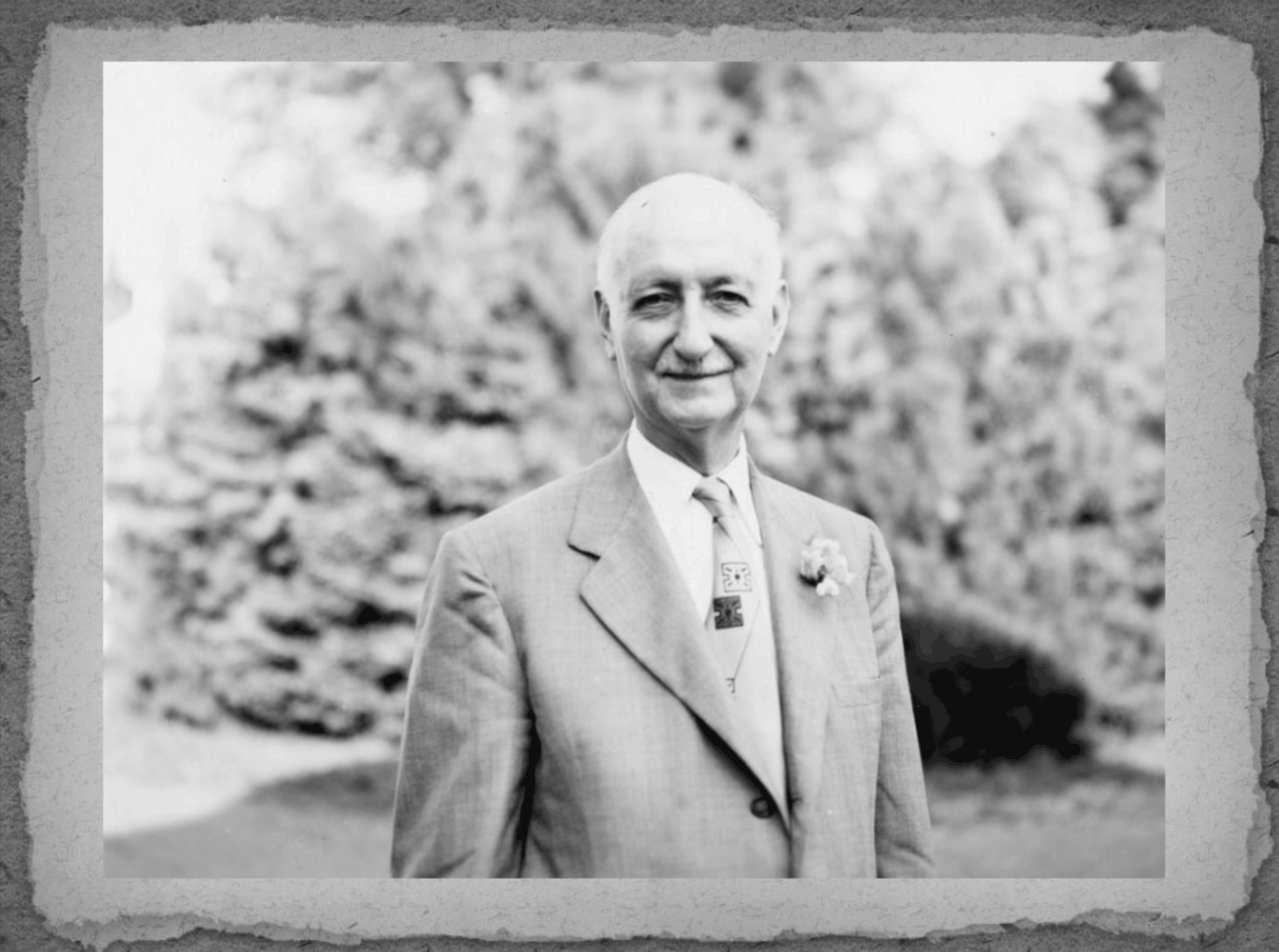
The talented Horace Holley, secretary of the National Spiritual Assembly of the United States and Canada from 1925 until 1959 (except for a brief period). He was a well-known poet, essayist, playwright, businessman, and thinker. He played a. pivotal role in the development of the Administrative Order and became known for his writings. Source: Wilmette Institute.
Horace Holley, the Secretary of the National Spiritual Assembly of the United States and Canada, was a talented writer, and, the Guardian allowed him to use his considerable talent to give titles to his epoch-defining letters from 1929 to 1957.
Horace Holley’s service in titling not only the Guardian’s letters, but the sections within the letters, served to not only identify his letters, but also dramatize Shoghi Effendi’s message, and capture the imagination of Bahá'ís.
The way Horace Holley titled the letters was to pick up the most stunning and appropriate turns of phrases used by the Guardian that could describe either the general subject of the entire letter or that specific thematic part.
In all his historic, epoch-defining letters from 1929 to 1957, it was Horace Holley, with the Guardian’s approval, who gave them their distinctive titles and subtitles, always excerpted from the words of Shoghi Effendi himself.
Horace Holley provided this service for the letters below:
- 1929: The World Order of Bahá'u'lláh
- 1930: The World Order of Bahá'u'lláh Further Considerations
- 1931: The Goal of a New World Order
- 1932: The Golden Age of the Cause of Bahá’u’lláh
- 1933: America and the Most Great Peace
- 1934: The Dispensation of Bahá’u’lláh
- 1936: The Unfoldment of World Civilization
- 1938: The Advent of Divine Justice
- 1941: The Promised Day Is Come
- 1957: Messages to the Bahá'í World: 1950-1957
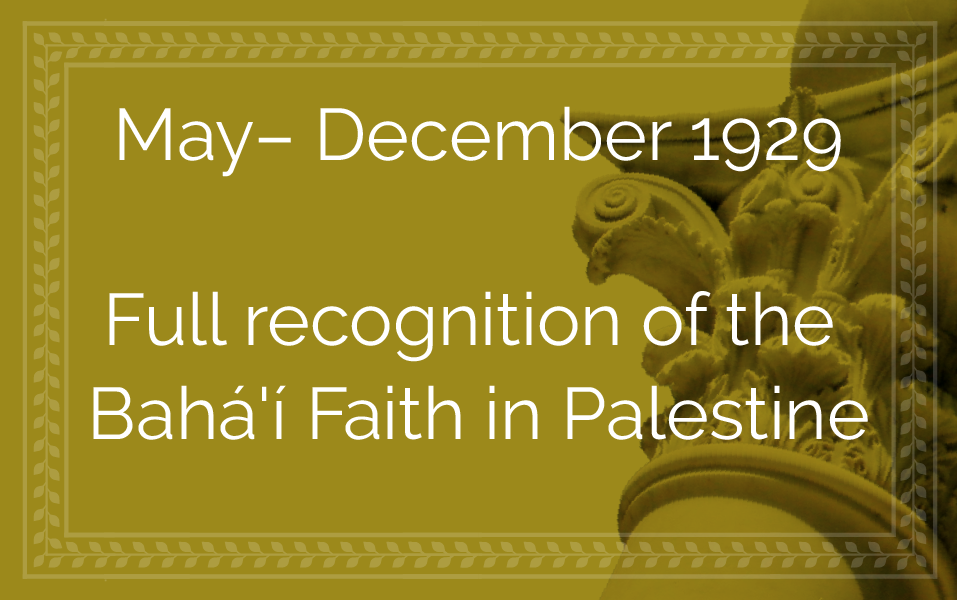
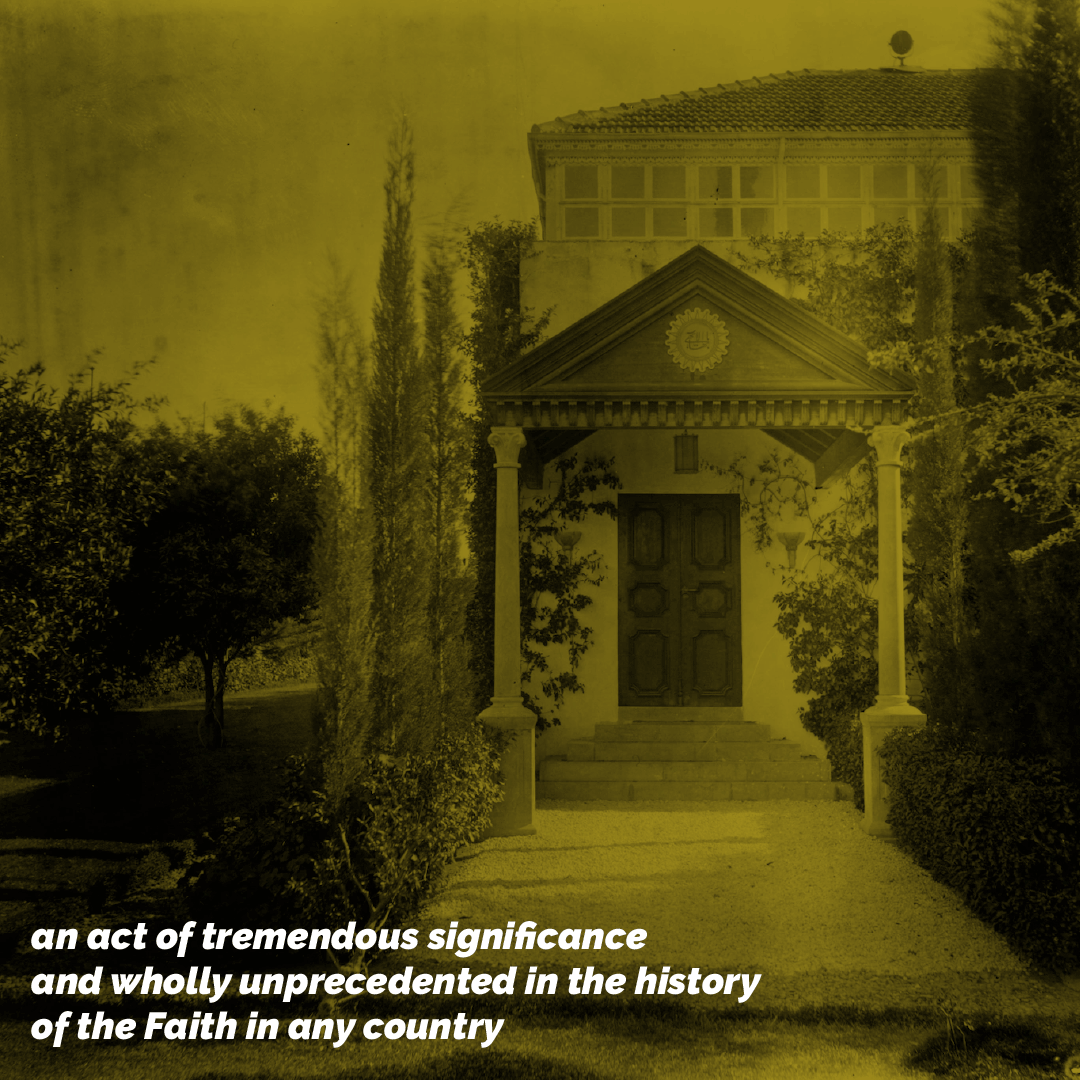
In the Holy Land, Bahá'ís already had a Bahá'í cemetery, and buried their dead facing the Qiblih, the Shrine of Bahá'u'lláh in Bahjí. The community had stopped referring to an Islamic court for all questions of marriage, divorce and the rites of burial, but it was time for this practice to become official.
On 4 May 1929, Shoghi Effendi presented a formal petition from the representatives of the Bahá'í community of Haifa to the government of British Mandate Palestine requesting permission for the Bahá'í community to administer the affairs of the community according to Bahá'í law in matters of civil law such as marriage, divorce, burial laws, pending the adoption of a uniform code of civil law in Palestine.
This petition asked for the Bahá'í community to be fully recognized and be granted “full powers to administer its own affairs now enjoyed by other religious communities in Palestine.”
The petition was granted, and the Bahá'í Faith received official recognition by the civil authorities. Their marriage certificates, issued by the local Bahá'í communities were now valid, something which even the Persian Government’s representative in Palestine tacitly recognized.
The Bahá'í community was now on equal legal footing with Jewish, Muslim and Christian communities in Palestine.
Shoghi Effendi hailed this decision as "an act of tremendous significance and wholly unprecedented in the history of the Faith in any country".
The Guardian's own exclusively Bahá'í marriage to Rúḥíyyih Khánum, eight years later, would be registered and become legal as a result of this recognition he had won for the Faith.
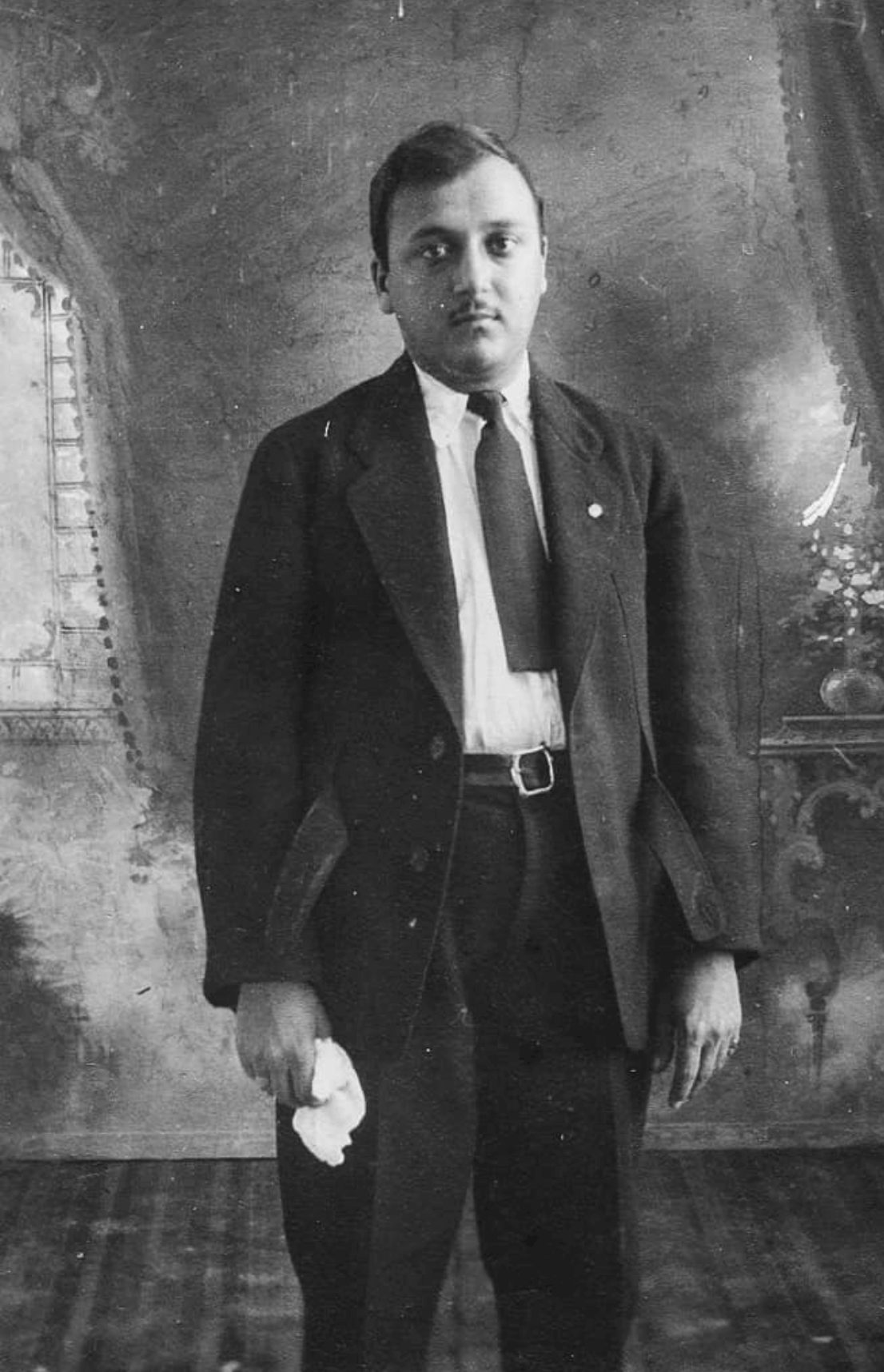
Shoghi Effendi standing in a suit, holding a handkerchief.
In 1929, an Indian Bahá'í pilgrim Shoghi Effendi brilliantly characterized one aspect of Shoghi Effendi, the various intensities of his energy and speed, and in this brief description, gives us an understanding of the immense dynamic strength of the Guardian:
We must understand Shoghi Effendi in order to be able to help him accomplish the stupendous task he has entrusted to us. He is so calm and yet so vibrant, so static and yet so dynamic.

After 'Abdu'l-Bahá’s Ascension, Ahmad Sohrab—who had been His secretary for many years and had traveled with the Master to Europe and Egypt—broke the Covenant—though he would not be declared a Covenant-breaker until 1939—and revealed who he had always been. In his opposition to the Faith, Ahmad Sohrab was as despicable as Avárih, and, before long, faithful Bahá'ís began calling Ahmad Sohrab “The Avárih of the West.”
They were both very prominent in their circles—Avárih in the East and Ahmad Sohrab in the West—and they both wanted the Universal House of Justice elected immediately. And they both wanted to be on it.
As the Guardian began building up the Administrative Order, guiding communities to elect Local Spiritual Assemblies and National Spiritual Assemblies and strengthening these nascent institutions, Ahmad Sohrab rose up against the direction the Guardian was taking the Bahá'í Faith in.
Ahmad Sohrab allied himself with a wealthy woman, Julie Chanler, and in 1929, they created a new organization called “The New History Society,” making a lot of noise and drumming up a lot of publicity to recruit members. Their end goal was to use the indirect method to spread the teachings of the Bahá'í Faith for their own advantage, while, of course simultaneously attacking the Guardian’s directives on building the Administrative Order.
What Ahmad Sohrab did was create a sect of the Bahá'í Faith.
He shamelessly plagiarized the words of Bahá'u'lláh and 'Abdu'l-Bahá as his own, and alienated the Bahá'í community.
Ahmad Sohrab was very strange. He never questioned the authenticity of the Will and Testament of 'Abdu'l-Bahá, but he criticized the Guardian’s leadership and his decisions and stated that Shoghi Effendi was wrong in what he was doing.
In 1930, Ahmad Sohrab created a very weird foundation called the “Caravan of East and West” whose mission was “international correspondence,” designed to prepare children and youth to join the New History Society.
Ahmad Sohrab was deeply unsuccessful in all his ventures, a trait uniting all Covenant-breakers. The Bahá'ís shunned him, and none of his plans or new organizations were in any way successful.
During a period of intensity in Ahmad Sohrab’s nefarious activities, Shoghi Effendi wrote a letter dated 21 March 1934 through his secretary to the National Spiritual Assembly of the United States and Canada:
In regard to the activities of Ahmad Sohrab, Shoghi Effendi has already stated that such attacks, however perfidious, do not justify the friends replying or taking any direct action against them. The attitude of the N. S. A. should be to ignore them entirely. For any undue emphasis on attacks made upon the Cause by Ahmad and his supporters would make them feel that they constitute a real challenge to the Cause and a menace to its institutions. Should these attacks continue and acquire a serious importance the Guardian will surely advise the N. S. A. to take definite and decisive action.

Although the Guardian knew that the doors to electing the Universal House of Justice were closed for the time being, he continued developing an idea that would mature in his mind for a quarter century: that of forming an international Bahá'í Secretariat in the. Holy Land, a competent agency of people that could assist him in His work.
This international Bahá'í secretariat, in Shoghi Effendi’s mind, would be the preliminary step to the formation of the International Bahá'í Council.
On 30 August 1926, Shoghi Effendi wrote to one of the Bahá'ís:
I am anxiously considering ways and means for the formation of some sort of efficient, competent Secretariat in Haifa…I have thought of it a great deal and I am still exploring and searching for a competent, reliable, methodical, and trained associate who, untrammeled and unhampered, can devote…continuous months to such a delicate and responsible task. When this is achieved I cherished the brightest hopes for the strengthening of the vital bonds that bind the Centre in Haifa with all the Assemblies in the Bahá'í world.
In 1929, the Guardian briefly conceived the idea of Bahá'ís holding an international conference on the topic of forming National Spiritual Assemblies in the East.
The response from the Bahá'ís was very disappointing.
Older Bahá'ís wanted to use this conference to establish if a precursor to the Universal House of Justice could be elected. The Guardian sensed from various prominent believers that they wanted to be elected to this interim institution—or to the Universal House of Justice. These were men old enough to be his father, and they still looked upon the Guardian as an inexperienced young man.
This was obvious proof to the Guardian that Bahá'ís were immature and did not understand the Bahá'í Administrative Order fully.
On 12 December 1929, the Guardian was forced to cancel the international conference he had planned, stating it would only be "a source of confusion, misunderstanding and even controversy."
The Guardian kept the idea of this international Bahá'í Secretariat, which slowly matured into his conception of an International Bahá'í Council—formed of members he would appoint himself—safely in his thoughts for the next 20 years.
The story continues on 9 January 1951, with the Guardian’s announcement of the first International Bahá'í Council.
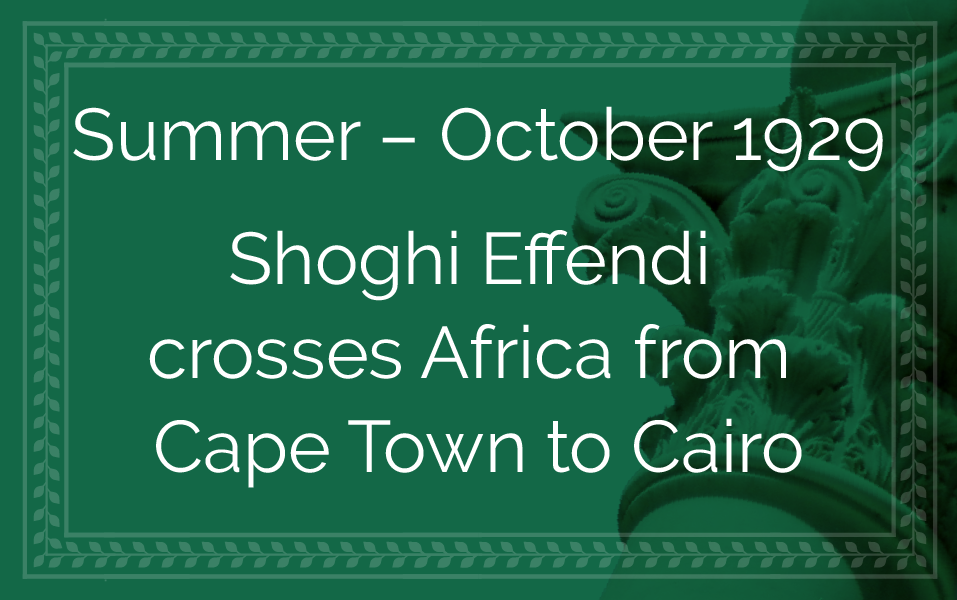

This map of Shoghi Effendi’s journey through Africa in 1929 is approximative. It is not known which direction Shoghi Effendi took upon arriving in Cape Town, though he probably traveled to Johannesburg. The journey through East Africa to the Nile and up the Nile is also symbolic. Shoghi Effendi did travel by train from Egypt to Haifa, so that part is relatively accurate.
Shoghi Effendi left Haifa for Europe in the summer of 1929. We do not know if he traveled to Switzerland, although it is very likely. That year, the Guardian’s adventurous spirit, the same deep love for scenic beauty that had attracted him so many times to the Bernese Alps but also the deep jungles of the world, took him to Africa for his first great journey across the continent.
Shoghi Effendi sailed to Cape Town, South Africa, from England in September 1929. Although he dearly wanted to visit the Belgian Congo, a country that had always fascinated him, he was not able to obtain a visa during this journey.
Shoghi Effendi passed through what is today Zimbabwe, visited the grave of Cecil Rhodes at Matopo Hills, then north to Victoria Falls, where Shoghi Effendi took a photograph of a stunning Baobab tree.
Leaving Zimbabwe, Shoghi Effendi bypassed the Belgian Congo and traveled in a car through East Africa with an English hunter, then rode on a train for 800 kilometers. In the Sudan, Shoghi Effendi rode a ferry on the Nile through a papyrus swamp, and took photographs along the way, making his way to Egypt and arriving back in Haifa in October 1929.
All of the known photographs from Shoghi Effendi's 1929 cross-Africa trip are below in chronological order of his journey.
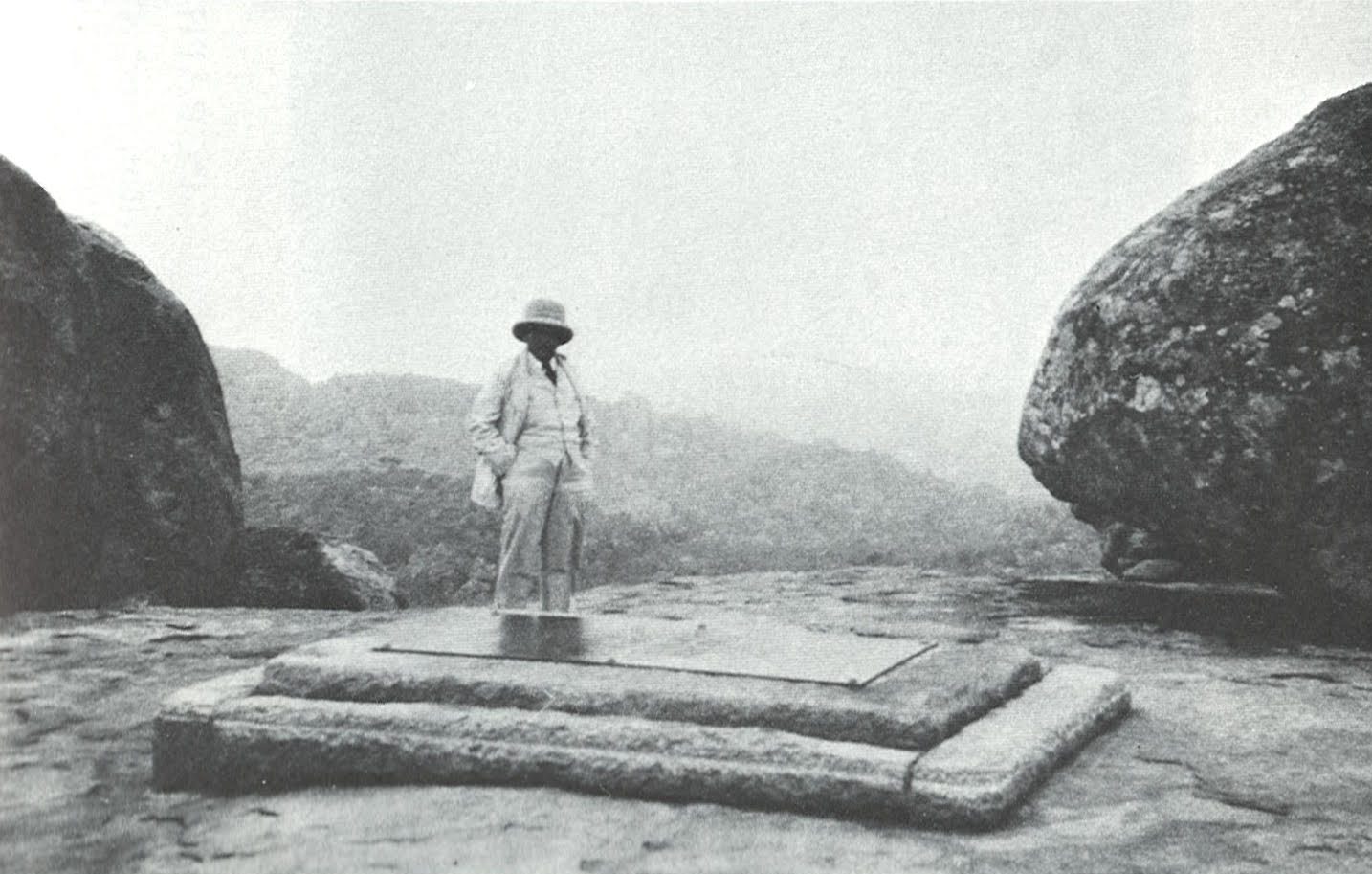
The Guardian standing at the grave of Cecil Rhodes, 1929. Cecil Rhodes was an English colonialist, mining magnate and politician in southern Africa who served as Prime Minister of the Cape Colony. He founded Southern and Northern Rhodesia—named after him and now known as Zimbabwe and Zambia). He also devoted a great deal of effort in building a railway from Cape Town to Cairo Railway and instituted the famous Rhodes Scholarship. Cecil Rhodes was buried at Matopo Hills near Buluwayo, Zimbabwe—then Southern Rhodesia, named after him, and 400 kilometers southeast of Victoria Falls, Shoghi Effendi’s next destination. Source: The Priceless Pearl, between pages 277-278. Scanned and shared by Earl Redman.
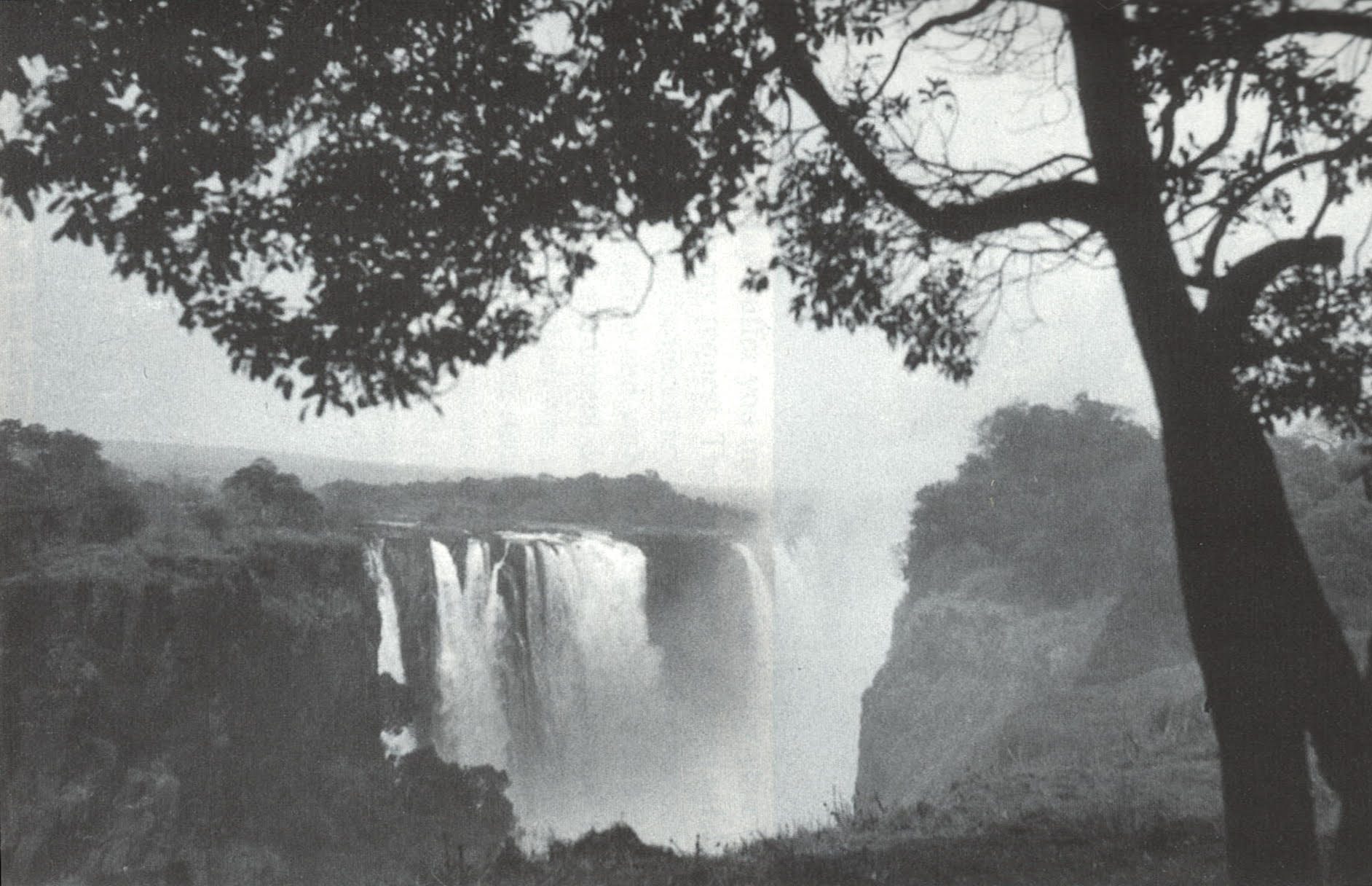
Victoria Falls: Shoghi Effendi’s masterly photograph of one of the world’s greatest waterfalls, Zimbabwe, Africa Source: The Priceless Pearl, between pages 277-278. Scanned and shared by Earl Redman.
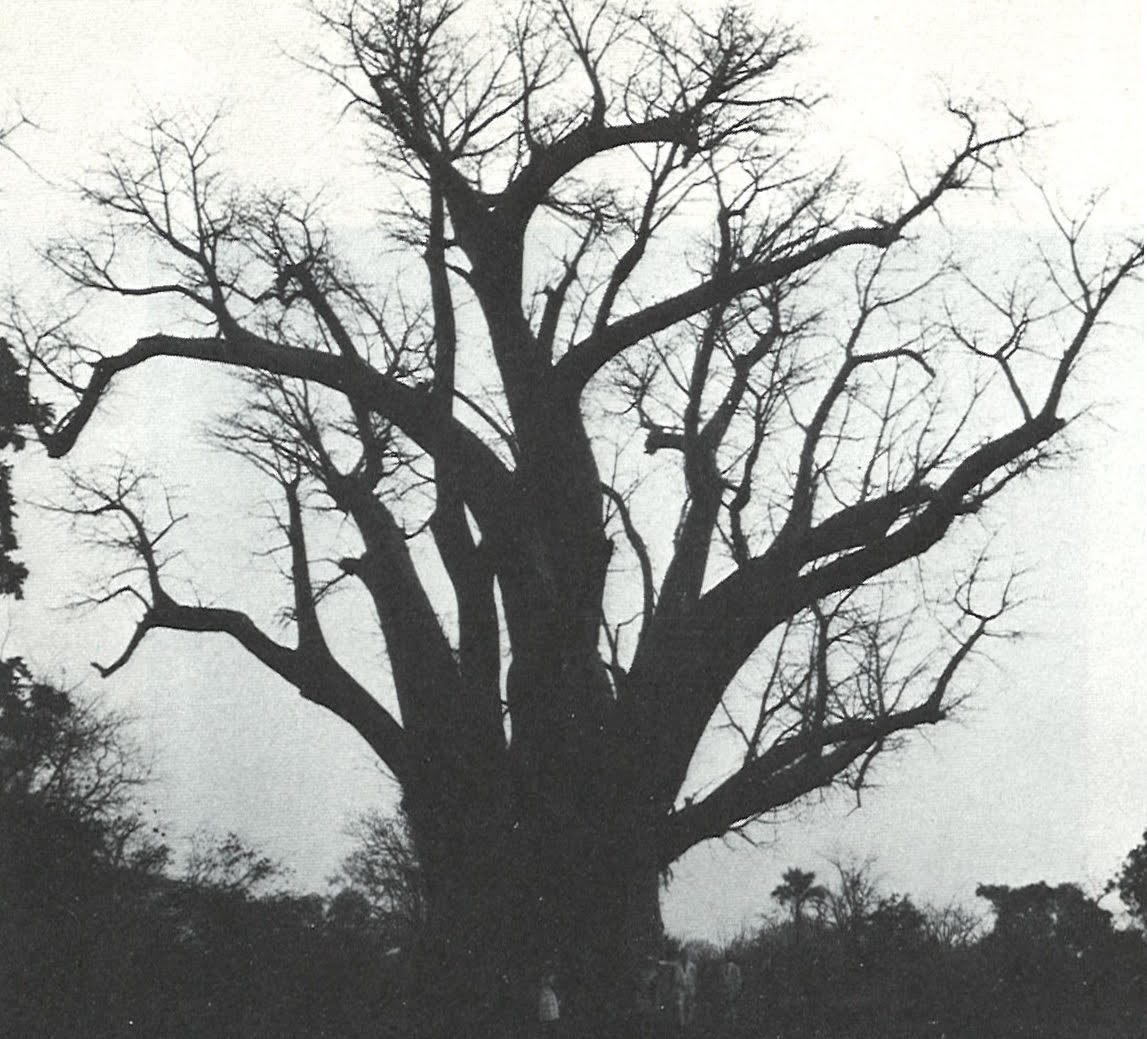
Baobab tree: Shoghi Effendi’s photograph of the giant baobab trees which grew near Victoria Falls. Source: The Priceless Pearl, between pages 277-278. Scanned and shared by Earl Redman.
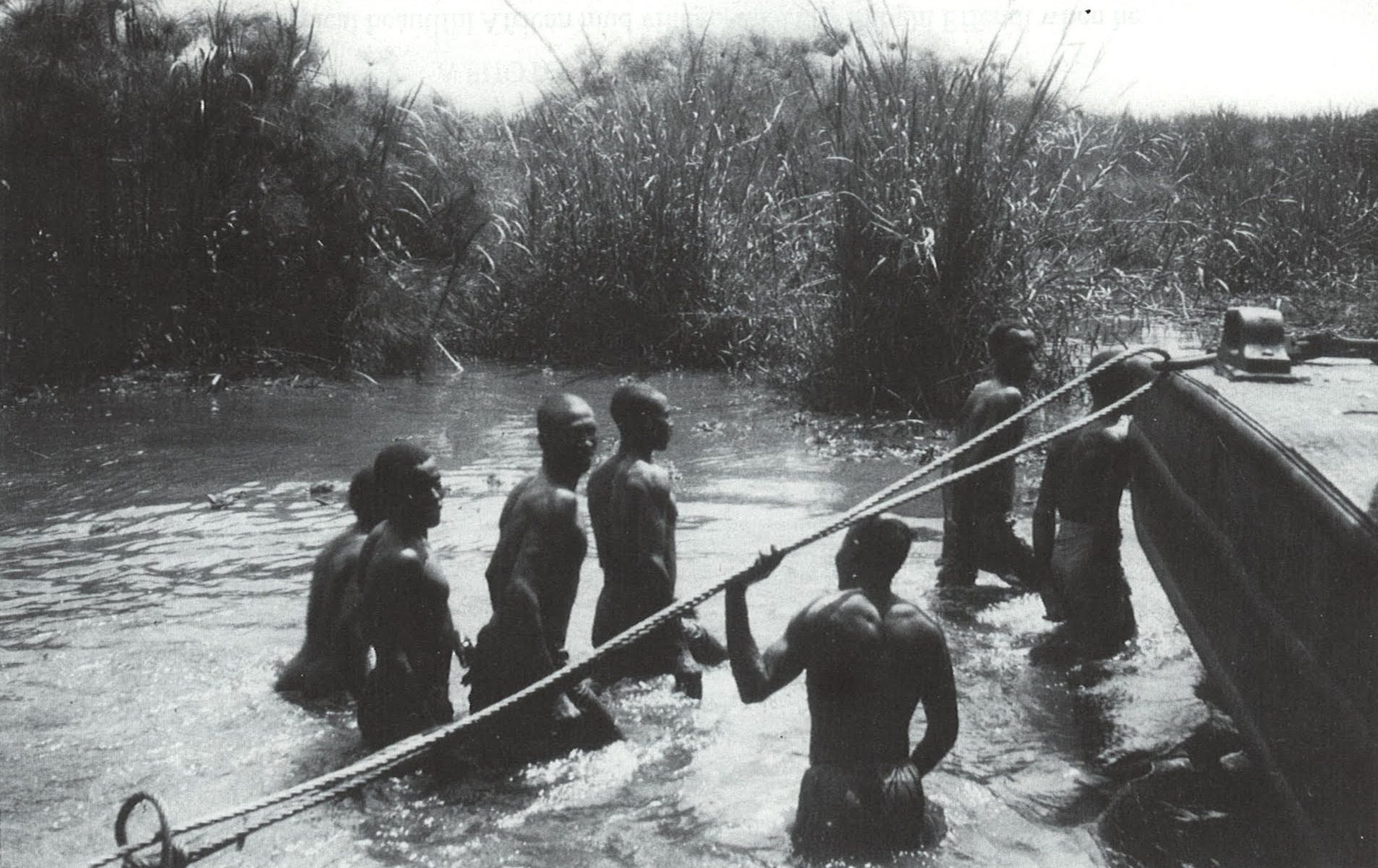
Getting the ferry boat through a papyrus swamp on the Nile River, 1929. Photograph by Shoghi Effendi. Source: The Priceless Pearl.
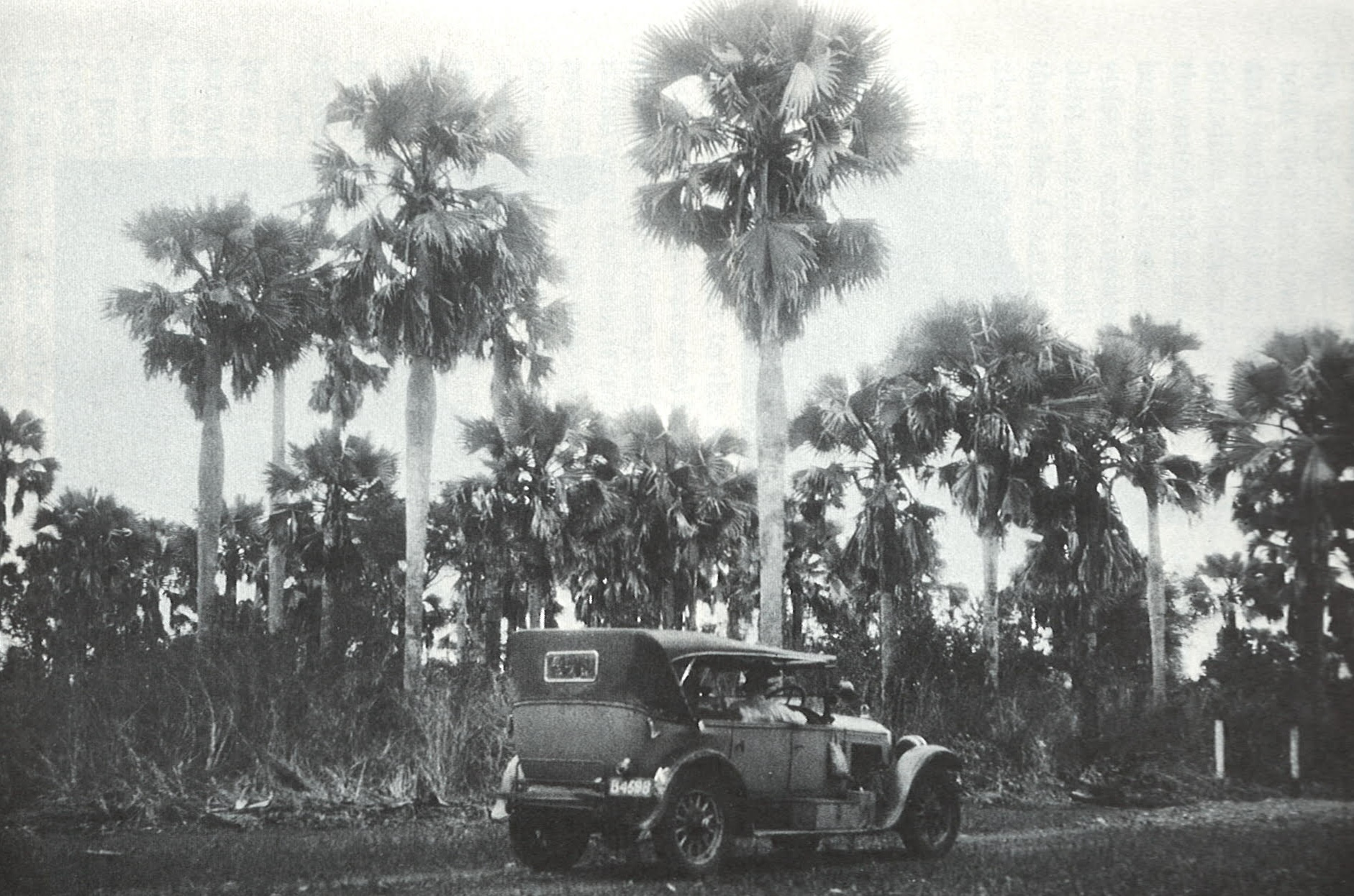
The car in which Shoghi Effendi travelled as a passenger with an English hunter across part of East Africa, 1929 Source: The Priceless Pearl.
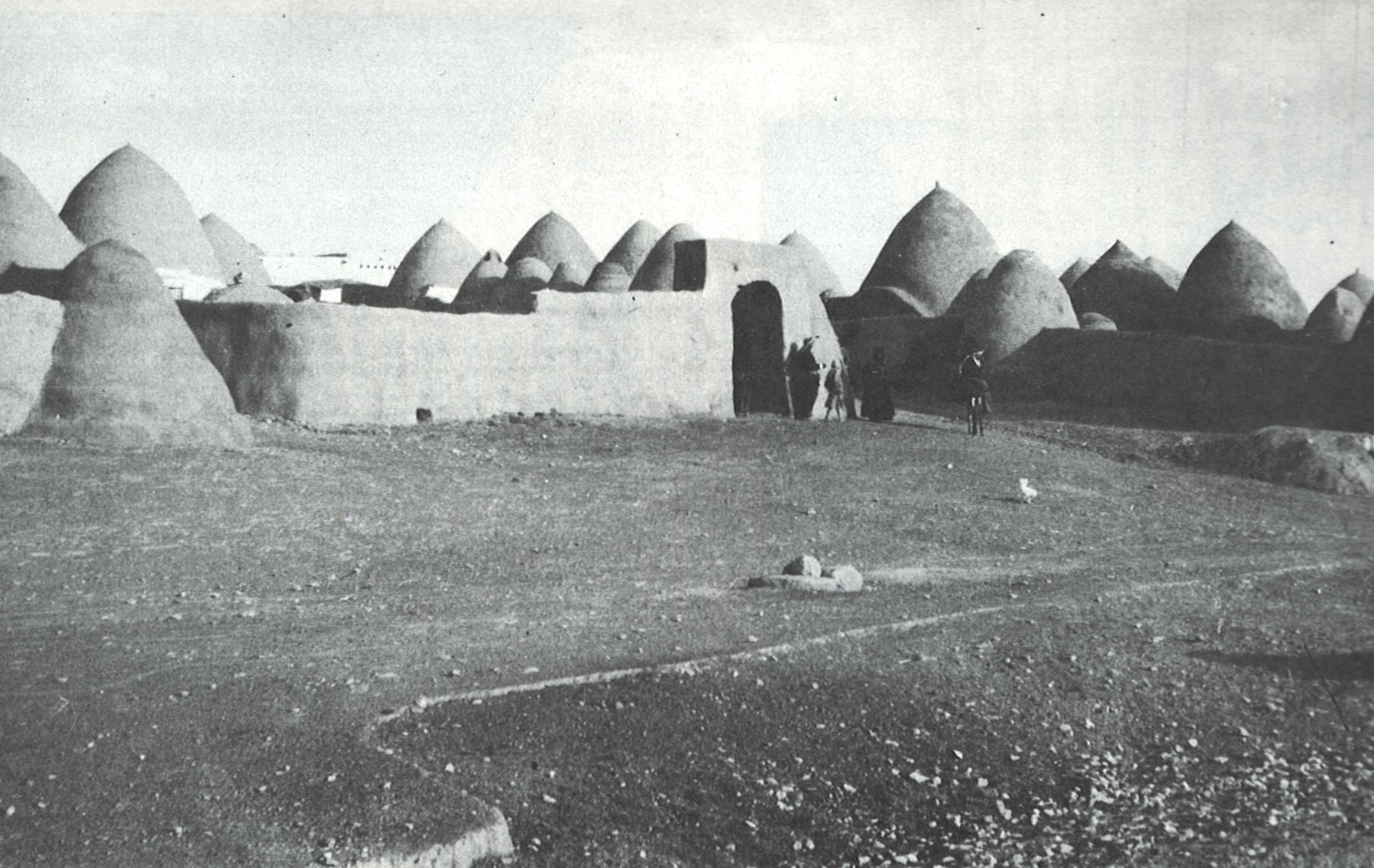
Mud Village: A typical beautiful African mud village, taken by Shoghi Effendi when he crossed Africa from Cape Town to Cairo in 1929. This could be in South Sudan, which has these same types of conical mud huts. Source: The Priceless Pearl, between pages 277-278. Scanned and shared by Earl Redman.
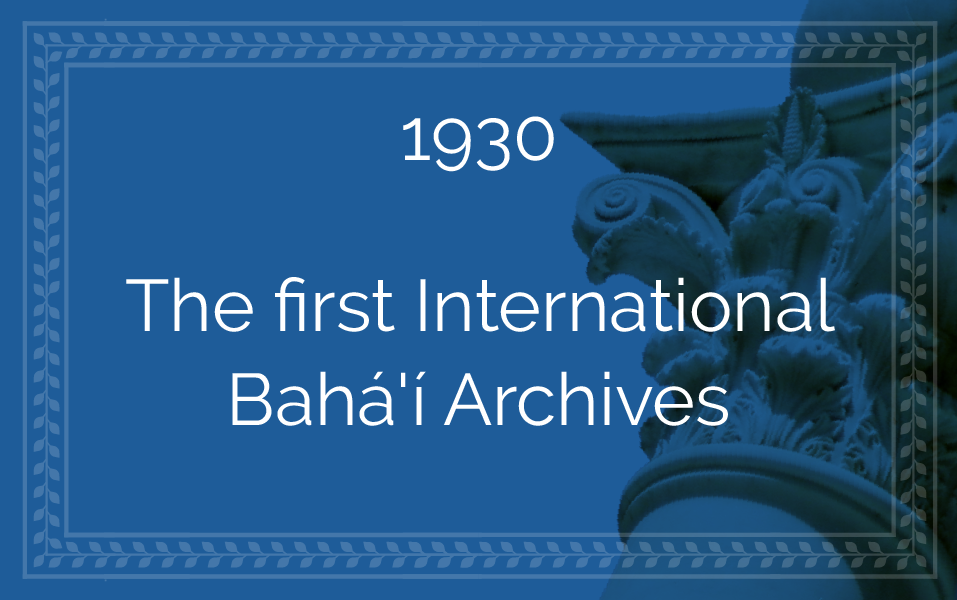
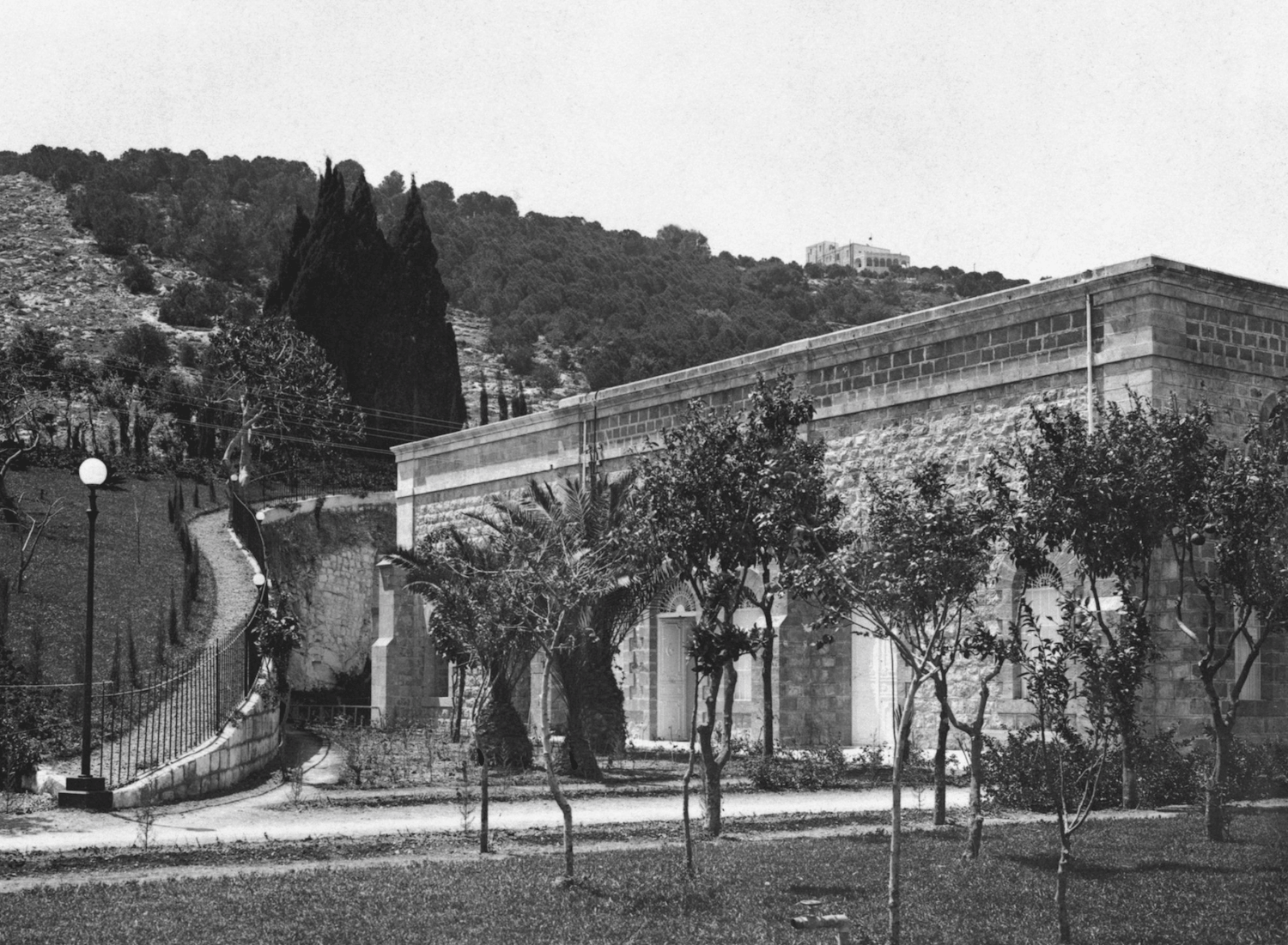
A view of the Shrine of the Báb with the three rooms added by Shoghi Effendi, 1939. Source: Bahá'í World News Service.
Shoghi Effendi began his Guardianship knowing that 'Abdu'l-Bahá, although He had only built six, had planned nine rooms in the Shrine of the Báb, and His grandson undertook to complete the work He had started.
The only real place for the three new rooms of the Shrine of the Báb were on the south side of the Shrine, which would then place the inner sanctuary of the shrine of the Báb in the center of the building. The construction process would be very expensive, because Shoghi Effendi would have to excavate.
Providentially, in 1928, a Bahá’í from Baghdad, Ḥájí Maḥmúd Qassábchí offered to fund the entire project. With the help of a local architect and engineer, Shoghi Effendi designed the plan for the three additional rooms in the Shrine, and he personally supervised the arduous manual excavation of the rock mountain.Actual building work began on 14 February 1929, for a little less than a year, with the rooms being completed by 1930, after Shoghi Effendi had returned from Africa. The beloved Guardian personally supervised the construction work, which required excavation of the mountain-side to make sufficient space for the additional rooms. All the work was accomplished with the use of simple tools and raw manpower, a backbreaking and dangerous enterprise without the help of modern, specialized machinery.
With the Guardian’s addition of the last three rooms, the shape of the original Shrine built by 'Abdu'l-Bahá was changed from an oblong edifice to one perfectly square.
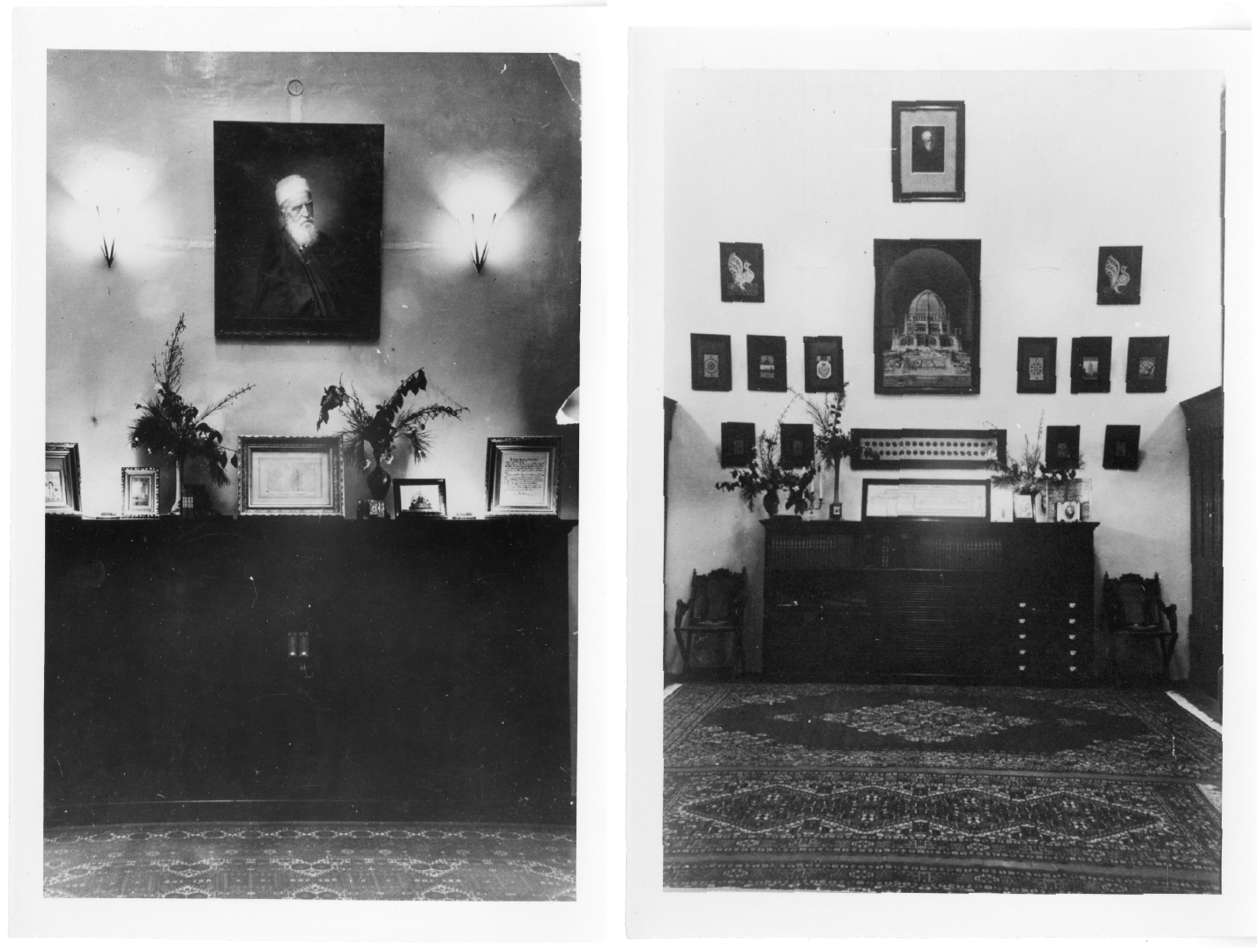
Two photographs of the inside of the very first International Bahá'í Archives on Mount Carmel, in the three rooms Shoghi Effendi finished building in early 1930. Both photographs © United States National Bahá'í Archives, used with permission.
In the three rooms he had just finished building, Shoghi Effendi established the first International Bahá'í Archives. With his own hands, he lovingly gathered and displayed, in orderly arrangements, the relics, the personal objects, photographs and portraits associated with the Central Figures of the Faith. These first Archives would later be known as the major Archives, when a second site would be inaugurated.
Among the items which the pilgrims could marvel at were portraits of the Báb and Bahá’u’lláh, the hair and garments of the Báb and Bahá'u'lláh, Bahá'u'lláh’s pen-case, garments, headdresses, and his alms-bowl (kashkúl) from His two years in Iraqi Kurdistán, priceless manuscripts and Tablets, some illuminated, blood-stained garment of the Purest Branch, the ring of Quddús and the sword of Mullá Husayn,
Visiting the International Bahá'í Archives was a profoundly moving experience which Rúḥíyyih Khánum first experienced in 1937, the year she came on her second pilgrimage to the Holy Land and the year she married Shoghi Effendi. These are her recollections of the early Archives in a room of the Shrine of the Báb and the deep significance of being allowed to gaze upon relics that had touched the person of a Manifestation of God:
If one could have walked into a museum of the authentic relics of the days and life of Christ, what would it have meant to the Christian believers? If they had seen His sandals, dusty from the road between Bethlehem and Jerusalem, or the mantle that hung from His shoulders - or the cloth that protected His head from the sun; what atmosphere of assurance, of wonder, even of adoration would have stirred the inheritors of His Faith. If their eyes could have rested on even one fragmentary line penned by His hand…To most of the people of the world the meaning of such things is beyond their imagining; but to Bahá'ís, believers in the newest Revelation of God's Will as yet revealed to unfolding mankind upon this planet, this inestimable privilege has been vouchsafed.
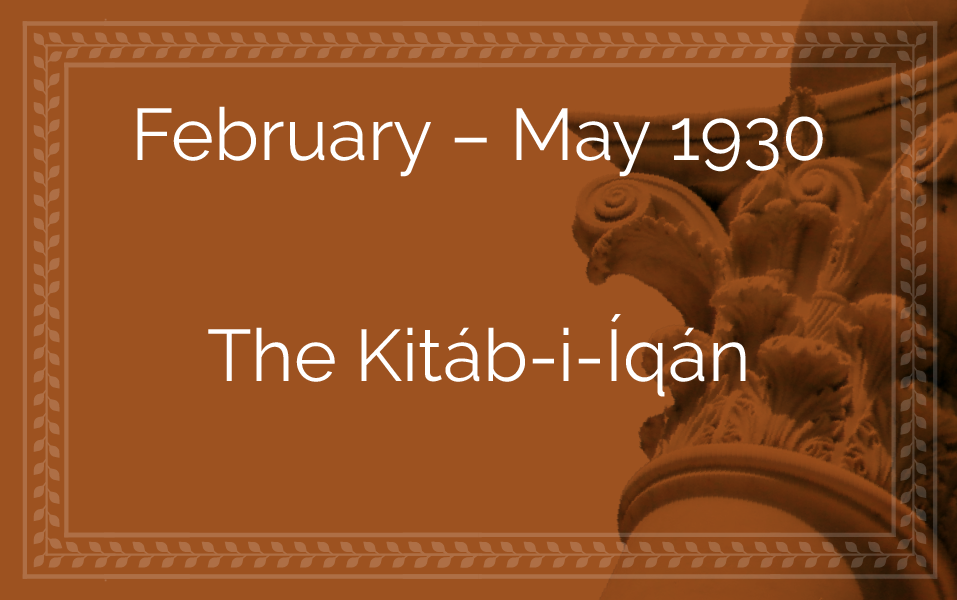
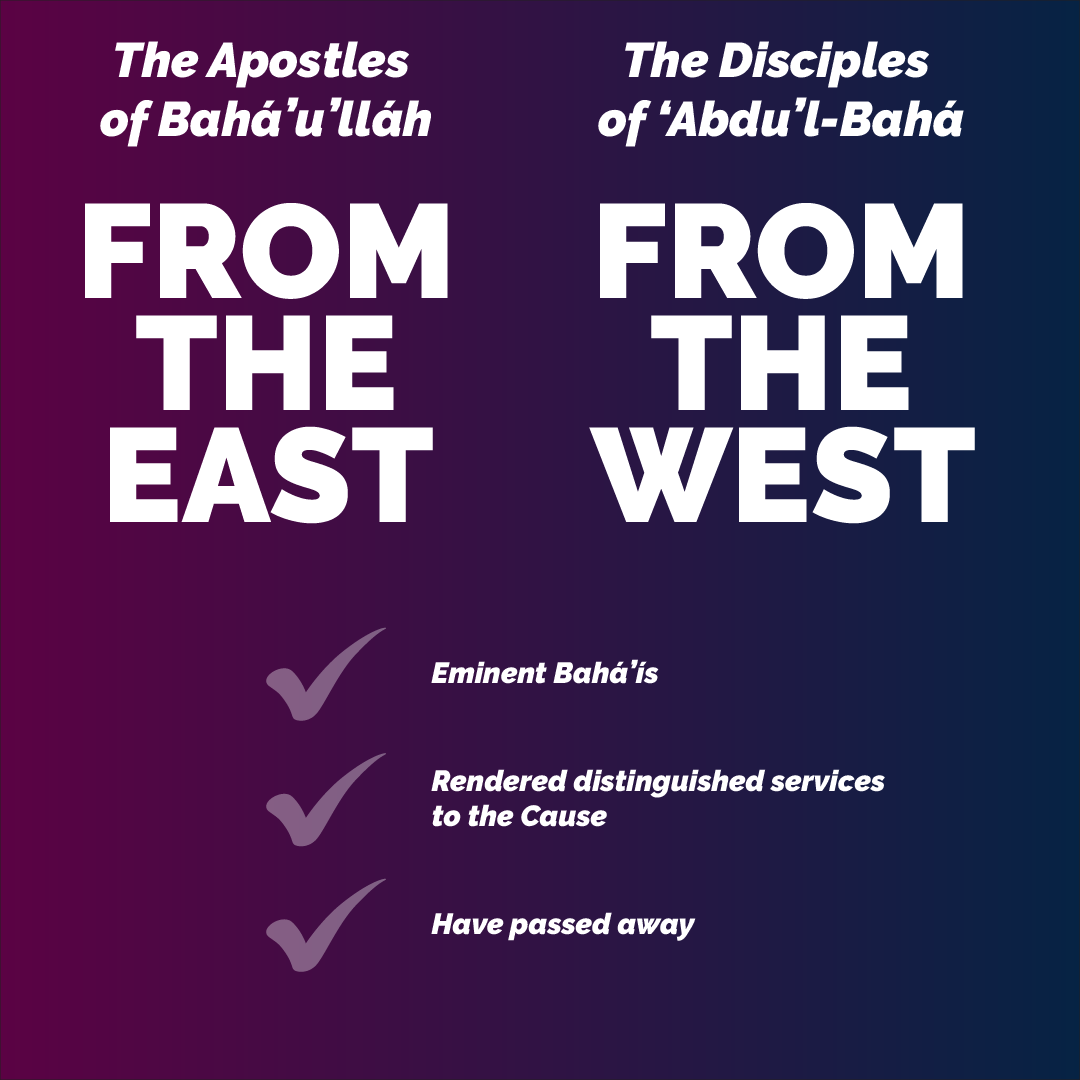
In the 1930s, Shoghi Effendi began collecting archival manuscripts and photographs from the older generation of believers who had become Bahá'ís during the Heroic Age. He also asked outstanding believers to write their memoirs—as 'Abdu'l-Bahá had done with ‘Ḥájí Mírzá Ḥaydar-‘Alí—and he did this with Bahá'ís of the east and the west. In Persia, Shoghi Effendi asked Bahá'ís to write the Bahá'í memoirs of their cities, and dozens of these were completed for cities like Yazd, Shíráz, Hamadan.
Shoghi Effendi also had another, magnificent project.
At least a year—if not more—before his letter to May Maxwell, Shoghi Effendi had devised the most elegant and befitting way to honor the heroes and heroines of the ministries of Bahá'u'lláh and 'Abdu'l-Bahá: He would elevate them all to a rank, he would choose 19 of them, and provide their photographs, and insert the two plates in the upcoming volume of The Bahá'í World.
The 19 eminent Bahá'ís from the time of Bahá'u'lláh would be called the Apostles of Bahá'u'lláh—all of them men, and all of them Persian.
The 19 distinguished believers from the ministry of 'Abdu'l-Bahá would be henceforth known as the Disciples of 'Abdu'l-Bahá—men and women, all western.
On 3 February 1930, May Maxwell received a letter from Shoghi Effendi’s describing the project:
Among others [Shoghi Effendi] is collecting the pictures of some of the old friends who have passed away and who have rendered distinguished services to the Cause. He has already gathered the pictures of nineteen distinguished figures among those who have rendered eminent services to the Cause in the East. He wishes now to gather an equal number from among the old western Bahá’ís who have passed away and who have done great services to the Cause.
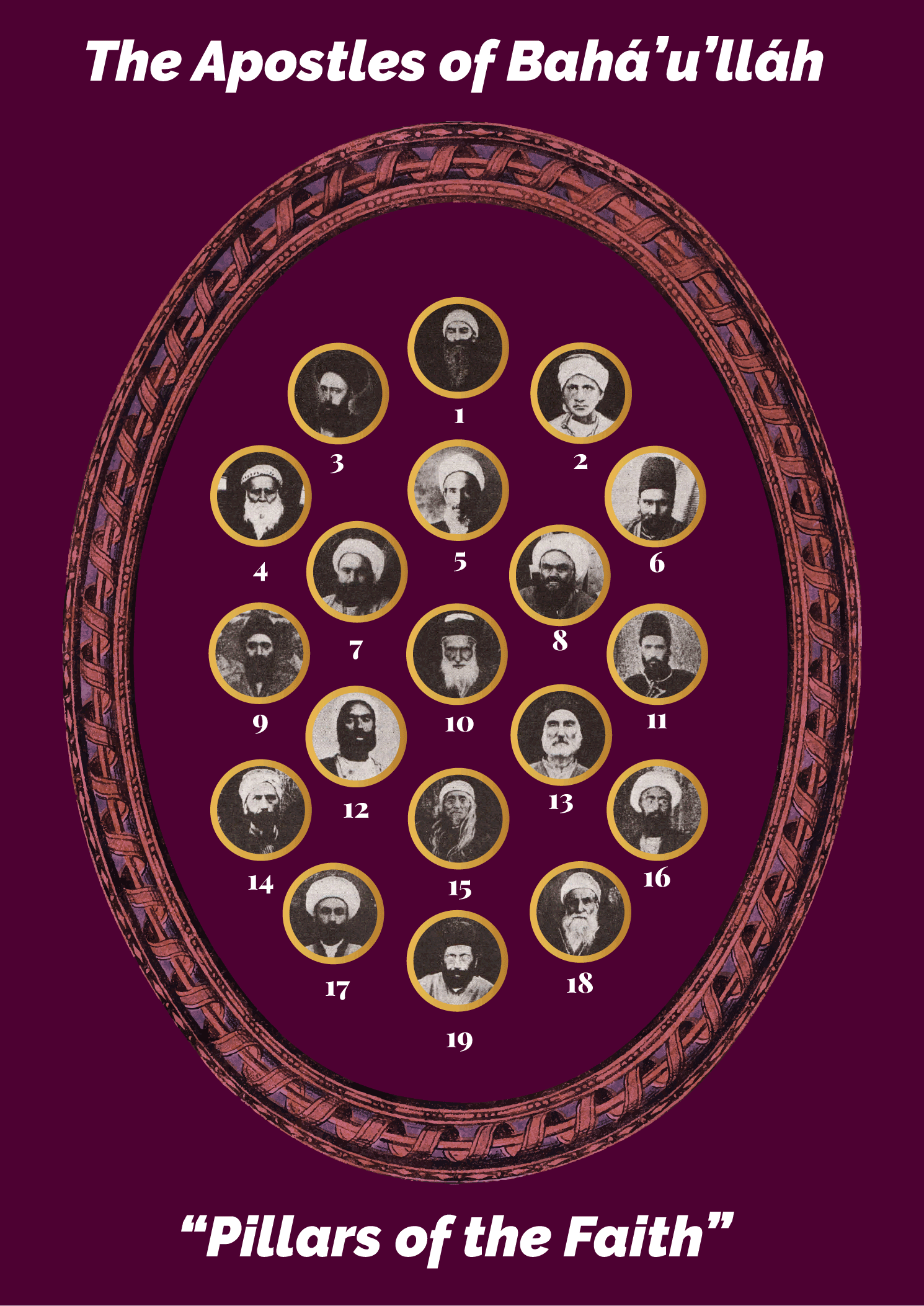
- Mírzá Músá: the brother of Bahá’u’lláh, 18 month his junior.
- Badíʻ: the 17-year-old who martyred after delivering Bahá'u'lláh’s Tablet to Naṣiri'd-Dín Sháh.
- Siyyid Ḥasan: the “King of Martyrs” who was beheaded with his brother.
- Ḥájí Amín: a.k.a. Mulla Abdu'l-Hasan, the trustee of Ḥuqúqu’lláh. Elevated to the rank of Hand of the Cause by Shoghi Effendi after his passing.
- Mírzá Abu'l-Faḍl: one of the most learned Bahá'í scholar and ardent defender of the Faith of his generation.
- Varqá: the father of Rúhu'lláh. They were martyred together.
- Mírzá Maḥmúd: well-known teacher of the Faith, dedicated to the welfare of the youth.
- Ḥájí Ákhúnd: One of the four Hands of the Cause appointed by Bahá'u'lláh during His lifetime. At 'Abdu'l-Bahá’s orders, he transferred the remains of the Báb from various secret locations to ʻAkká. He was responsible for much of the Bahá’í activity in Persia until his death.
- Nabíl-i-Akbar: one of the most learned men in all of Persia, with the equivalent of two doctorates in philosophy and Islamic law, he attained the rank of mujtahid and was a fearless teacher and recipient of several tablets from Bahá’u’lláh.
- Vakílu'd-Dawlih: a cousin of the Báb and the chief builder of the first Bahá'í House of Worship in ‘Ishqábád, a project initiated by ʻAbdu'l-Bahá in 1902.
- Ibn-i-Abhar: One of the four Hands of the Cause appointed by Bahá'u'lláh during His lifetime. He traveled and taught throughout Persia, the Caucasus, Turkmenistan and India.
- Nabíl-i-Aʻẓam: Poet-Laureate of the Blessed Beauty, eminent teacher of the cause and author of Nabíl’s Narrative.
- Káẓim-i-Samandar: Bahá'u'lláh’s favorite Apostle, extraordinary teacher of the Faith and recipient of the Lawḥ-i-Fu'ád
- Muḥammad Muṣṭafá Baghdádí: he lived in Beirut and assisted all the pilgrims on their way to and from 'Akká; he met some of the Báb's Letters of the Living.
- Mishkín-Qalam: the most noteworthy calligrapher of his time and designer of the Greatest Name.
- Adíb: One of the four Hands of the Cause appointed by Bahá'u'lláh during His lifetime. After the passing of Bahá’u’lláh, he became instrumental in dealing with the activities of Covenant-breakers in Persia; he became of the first National Spiritual Assembly of Persia and also traveled to India and Burma.
- Shaykh Muḥammad-'Alí: the nephew of Nabíl-i-Akbar, he traveled to India and Haifa, and 'Abdu'l-Bahá later sent him to ‘Ishqábád to promote the education of children; he helped complete some of Mírzá 'Abu'l-Faḍl’s unfinished works.
- Zaynu’l-Muqarrabín: a doctor of Islamic law, it was he who asked Bahá'u'lláh questions regarding the Kitáb-i-Aqdas which are published as an appendix called “Questions and Answers” at the end of the Most Holy Book.
- Ibn-i-Aṣdaq: One of the four Hands of the Cause appointed by Bahá'u'lláh during His lifetime. Bahá'u'lláh gave him the title Shahíd Ibn-i-Shahíd (Martyr, son of the Martyr) because he was the son of Mullá Ṣádiq Muqaddas, a martyr from the time of the Báb; he brought the Tablet to the Hague from Haifa to the Netherlands along with Aḥmad Yazdaní.
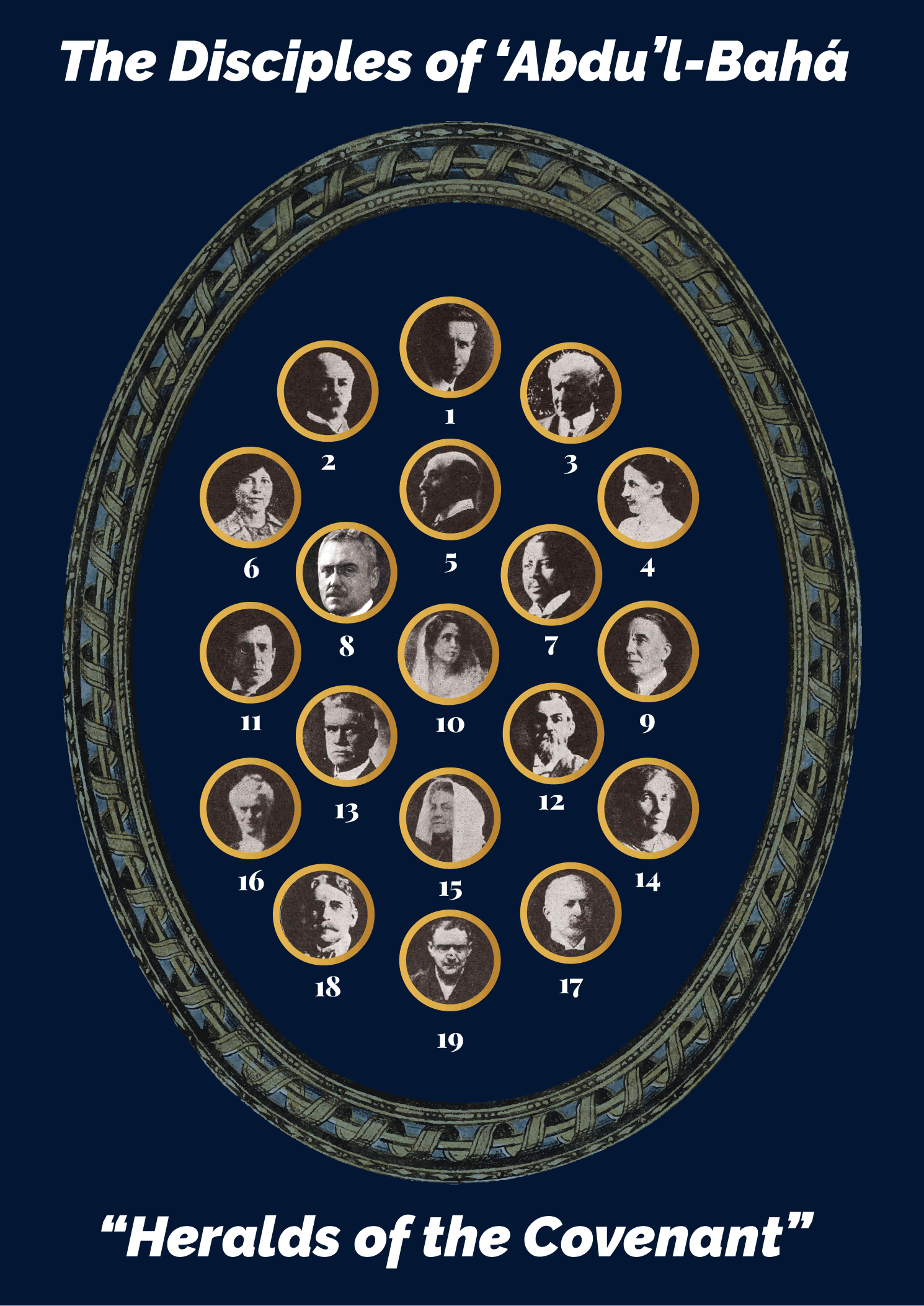
- John E. Esslemont: author of Bahá'u'lláh and the New Era, Hand of the Cause and secretary of the Guardian.
- Thornton Chase: the first American Bahá'í,
- Howard MacNutt: noted Bahá’í teacher, passionate about editing and publishing Bahá'í books and newsletters.
- Sarah Farmer: Founder of Green Acre.
- Hippolyte Dreyfus-Barney: author, translator, and international promoter of the Faith.
- Lillian Kappes: noted teacher of the Tarbíyaṭ school in Tihrán.
- Robert Turner: first African-American Bahá'í.
- Albert Schwarz: a prominent member of the German Bahá'í community.
- William H. Randall: eloquent upholder of the Bahá’í Cause in America.
- Lua M. Getsinger: titled “Herald of the Covenant” and "Mother of the believers" by 'Abdu'l-Bahá and “mother teacher of the American Bahá‘í Community, herald of the dawn of the Day of the Covenant" by Shoghi Effendi, she was one of the first westerners ever to meet 'Abdu'l-Bahá in 1898,
- Joseph Hannen: an integral member of the Washington Bahá'í community, notable for his efforts to teach the Faith to the African American community.
- Chester I. Thacher: an early Chicago Bahá'í.
- Charles Greenleaf: an active member of the early Chicago Bahá'í community, and cofounder of the entity which eventually became the Bahá'í Publishing Society
- Isabella D. Brittingham: one of the earliest American Bahá'ís, a trusted and energetic teacher of the Faith.
- Ethel Rosenberg: the first English Bahá'í, hosted ‘Abdu’l-Bahá in her home during His visit to England, she served on the first National Spiritual Assembly of the British Isles, briefly served as a secretary for Shoghi Effendi.
- Helen S. Goodall: dearly beloved by 'Abdu'l-Bahá, she accompanied Him often during His travels in America; she helped establish the Bahá'í Faith on the west coast of the United States and in Hawaii, and served on the first national administrative Bahá'í body in the United States.
- Arthur P. Dodge: staunch advocate of the Cause, very active member of the New York City Bahá'í community.
- William H. Hoar: prominent Bahá’í teacher and one of the earliest American Bahá'ís.
- George Jacob Augur: first Bahá'í to pioneer to Japan.
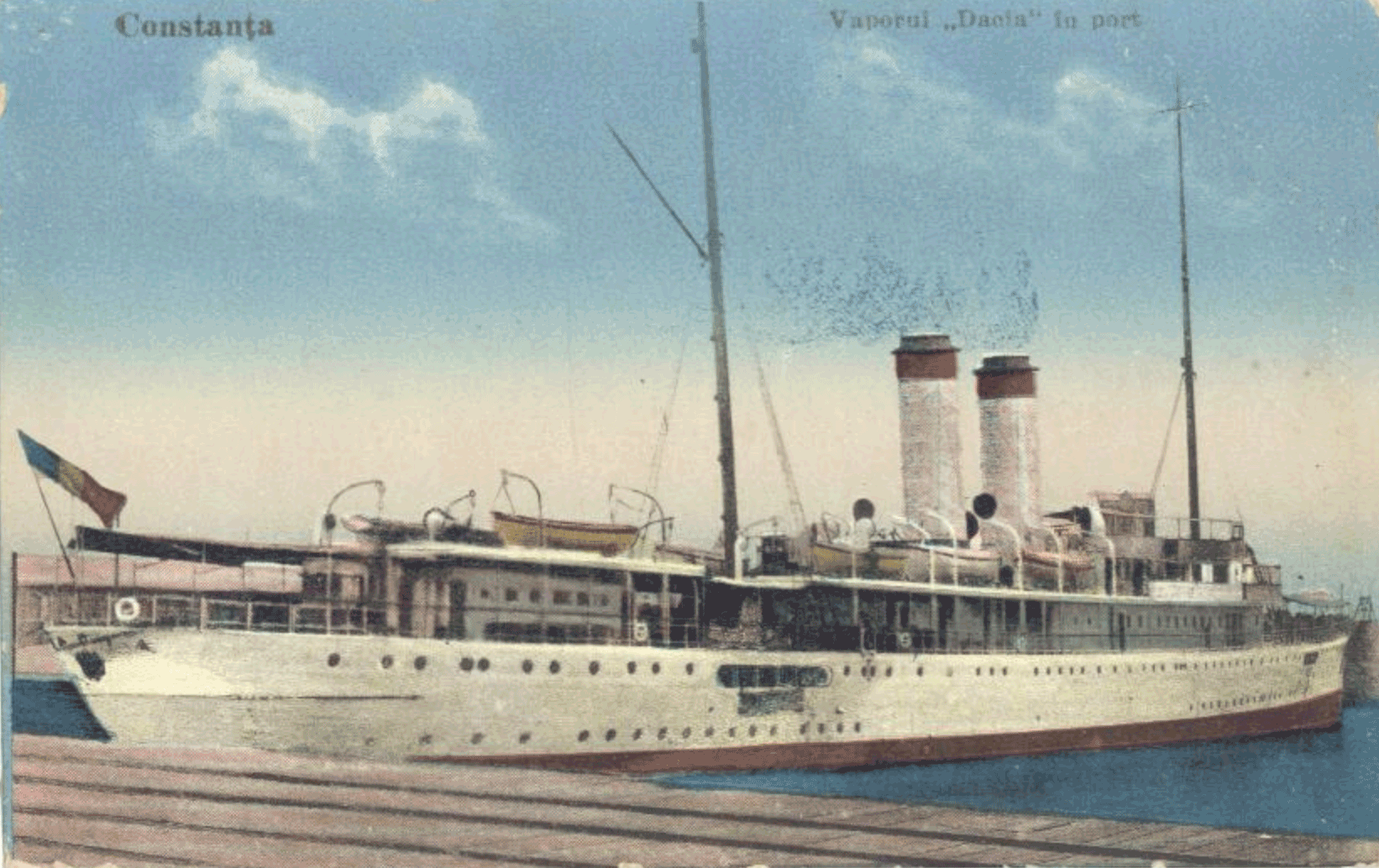
The Dacia, the Imperial Yacht aboard which Queen Marie of Romania sailed to Egypt and to the Holy Land, but was unable to visit Shoghi Effendi and the Greatest Holy Leaf. Source: Wikimedia Commons.
In October 1929, Queen Marie, knowing about her upcoming visit, in spring of 1930, to Egypt and the Middle East, had affirmed to Martha Root:
We shall surely go to Haifa.
Queen Marie of Romania and her daughter Ileana left Romania on the royal yacht, the Dacia, and traveled from Istanbul to Athens, arriving in Alexandria sometime in February 1930.
Both Shoghi Effendi and Bahíyyih Khánum were anxiously awaiting Queen Marie’s visit in March 1930, and Shoghi Effendi began making preparations. He wired the Bahá'ís in Egypt and asked them to only convey written expressions of welcome on behalf of the Bahá'ís and to avoid individual communications.
The Guardian also prepared a priceless gift. He asked the Bahá'ís of Persia to reproduce Bahá'u'lláh’s Tablet to Queen Victoria, Queen Marie’s grandmother in the finest calligraphy, illuminate the Tablet and send it to the Holy Land no later than 10 March 1930.
Shoghi Effendi had not heard from Queen Marie so he sent a cable on 8 March extending a heartfelt invitation on behalf of 'Abdu'l-Bahá’s family to the queen and stated:
Your Majesty's acceptance to visit Bahá'u'lláh's Shrine and prison-city of 'Akká will apart from its historic significance be a source of immeasurable strength joy and hope to the silent sufferers of the Faith throughout the East.
There was no reply.
On 30 March 1930, Queen Marie’s ship docked in Haifa. The Greatest Holy Leaf had waited, hour after hour, in the Master's home to receive Queen Marie and Princess Ileana, and even Shoghi Effendi had hoped the visit and the Queen’s pilgrimage would take place. But time passed and no news came.
In her diary, Queen Marie sheds light on what happened. She had docked in Haifa in the early morning of 20 March. Then, the party had been met at the ship, informed her visit was politically impossible, the Queen was placed in a car and driven to Syria.
Queen Marie was just as heart-broken as Shoghi Effendi and the Greatest Holy Leaf that her visit to Haifa and 'Akká did not take place. One year later, on 28 June 1931, she wrote to Shoghi Effendi and expressed her feelings about the missed visit:
Both Ileana and I were cruelly disappointed at having been prevented going to the holy shrines and of meeting Shoghi Effendi, but at that time were going through a cruel crisis and every movement I made was being turned against me and being politically exploited in an unkind way. It caused me a good deal of suffering and curtailed my liberty most unkindly.
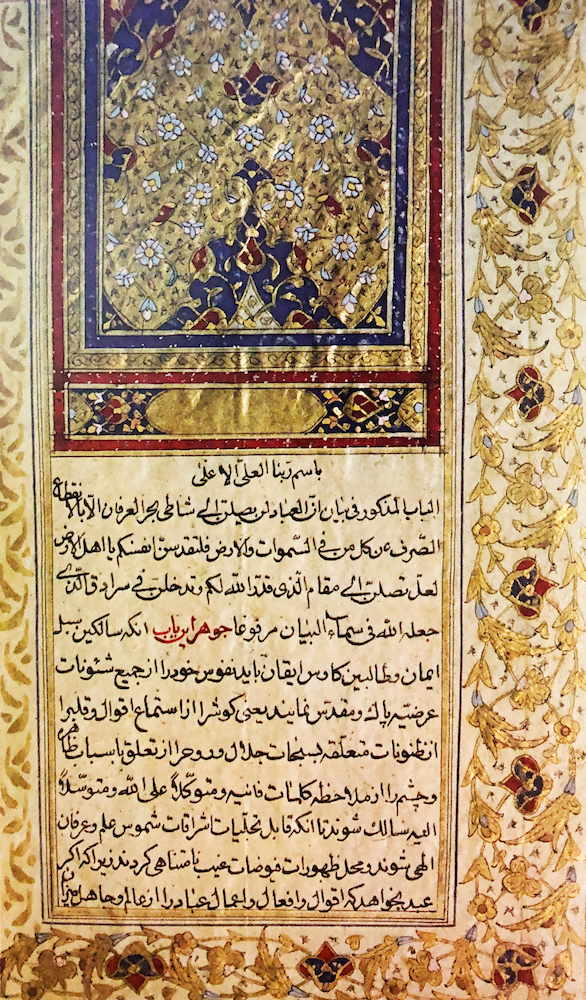
Opening page of the Kitáb-i-Íqán from a manuscript date 1871 in the handwriting of Áqá Mírzá Áqáy-i-Rikáb-Sáz, the first Bahá'í Martyr of Shíráz. Source: Frontispiece of H.M. Balyuzi, Bahá'u'lláh: The King of Glory.
In early 1930, the Guardian embarked on his first major, ambitious translation of the Writings of Bahá'u'lláh: the Kitáb-i-Íqán, “foremost among the priceless treasures cast forth from the billowing ocean of Bahá’u’lláh’s Revelation,” a book he later described as a “model of Persian prose, of a style at once original, chaste and vigorous, and remarkably lucid, both cogent in argument and matchless in its irresistible eloquence, this Book, setting forth in outline the Grand Redemptive Scheme of God, [the Kitáb-i-Íqán] occupies a position unequalled by any work in the entire range of Bahá’í literature, except the Kitáb-i-Aqdas, Bahá’u’lláh’s Most Holy Book.” (GPB 138–9).
The Guardian also describes the Kitáb-i-Íqán as “foremost among a “unique repository of inestimable treasures,” possessing an “unsurpassed pre-eminence among the doctrinal” Writings of Bahá’u’lláh.
The Kitáb-i-Íqán (The Book of Certitude) had been the most important book in the early days of the Faith, and it was the source of many eminent Bahá'ís’ conversion to the Faith. Bahá'u'lláh revealed the Kitáb-i-Íqán in January 1861, in the space of 48 hours in Baghdad in response to four questions from the maternal uncle of the Báb, Ḥájí Mírzá Siyyid Muḥammad, who accepted the station of his Nephew, the Báb, when he read the Kitáb-i-Íqán.
The Kitáb-i-Íqán is Bahá'u'lláh’s greatest treatise on the station, the mission, and the role of Manifestations of God, and it would be as useful to Christian seekers in the 20th century as it had been to Muslim ones in the 19th century.
It just needed to be translated into English.
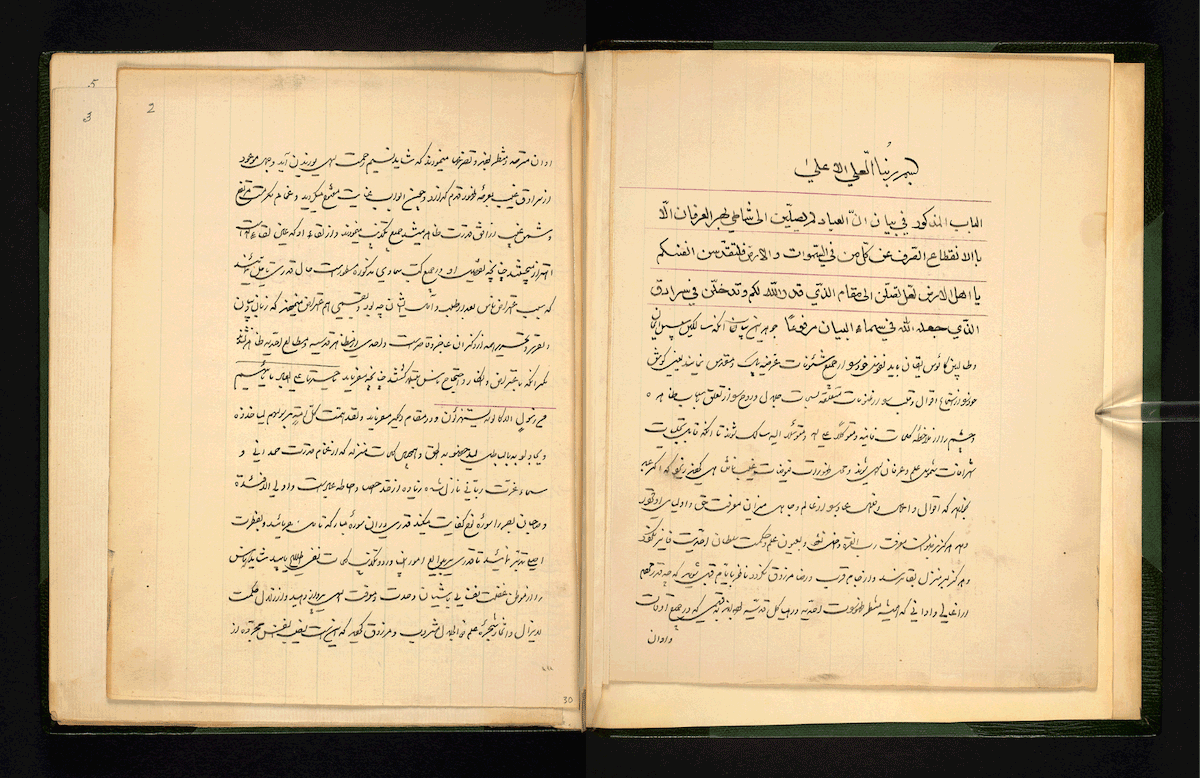
Manuscript of the first two pages of the Kitáb-i-Íqán (unknown calligrapher), copied prior to 1886, when it was purchased by the Austrian orientalist and politician Alfred von Kremer. British Library. Kitab-i Iqan (‘Book of Certitude’), a major Baha’i work by Baha’u’llah.
Shoghi Effendi must have started translating the Kitáb-i-Íqán in 1929, because he had finished the first pages by January 1930, and sent them to George Townshend for review. By 12 March 1930, George Townshend had the entire Kitáb-i-Íqán.
Shoghi Effendi had included words in parentheses in the manuscripts he had sent George Townshend, asking him to choose the most suitable alternative.
The Guardian’s translation of the Kitáb-i-Íqán, like all his translations, was a marvel of meticulous attention paid to every single word. This short excerpt of a letter Shoghi Effendi’s secretary wrote to George Townshend on 19 January 1930 shows how much thought was put into the translation of a single word:
He would like to draw your attention to the word “tribulation” on page 9. Bahá’u’lláh is quoting the famous words of Jesus recorded in Matthew 24:29–31, “Immediately after the tribulation of those days shall the sun be darkened…” etc. The Authorized Version reads “tribulation” whereas the Arabic, from which Bahá’u’lláh is quoting, gives “narrowness.” As there is a difference, Shoghi Effendi would like you please to find out what the original in Greek or Hebrew is. If you think proper he would welcome such alterations from you which would make the language of the rendering more Biblical as he thinks it preferable.
George Townshend’s response to the Guardian’s request was equally meticulous. It turned out that the original Greek word used in the Bible was the word “Thlipsis” which has two meanings: pressure or oppression/affliction.
Upon receiving this information, Shoghi Effendi changed the word “tribulation” to “oppression” which rendered the text: “Immediately after the oppression of those days shall the sun be darkened…”
Shoghi Effendi included a note for the word oppression which read:
“The Greek word used (Thlipsis) has two meanings: pressure and oppression.
When he sent the manuscript of the Kitáb-i-Íqán to the United States, Shoghi Effendi wrote an explanatory note:
Unable to find a good typist, I have had to do the work myself, and I trust that the proofreaders will find it easy to go over and will not mind the type errors which I have tried to correct. I would especially urge you to adhere to the transliteration which I have adopted. The correct title is, I feel, "The Kitab-i-Íqán" the sub-title "The Book of Certitude. “May it help the friends to approach a step further, and obtain a clearer idea of the fundamental teachings set forth by Baha'u'llah.
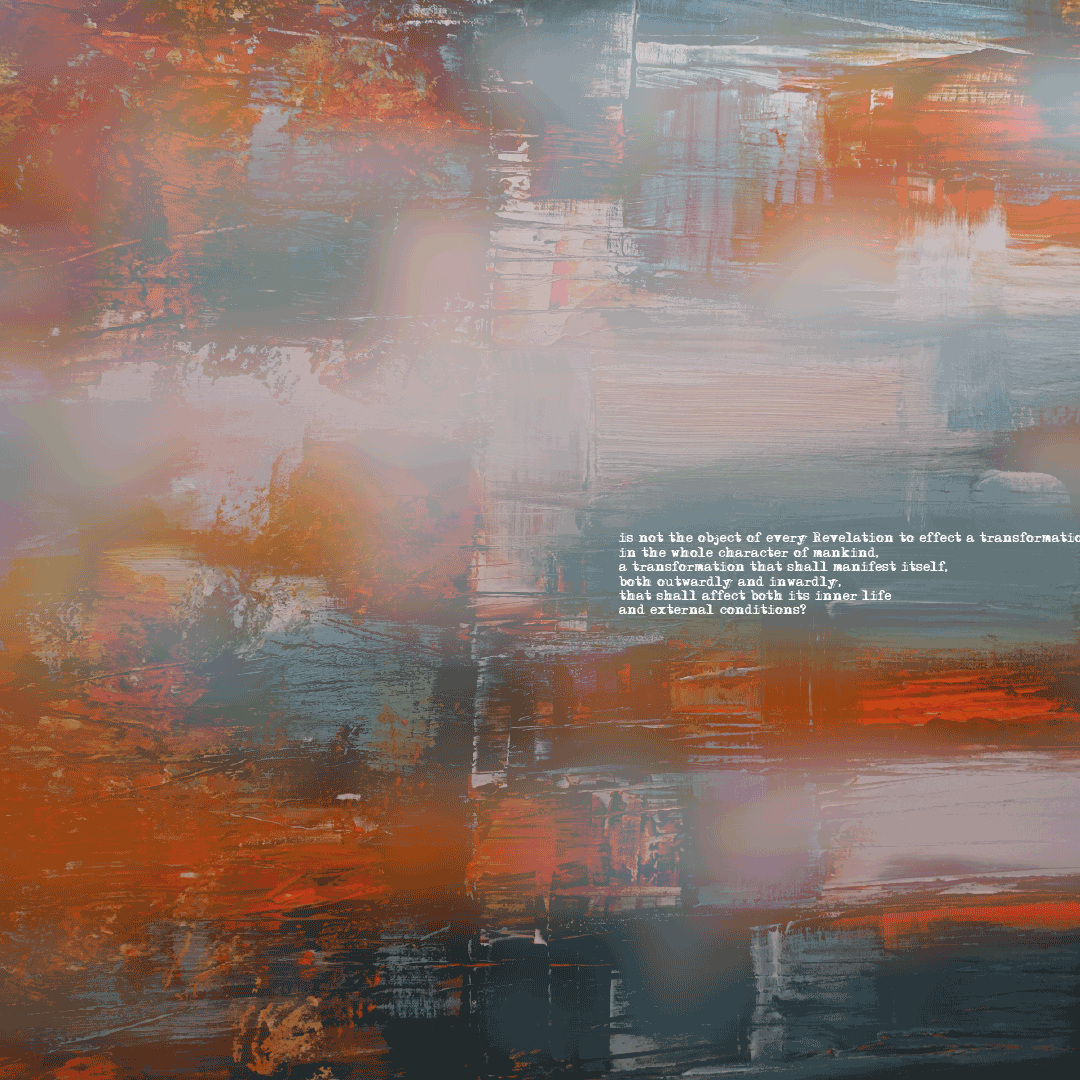
“Transformation.” Original image: Photo by Alan Scales on Unsplash.
The Guardian’s translation of the Kitáb-i-Íqán stands alone as a work of unsurpassed beauty in the English language. And yet, Shoghi Effendi felt impelled to place a note immediately before his own translation, as if to pay a public homage to the untranslatable perfection of Bahá'u'lláh’s original Persian:
This is one more attempt to introduce to the West, in language however inadequate, this book of unsurpassed pre-eminence among the writings of the Author of the Bahá’í Revelation. The hope is that it may assist others in their efforts to approach what must always be regarded as the unattainable goal—a befitting rendering of Bahá’u’lláh’s matchless utterance.
The Kitáb-i-Íqán is filled with peerless, exquisite sentences, but this excerpt inward and outward transformation, on the goal of all divine Revelations is simply without equal for its straightforwardness, its eloquence and its unimpeachable, divine logic:
Behold, how, notwithstanding these and similar traditions, they idly contend that the laws formerly revealed must in no wise be altered. And yet, is not the object of every Revelation to effect a transformation in the whole character of mankind, a transformation that shall manifest itself, both outwardly and inwardly, that shall affect both its inner life and external conditions? For if the character of mankind be not changed, the futility of God’s universal Manifestation would be apparent.
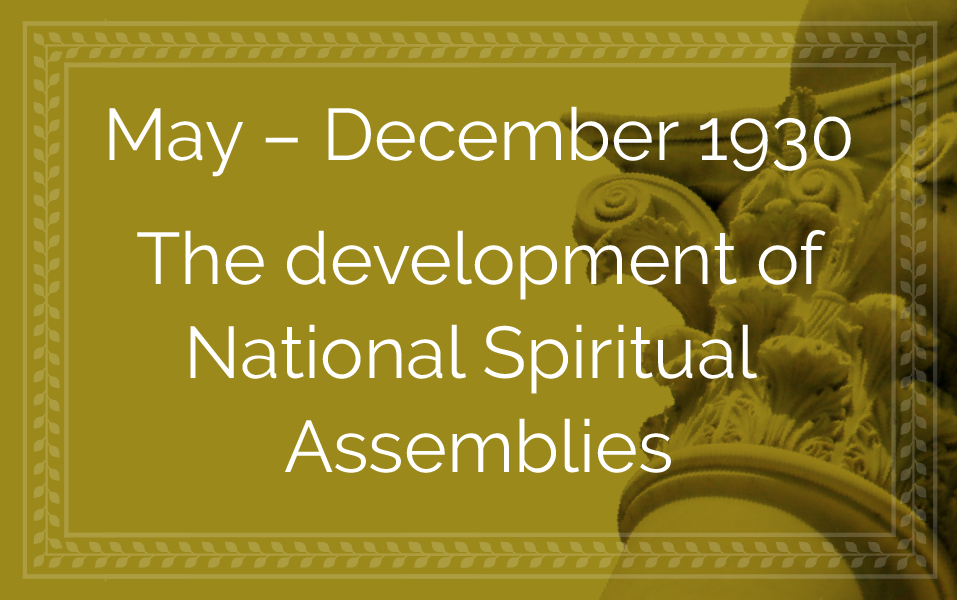
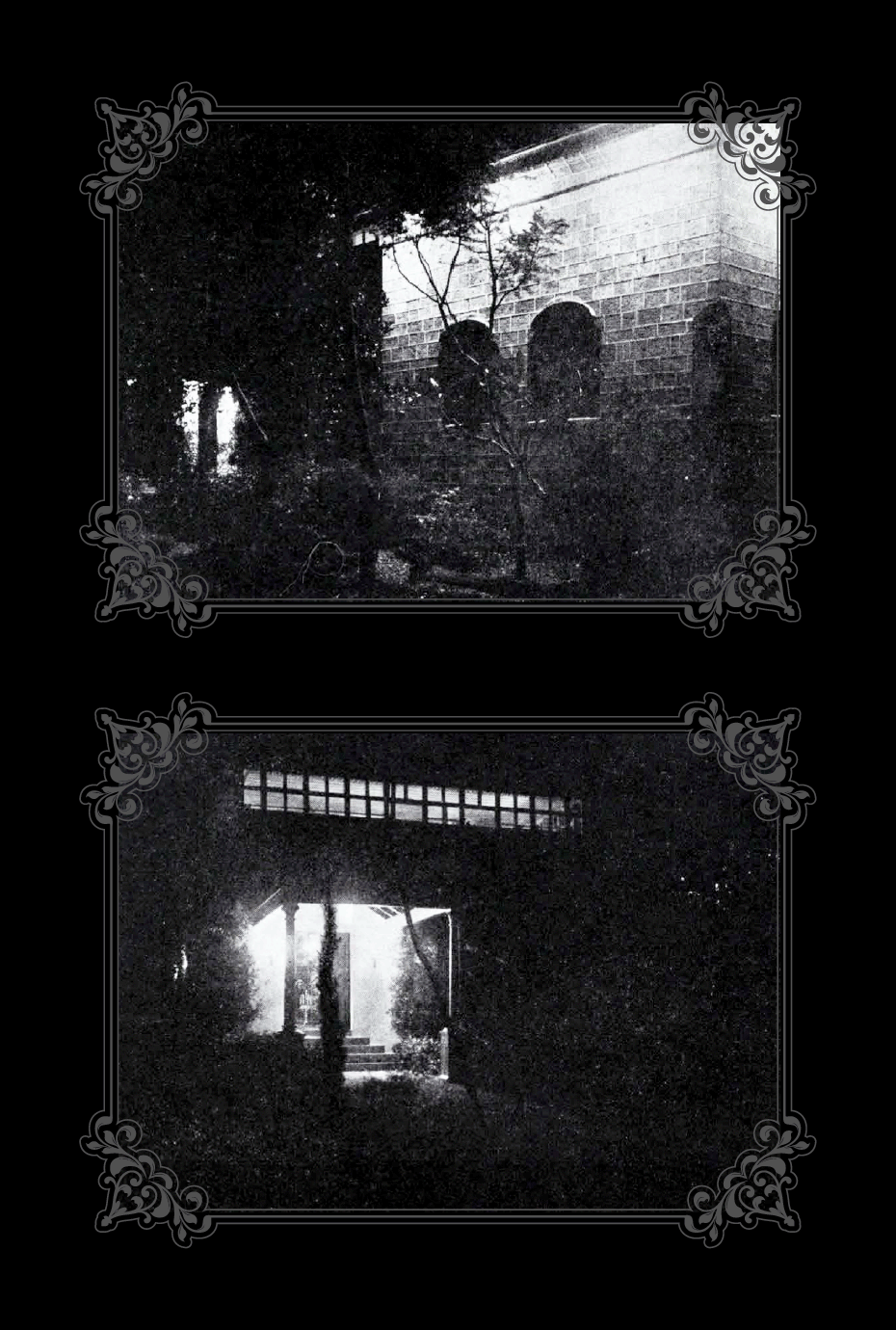
Two views of the Shrine of Bahá'u'lláh at Bahjí at night around 1930. Source: The Bahá'í World Volume 4, page 5.
This story is meant to convey the atmosphere of sanctity that Holy Day commemorations had during the ministry of the Guardian. Every year, these holy days were celebrated, but this vignette serves as a universal description of what it was like to live through the commemoration of the Ascension of Bahá'u'lláh in his presence.
There were so many pilgrims present on the night of 28 May 1930, that groups of Bahá'ís had to take turns entering the Shrine of Bahá'u'lláh. The outer chamber of the Shrine was brilliantly illumined, its large cut-glass chandeliers sparkling with the flames of its countless candles, shedding their flickering light on the delicate rug and velvet drapes.
The blue sky was still visible through the glass windows at the top of the Shrine’s outer chamber, their electric lamps, bringing out the relief of the color and texture of the many plants in the central atrium, paved with the small, perfectly round Galilee Sea pebbles.
The Guardian entered first, knelt before the inner Shrine, and retreated to the outer chamber after a few moments.
The Bahá'ís paying their respect at the Holy Threshold moved silently and reverently in an atmosphere devoid of somberness, but filled with a regenerating spirit. Some of the Bahá'ís present on this day had lived in the time of Bahá'u'lláh, entered His presence, gazed upon His face, and they wept with their memories, silently, filling the Shrine with their sense of loss and inexpressible longing.
The believers, one by one, knelt in silent reverence at the Holy Threshold before the inner Shrine, directly above the vault in which Bahá'u'lláh’s sacred remains lay. The Holy of Holies was adorned with soft green velvet draperies and exquisite Persian rugs, beautiful urns overflowing with flowers shedding their fragrance, and delicately lit with a lamp and candelabra.
After the believers had paid their respects, the Guardian chanted the Tablet of Visitation, and the Bahá'ís exited the Shrine, resuming their devotions in the Ḥaram-i-Aqdas, the beautiful garden surrounding the Most Holy Shrine.
Throughout the night, Bahá'ís entered the Shrine to pay their respects, pray, and leave to make room for the next group of friends.
At 3:00 AM on 29 May 1892, the Guardian again entered the Shrine and chanted the Tablet of Visitation, his sweet, melodious voice penetrating the hearts of all those who were present. When the last of the Bahá'ís exited the Shrine of Bahá'u'lláh, the first streaks of dawn were lighting the sky, and the first sound they heard was the song of a bird.
One hour later, at 4:00 AM, the Bahá'ís began their journey back to Haifa.
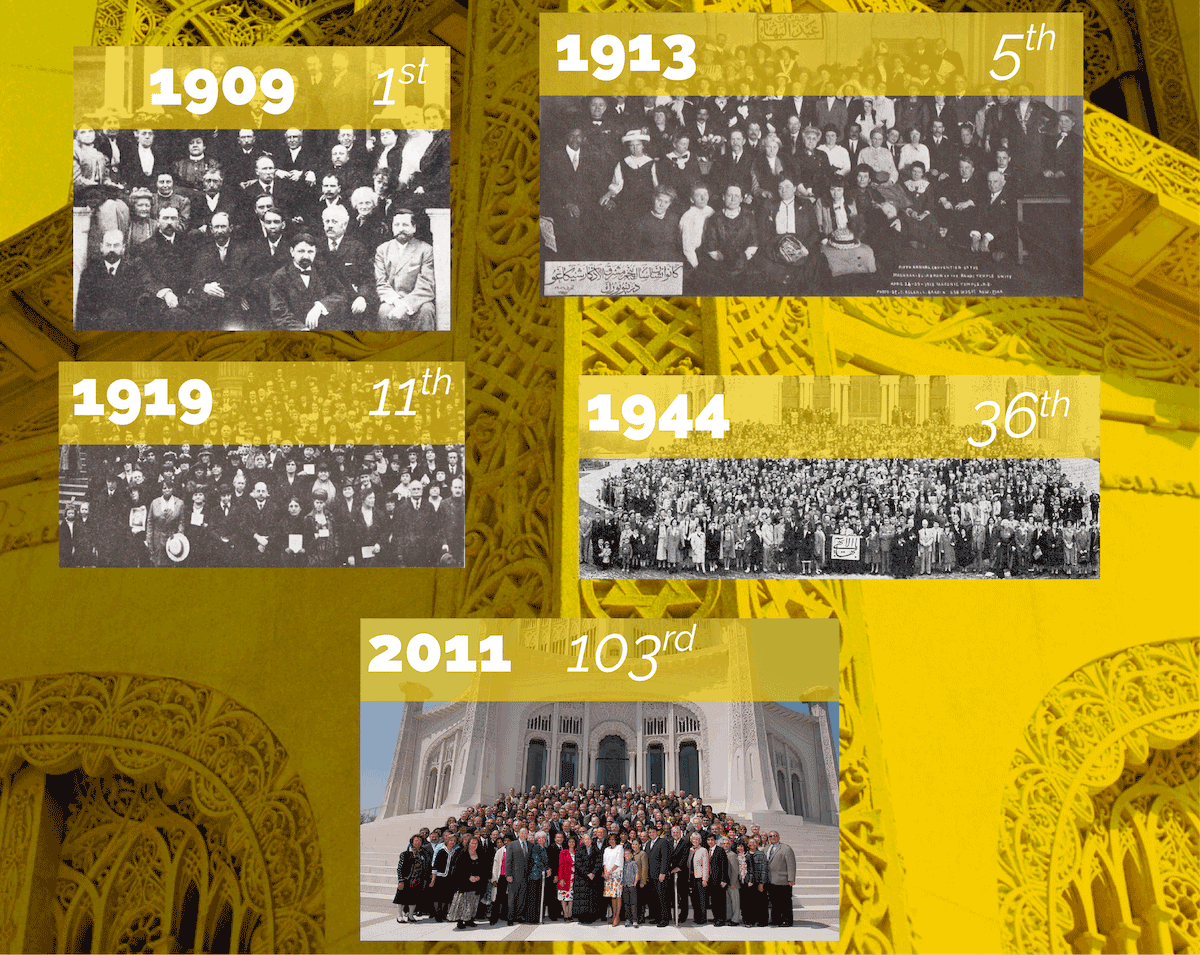
Photographs of the 1st, 5th, 11th, 36th, and 103rd National Conventions of the United States. Source: Bahaimedia. Background: Detail of the ornamental features of the Continental Bahá’í House of Worship of North America (Wilmette, United States), 1988. Source: Bahá'í Media Bank, © Bahá'í International Community 2023.
One of the Guardian’s strongest characteristics was his genius for organizing, and Rúḥíyyih Khánum estimates this quality was divinely created in him to fulfill the needs of the Formative Age of the Faith, the development of the Administrative Order, and in particular, how quickly and carefully Shoghi Effendi devised a uniform system of National and Local Spiritual Assemblies throughout the entire world. He was a true statesman.
The Guardian explained to the Bahá'ís at the start of his ministry, that this Administrative Order was unique in religious history, different from any system of religious administration, and that, what they were building would evolve to eventually "at once incarnate, safeguard and foster" the spirit of this invincible Faith and become a World Bahá'í Commonwealth. The system created by Bahá'u'lláh was therefore divine in origin, inaugurated by 'Abdu'l-Bahá, and implemented by Shoghi Effendi would, as the Guardian stated, never “degenerate into any form of despotism, of oligarchy, or of demagogy which must sooner or later corrupt the machinery of all man-made and essentially defective political institutions," in fact, as Shoghi Effendi stated, it was an Administrative Order completely “supernatural, supranational, entirely non-political, non-partisan, and diametrically opposed to any policy or school of thought that seeks to exalt any particular race, class or nation. It is free from any form of ecclesiasticism, has neither priesthood nor rituals, and is supported exclusively by voluntary contributions made by its avowed adherents."
This work would define the next 36 years of his Guardianship, but began in the first year of his ministry, when he encouraged the election of a National Spiritual Assembly in the United States and Canada after a National Convention where 65 localities in North America were present.

Original photo by Erol Ahmed on Unsplash.
By 1930, there were 9 National Spiritual Assemblies in the Caucasus, Persia and Turkistan—these three could not hold National Conventions at first—and Egypt, Great Britain, Germany, India and Burma, Iraq, and the United States and Canada.
In terms of developing the local administration of the Faith, already on 4 April 1923, Shoghi Effendi had sent a cable to the National Spiritual Assembly of the United States and Canada Bahá'ís stating:
"strongly urge re-election all local Assemblies first Riḍván April 21.
This personal attention to the development of a uniform Administrative Order, this personal encouragement from the Guardian to individual National Spiritual Assemblies regarding the importance of the development of Local Assemblies went out to the entire Bahá'í world.
This was not happening in a vacuum. All around the Guardian—building the Administrative Order of the Bahá'í Faith—and the worldwide Bahá'í community—following the instructions of their Guardian—the world was suffering. The Guardian spoke in 1923 about "the confusion and the gross materialism in which mankind is now sunk," and warned the Bahá'ís that the world was "apparently drifting further and further from the spirit of the Divine Teachings…”
Shoghi Effendi had already, by virtue of his divinely-ordained capacity for interpretation, seen where humanity was headed—war. He knew a cancer was eating away at the world in which they lived and he not only guided the Bahá'í community but prepared them for coming adversities with frequent warnings.
The Guardian created movement in every part of the globe, which he personally and constantly encouraged and fostered, systematically calling attention to the proper titles of the administrative bodies and to the uniformity of Bahá'í elections. Shoghi Effendi pursued this task actively for many years, never forgetting, even when local Bahá'ís neglected to elect or re-elect their Local Spiritual Assemblies, it was an aspect of his Guardianship that required tremendous amounts of loving patience and repetition of guidance.
As the Guardian of the Faith, Shoghi Effendi needed to have constant and complete reports of Bahá'í activity worldwide in order to be able to track the progress of the Administrative Order. This was difficult at first, because Bahá'ís were used to believing in the teachings of the Faith and celebrating Feasts and Holy Days, but not being administrators.
This is an area where the Guardian also lovingly and patiently trained Bahá'ís. For example, in 1923, this is how the Guardian explained to the National Spiritual Assembly of Germany and Austria the type of information he required from them, both in content and regularity:
I am so desirous to receive from the National Spiritual Assembly frequent, comprehensive and up-to-date reports on the present position of the Cause throughout Germany, with an account of the activities of the various Bahá'í Centres recently established throughout that land.
Shoghi Effendi did not just need to collect information at the Bahá'í World Centre, but he also used the encouraging reports of activities for another important purpose: to stimulate and cheer the Bahá'ís in East with the victories won by their brethren in the West.
He was building a united Bahá'í world.
That Shoghi Effendi wanted to grow the Administrative Order did not mean he ignored its limitations. The Guardian always knew the capacity of the Administrative Order, at every stage of its development. For example, in July 1939, the Guardian wrote to the National Spiritual Assembly of the United States and Canada stating they that they didn’t yet have the capacity to launch a public campaign that would affect the treatment of Bahá'ís in Persia. They didn’t yet have the power to accomplish what they felt they could do.
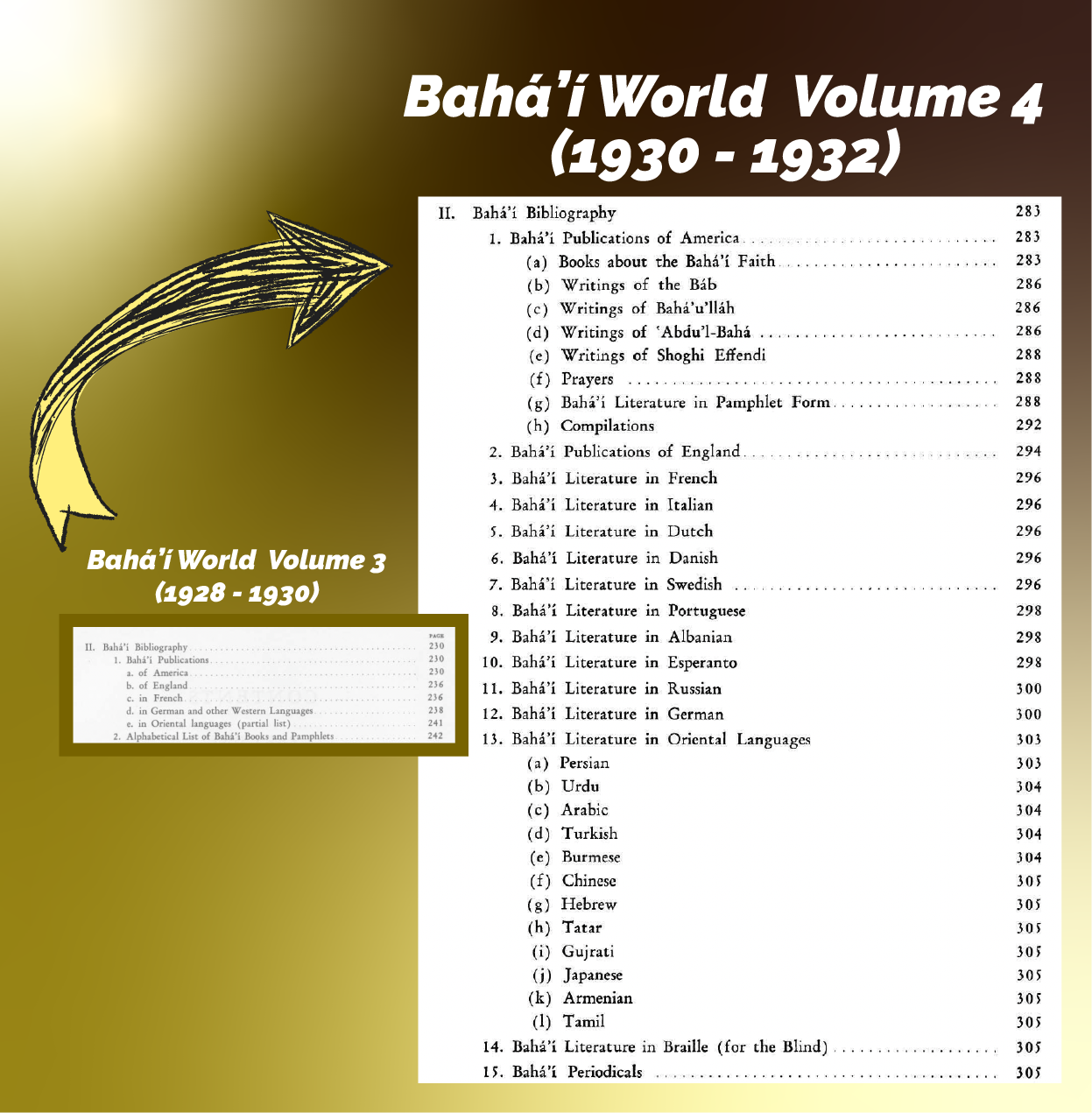
Look at the massive increase in publications, languages, types of publications in just ONE issue of The Bahá'í World, two years apart!
Part of the Guardian’s efforts in building this world was his constant encouragement to Bahá'í communities to subscribe to Bahá'í publications which shared wonderful news and activities. The most prominent of these were Star of the West in the United States and Canada, the Sun of Truth published in Germany, The Dawn published in Burma, the Bahá'í News of India, and the Khorshid-i-Khavar published in Ishqábád, and the two News Letters published by the Haifa Bahá'í Spiritual Assembly in Persian and English.
Through all these measures, the Guardian vigorously encouraged the Bahá'ís throughout the world, in his own special, effective blend of stimulation and challenge to every Bahá'í community to stir themselves into action, cooperation and better understanding.
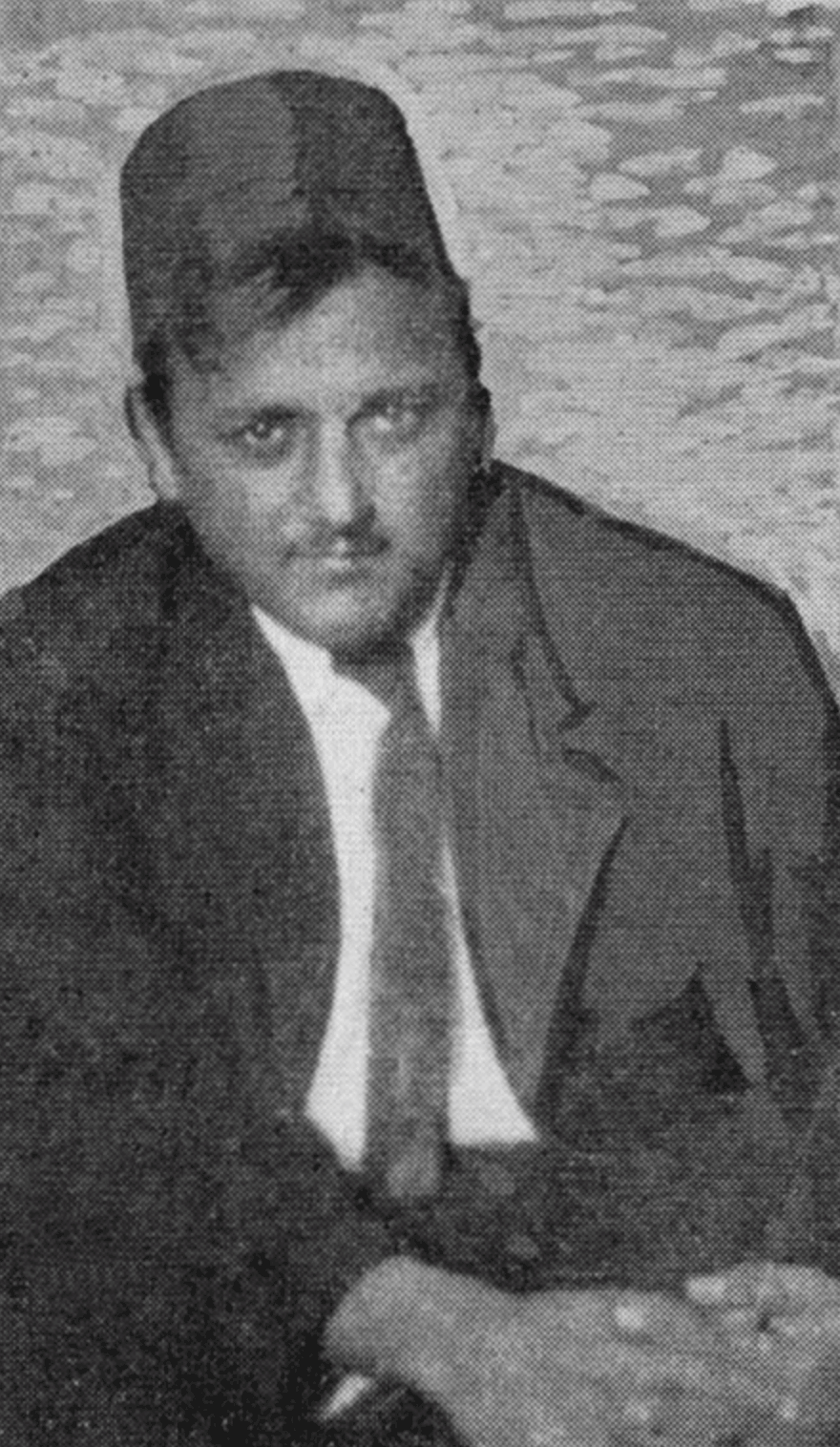
A portrait of Shoghi Effendi in 1930. Source: Bahaimedia.
The Guardian’s incoming mail was an avalanche that grew steadily as the years of his ministry advanced. No matter the volume of mail, it was Shoghi Effendi’s practice to open all the letters himself, in the event that its contents were confidential, for his eyes only.
Once the mail was opened and confidential information set aside, whether the letter was in English or Persian, the Guardian made another decision: whether he would answer it himself, or refer it to his English or Persian corresponding secretary for their response and his review and added handwritten postscript.
In the case of letters to be answered by his secretary for the West or the East, Shoghi Effendi would give his assistant copious notes on the basis of which they would prepare a draft, and submit it to the Guardian for verification. If the Guardian did not approve the drafted letter, the secretary would rewrite it with additional notes and instructions from Shoghi Effendi.
In the majority of cases, once the secretary’s draft was approved by Shoghi Effendi, he would usually add a postscript in his hand to the letter, followed by his signature. It was rare that the Guardian did not add a note to outgoing correspondence, but it did happen, occasionally.
In addition to the postscript, it was the Guardian’s practice to always add a closing phrase to the letter, after which he would simply sign Shoghi.
For his letters to the East, this closing phrase was always “The servant of His Threshold,” “His” referring to 'Abdu'l-Bahá.
For his letters to the West, in the early years of his ministry, Shoghi Effendi used various phrases such as
Your sincere co-worker in His Cause
Your brother and co-worker in His Cause
Your brother and co-worker
I am, as ever, you brother in His Service I am your devoted brother
I am your brother and fellow-worker
Your brother in His Service
I am your brother and co-worker Your brother
Mr. ‘Alí Nakhjávání remarks that these phrases coalesced, towards the end of 1923, to the phrase we are most familiar with,
Your true brother.
Mr. Nakhjávání goes on to explain that, in cases when the recipient—an institution or an individual Bahá'í—had accomplished noteworthy and admirable services that called for a special appreciation, Shoghi Effendi’s closing would sometimes change to:
Your true and grateful brother.
Shoghi Effendi was entirely transparent about his management of correspondence and he confirmed the above-described method of receiving mail in a letter dated 7 December 1930 to a New York Bahá'í, Marion Little, which was published in Bahá'í News, and in which he states categorically:
Concerning letters from Haifa. Whatever letters are sent in my behalf from Haifa are all read and approved by me before mailing. There is no exception whatever to this rule.
This sets to rest the matter of Bahá'ís making a distinction between letters written by the Guardian or on behalf of the Guardian.
The Guardian himself made no such distinction.
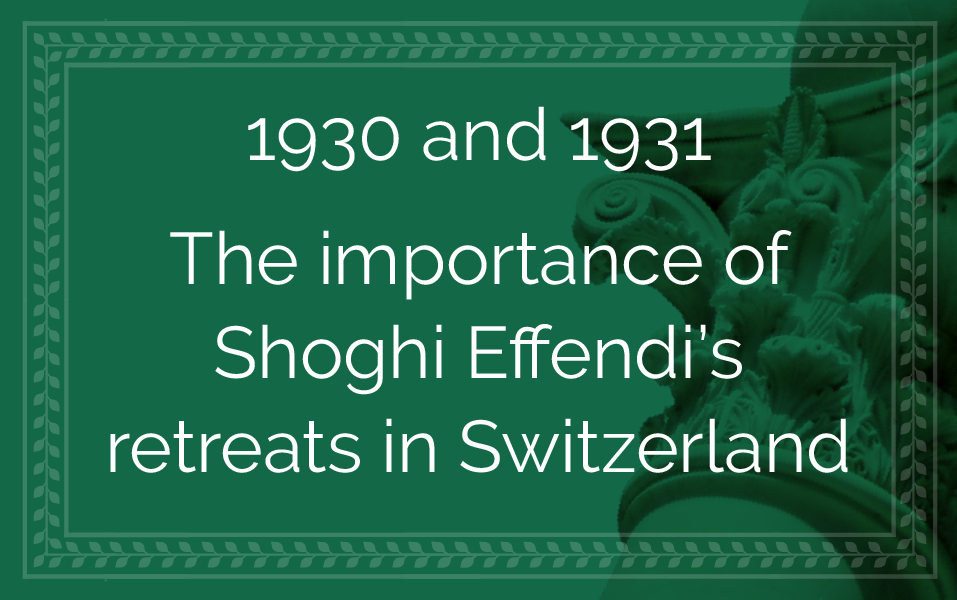

A photograph of the mountains around Interlaken, Switzerland, Shoghi Effendi’s favorite summer retreat. Source: Photo by Tanathip Rattanatum on Pexels.
Shoghi Effendi did not stay in Switzerland in the summer of 1929, as he traveled to England, and back to the Holy Land by crossing the continent of Africa overland.
It is exceedingly likely that Shoghi Effendi returned to the Swiss Alps in the summers of 1930 and 1931, even though no records exist of these trips. We know that during one or two of those summers early in Shoghi Effendi's ministry, he purchased a bicycle and rode over many mountain passes.
Because Shoghi Effendi’s 1932 summer stay in Interlaken was overshadowed by the passing of the Greatest Holy Leaf, this section is an homage to how much his respites in Switzerland meant to the Guardian.
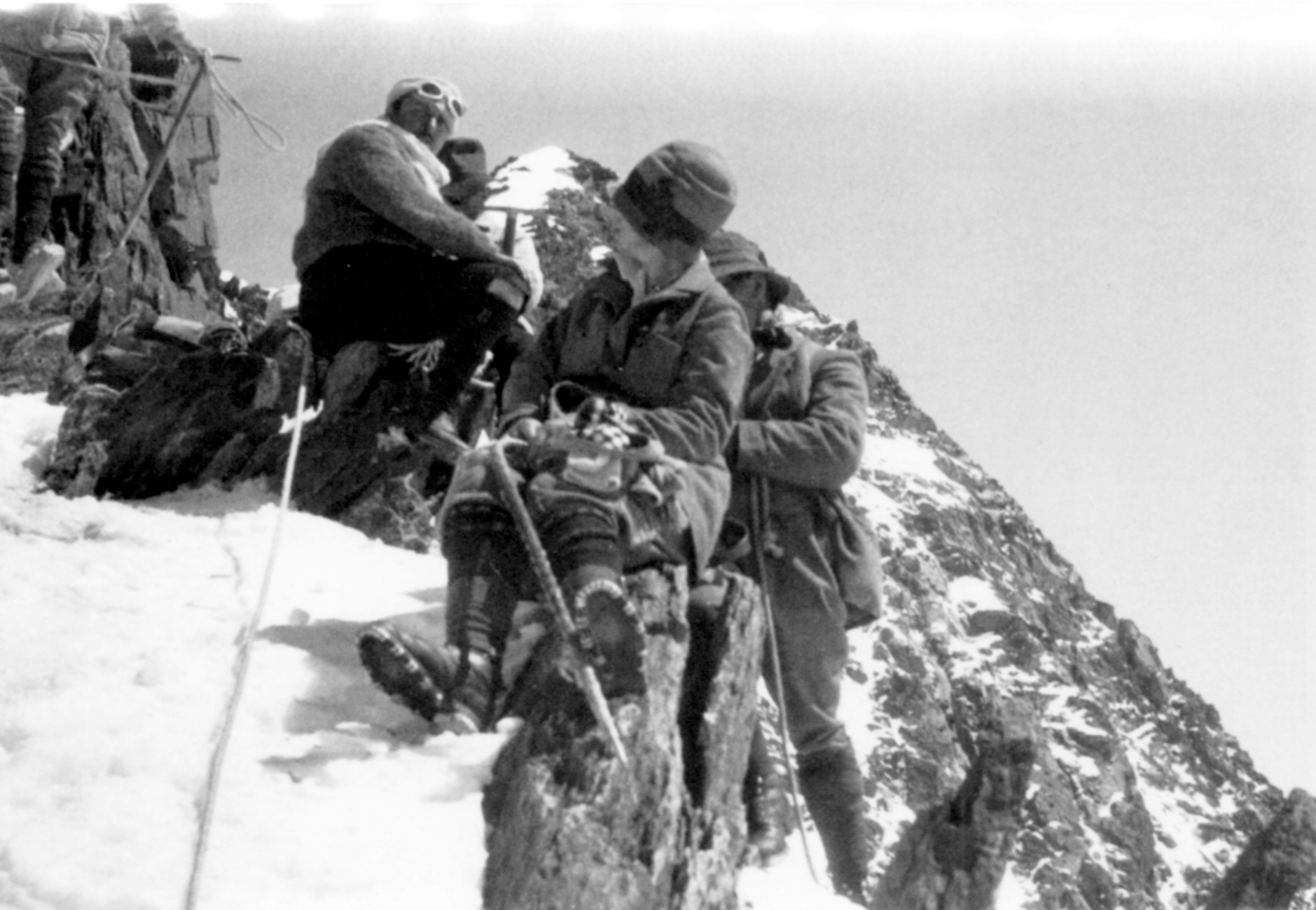
“The Guardian became a mountaineer”: Shoghi Effendi wearing goggles with a party of climbers and their guides in the Swiss Alps. Source: The Priceless Pearl.
Rúḥíyyih Khánum came to believe, thinking about the Guardian and Switzerland, that his deep love of natural scenery, inherited from Bahá'u'lláh and 'Abdu'l-Bahá, brought him to this landscape that became his second home. She believed that Shoghi Effendi’s exhausting and relentless hikes somehow healed, to whatever extent they could, the deep and painful wounds that scarred his heart, from having lost 'Abdu'l-Bahá, whom he worshiped.
Shoghi Effendi observed a sort of fast during his intense mountain marathons. He would never eat anything until he returned at night, and sat himself down in the restaurant of his small hotel, where he would order sautéed potatoes, fried eggs and salad, and fall into the bed of his tiny room, utterly spent.
Waking at night, Shoghi Effendi would drink a pitcher of cold mountain water, then return to bed until he awoke before daybreak, and as Rúḥíyyih Khánum says, “driven by this terrible soul-restlessness, he arose and set out again.”
Rúḥíyyih Khánum wrote that in the early years of his Guardianship, Shoghi Effendi was not only at his most distressed, but he was also hardest on himself.
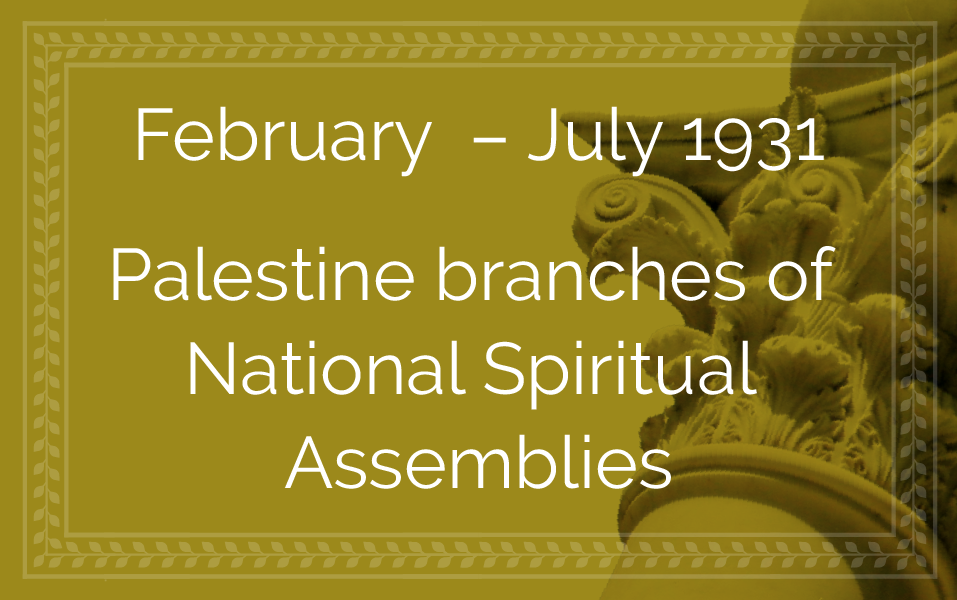
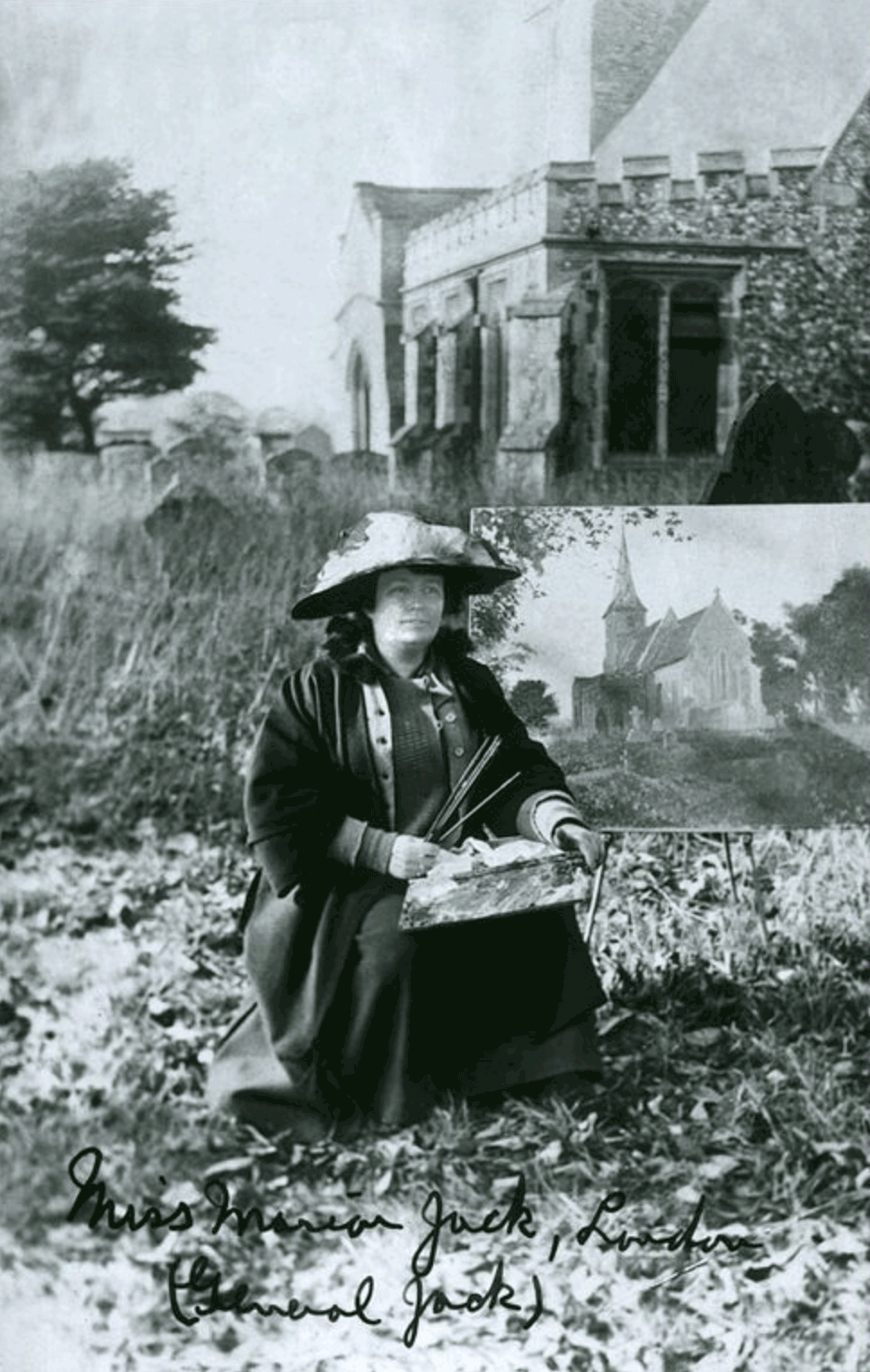
Marion Jack painting in London. 'Abdu'l-Bahá affectionately called her “General Jack.” Source: Bahaimedia.
'Abdu'l-Bahá had promised Marion Jack in one of the Tablets He revealed for her, that she would return to the Holy Land, and again visit Mount Carmel, and His promise was fulfilled when she arrived for a month-long pilgrimage, arriving on 17 February 1931.
Marion Jack stayed at the Western Pilgrim House and spent at least one night in Bahjí, where she completed two paintings, one of which is still displayed in Bahjí.
On the evening of 24 March, the day before the Thompsons and Alice were to leave, Shoghi Effendi took Marion, Emma and Louise to the Shrine of the Báb for prayer, chanting for them himself. He then asked Emma to recite the Tablet of Ahmad, after which he complimented her on doing so with ‘fervor, sincerity & devotion’.
During one of her visits to the Shrine of Bahá'u'lláh with Shoghi Effendi, and in the company of her pilgrim friends Emma and Louise Thompson, Shoghi Effendi asked Emma to chant the Tablet of Aḥmad, and later told the ladies this had been a very great privilege. No one but Shoghi Effendi usually prayed aloud in the innermost Shrine, it is a place of quiet contemplation and silent prayer.
The Guardian asked Marion Jack to visit Louise Gregory, Louis Gregory's wife and the other pioneers in Sofia, Bulgaria. Marion Jack, 65 and with a heart condition, stayed in Bulgaria for the rest of her life, with some absences.
The Guardian attached a great deal of importance to Bulgaria, because of Bahá'u'lláh’s five and a half year presence in Europe, in Edirne, the European part of Turkey. In fact, the Guardian closely associated Bulgaria with Bahá'u'lláh’s presence because in the 19th century, the province of Turkey Bahá'u'lláh had been exiled to was called Rumelia, and Bulgaria at the time did not exist, it was called Eastern Rumelia. In one of his letters to Marion Jack, Shoghi Effendi refers to Bulgaria as the portion of the Balkans chosen by God to receive the blessing of Bahá'u'lláh’s presence.
It is no wonder, then, that such a steadfast soul as Marion Jack always refused to leave her pioneering post.
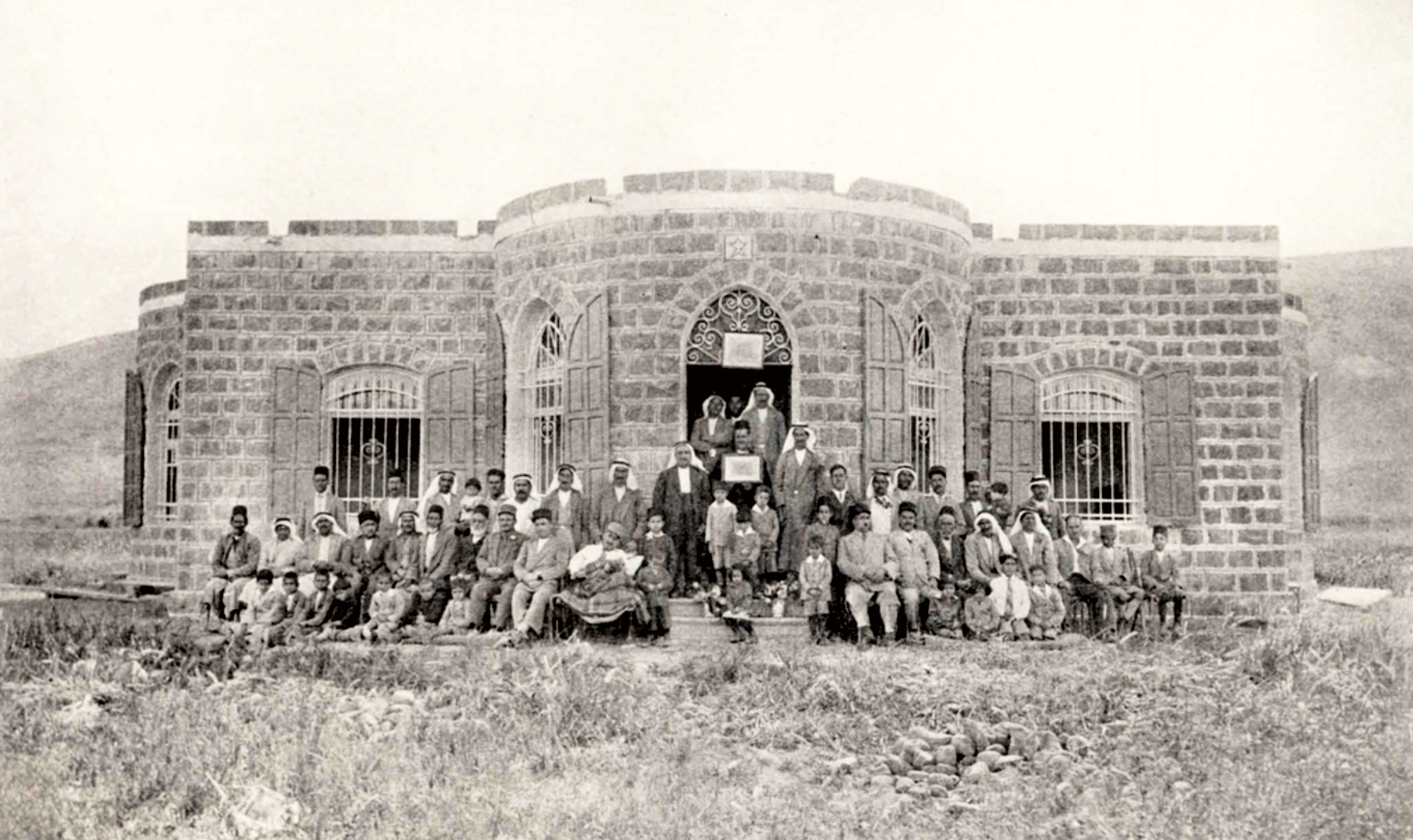
The Ḥaẓíratu’l-Quds (Local Bahá'í Center) of ‘Adasiyyíh in the 1930s. Source: Bahaimedia.
During one of His visits to ‘Adasiyyíh, one of the Bahá'í farming villages south of the Sea of Galilee in which He grew crops, 'Abdu'l-Bahá had pointed to the exact spot where they should build their local cemetery, Bahá'í Center and House of Worship.
The Bahá'í community of ‘Adasiyyíh was growing, and there was a need for a local center. The spot was precise. On 'Abdu'l-Bahá’s visit to ‘Adasiyyíh when He had indicated where the Bahá'í cemetery should be built, the Bahá'ís asked him about the location of the local Bahá'í Center.
'Abdu'l-Bahá was standing where He had indicated the cemetery should be built, and he pointed His finger to the south side of the cemetery. To this day the spot where He stood is still marked. 'Abdu'l-Bahá then asked the Bahá'ís to measure 95 meters from where He was standing, and then asked them to allow a perimeter of 150 meters from that point.
One day, when Shoghi Effendi was in ‘Adasiyyíh and visiting the Bahá'í cemetery, he asked about that spot that 'Abdu'l-Bahá had indicated. The Bahá'ís showed the spot to the Guardian and he told the Bahá'ís to take 95 steps from the southern border of the cemetery in the direction 'Abdu'l-Bahá had indicated.
That, the Guardian said, the exact spot indicated by 'Abdu'l-Bahá over a decade ago, would be the center of their local Ḥaẓíratu’l-Quds, their Bahá'í Center.
In 1931, the Bahá'ís of ‘Adasiyyíh finished construction on their two-story local Bahá'í Center, and to mark the occasion they gathered together, said prayers followed by consultations and ending with a celebration.
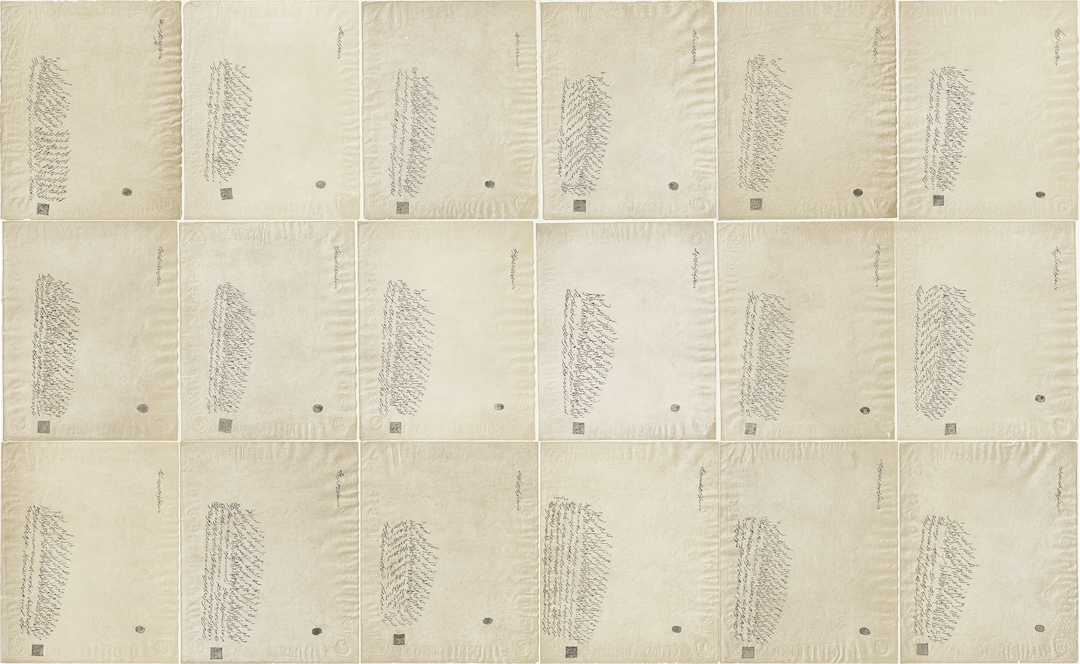
Facsimiles of the original Tablets revealed by the Báb to the Letters of the Living, His first 18 disciples, most of whom heroically gave their lives for His Cause. These are the Tablets referred to in the story below. Source: Nabíl, The Dawn-Breakers.
In March 1931, Shoghi Effendi announced with great joy to the pilgrims who were around the dinner table—Corinne True, Albert Windust, Effie Baker, among others—that he had, just that very day, discovered in 'Abdu'l-Bahá’s safe the original Tablets in the Báb’s Own handwriting to the Letters of the Living and to Bahá'u'lláh.
It was his plan to include pristine facsimile copies of these priceless Tablets at the beginning of The Dawn-Breakers, and he announced that he would be entrusting them to Albert Windust to bring them to America and begin the process of perfectly reproducing them.
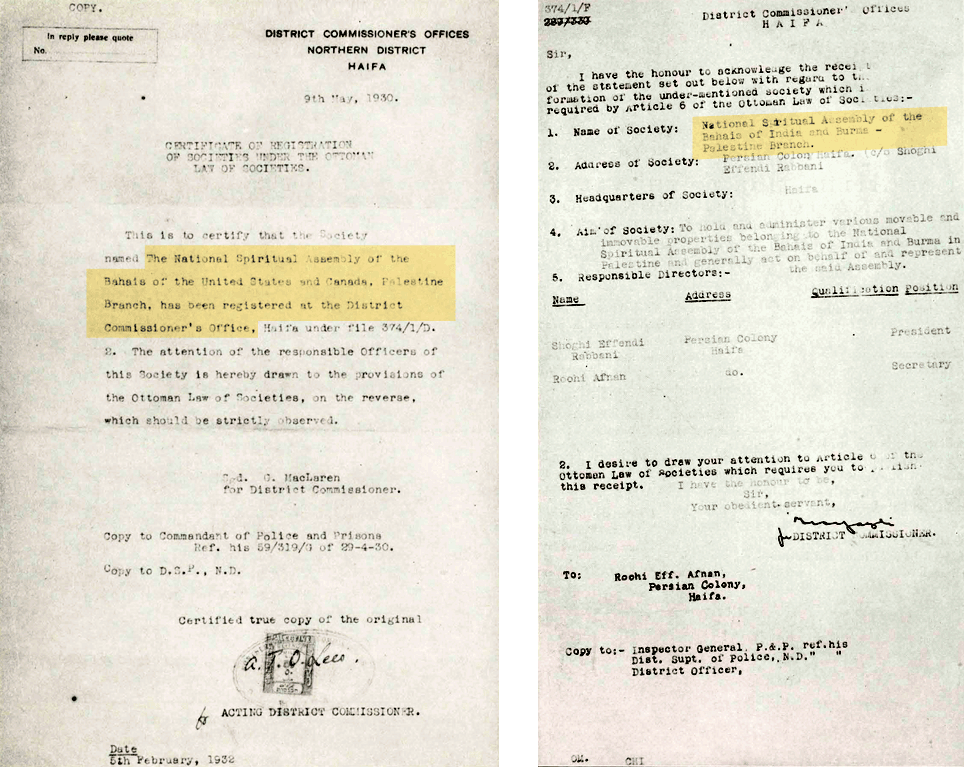
Left: Certificate of incorporation of the Palestine Branch of the National Spiritual Assembly of the Bahá'ís of the United States and Canada, dated 1932 (Bahaimedia); Right: Certificate of incorporation of the Palestine Branch of the National Spiritual Assembly of the Bahá'ís of India and Burma from the 1930s.
One of the Guardian’s most pressing goals during his ministry was to purchase land in British Mandate Palestine and in Israel, around the Shrine of the Báb and for the future Bahá'í House of Worship on Mount Carmel, and around the Shrine of Bahá'u'lláh, in Bahjí.
This was how the Guardian made Bahá'u'lláh’s vision of the Bahá'í World Centre in the Tablet of Carmel a reality.
One of Shoghi Effendi’s innovations was to incorporate, during his Guardianship, nine National Spiritual Assemblies as religious organizations in the Holy Land. These were called first Palestine Branches, then Israel branches of National Spiritual Assemblies.
The Guardian began this process in May 1931 when he cabled the National Spiritual Assembly of the United States and Canada, informing them of the incorporation:
American Assembly incorporated as recognized religious body in Palestine entitled hold property as trustees American believers. Mailing title deed property already transferred their name. Prestige Faith greatly enhanced its foundations consolidated love.
Branches of both the American and Indian Bahá’í National Spiritual Assemblies were enabled to function as “religious societies,” in accordance with the laws of the country, and to hold and administer property as agents of these Assemblies.
These Palestine/Israel branches functioned in Palestine/Israel as religious organizations and thus, in accordance with the laws of the country, able to hold and administer property as agents of these National Spiritual Assemblies.
This had several important implications: the international endowments of the Bahá'í Faith in the Holy Land were truly international, held worldwide by various branches of National Spiritual Assemblies, which greatly increased the prestige through this international partnership, the Bahá'í Holy Places were safeguarded and its world character emphasized in the eyes of the government, and national Bahá'í communities were encouraged and strengthened.
At the time of Shoghi Effendi’s passing there were Israel branches for the National Spiritual Assemblies of the United States, Canada, Australia, New Zealand, the British Isles, Persia, Pakistan, Alaska, and the National Spiritual Assembly of India and Burma.
The Palestine Branch of the National Spiritual Assembly of India and Burma was the first legally constituted Bahá'í institution of the eastern world.
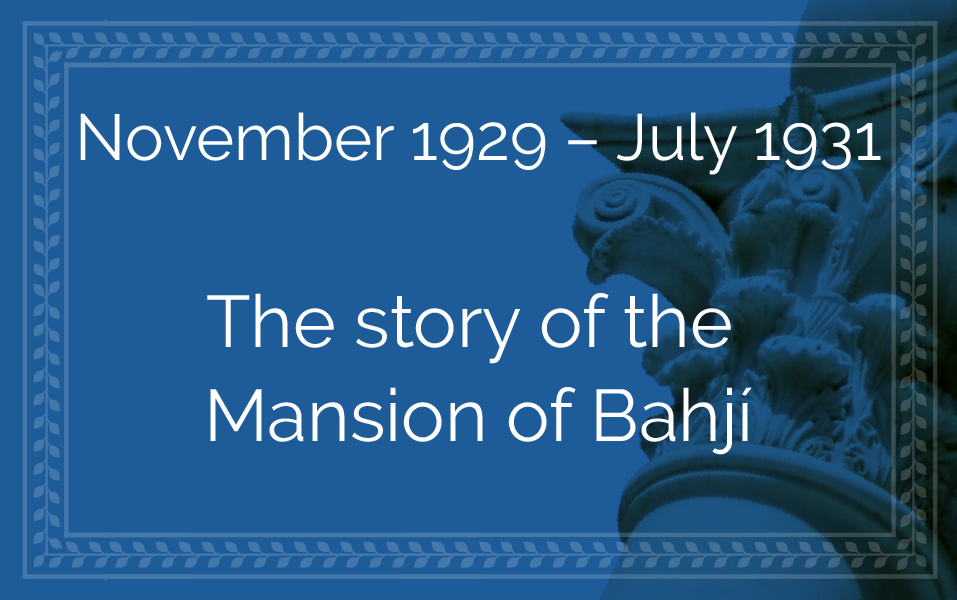
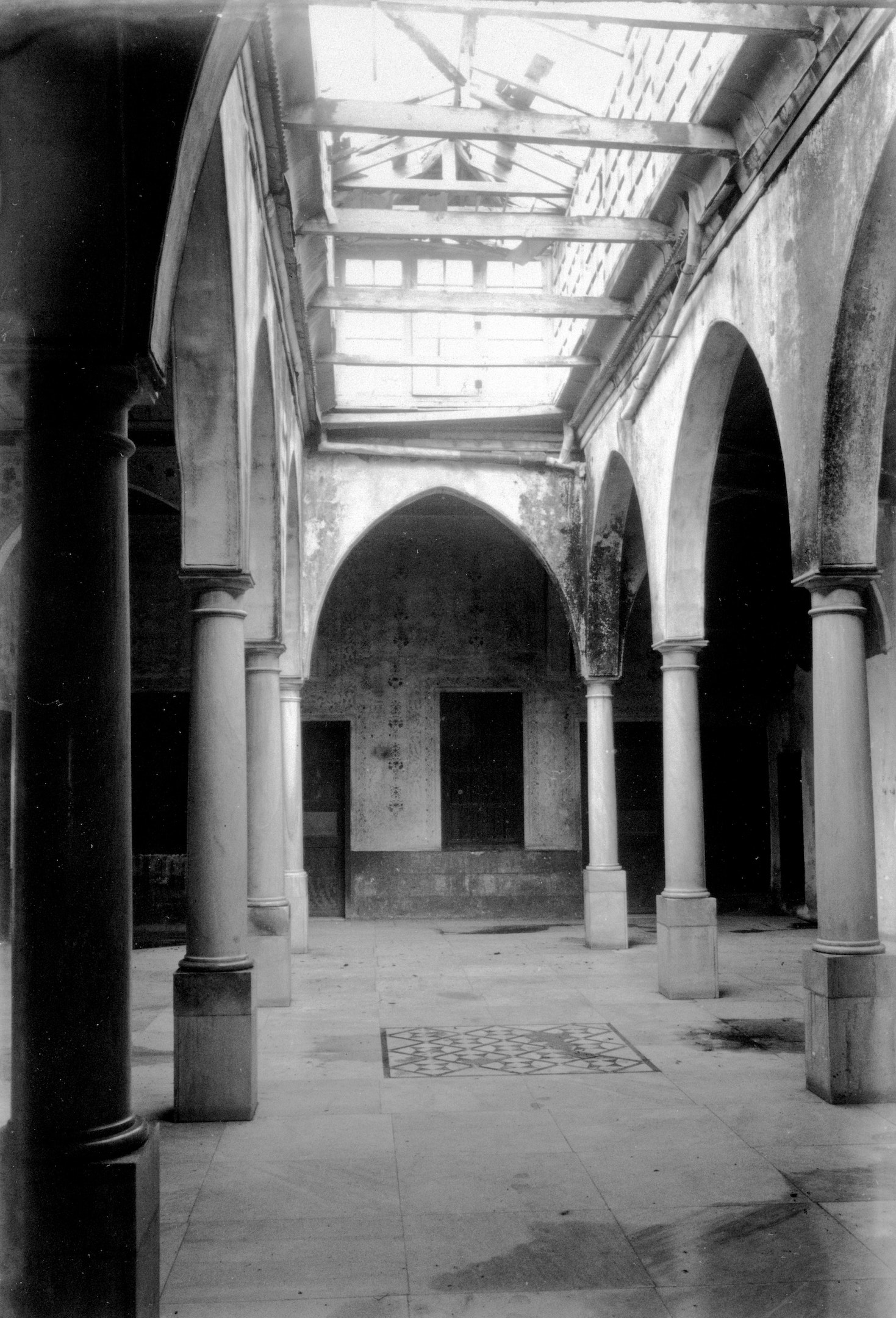
The main hall of the Mansion of Bahjí just before the Guardian began its restoration in 1929. Source: Bahá'í Media Bank, © Bahá'í International Community 2023.
After Bahá’u’lláh’s ascension, Covenant-breakers occupied the Mansion of Bahjí. First, Bahá'u'lláh’s second wife, Fáṭimih Khánum and her children, then Mírzá Muḥammad-'Alí. For 39 years, the Greatest Holy Leaf never set foot in the Mansion, her Blessed Father’s final earthly home, and the place where He passed away.
Mírzá Muhammad-‘Alí, the arch-breaker of the Covenant and other Covenant-breakers continued living in the Mansion of Bahjí for 25 years after Fáṭimih Khánum died in 1904.
They had neglected the Mansion so badly that by 1929, it was falling apart: the roof was caving in and the building needed major repairs were unwilling to undertake. Shoghi Effendi offered Mírzá Muhammad-‘Alí to repair the Mansion if they moved out, and they had no choice but to vacate.
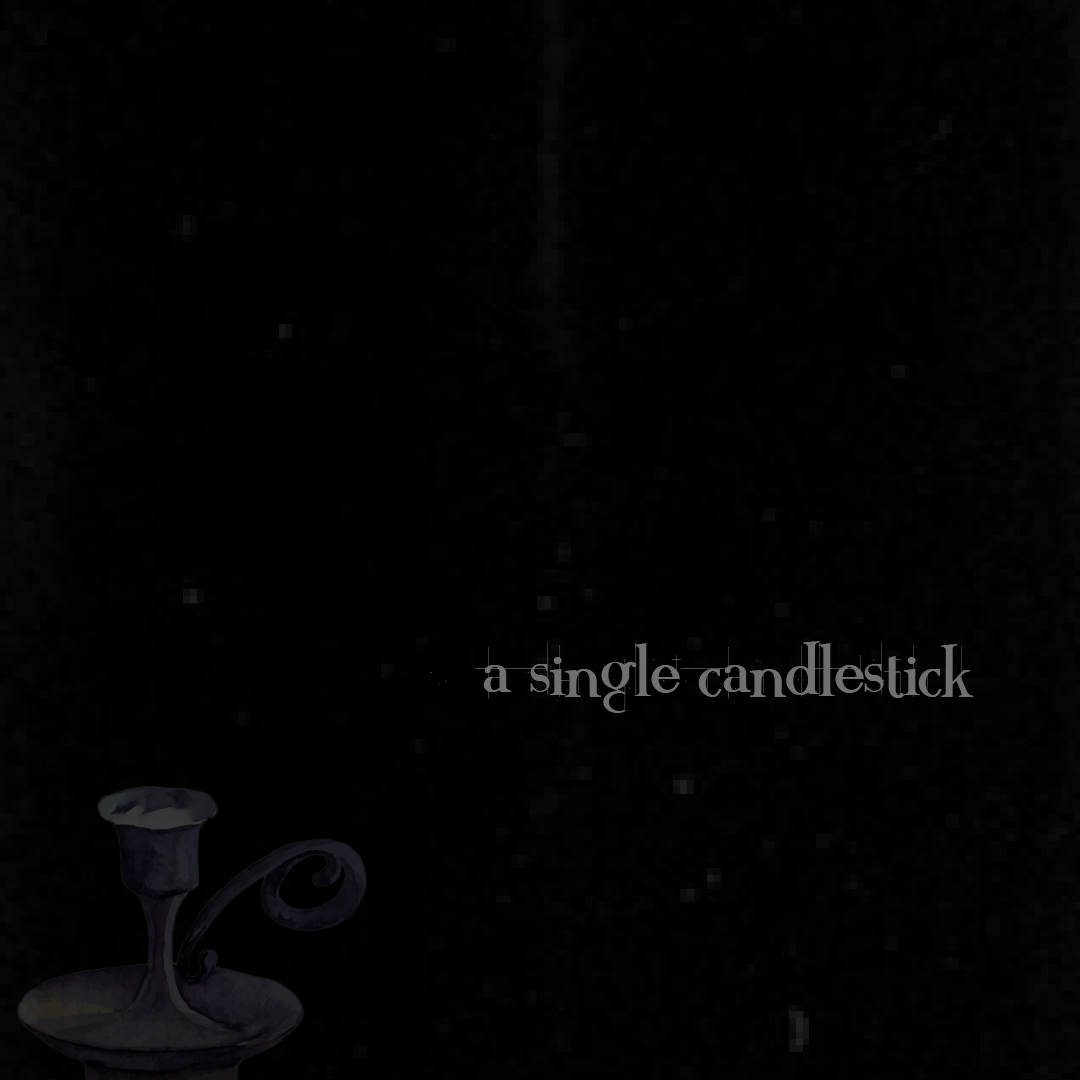
Finally, on 27 November 1929, the Mansion of Bahjí was again in the hands of the Faith, freed of the Covenant-breakers, but it was in ruins. The Covenant-breakers had stripped the Mansion down to its walls. The only thing Shoghi Effendi found in the Mansion when he took possession of it was a single candlestick in Bahá'u'lláh’s room. They had stolen every last precious relic.
The gardens were destroyed. All the trees were thirsting for water, on the verge of death, the fabulous orange and tangerine trees had withered.
Shoghi Effendi was away from Haifa when Yadu’lláh Tabrízí—who served in the Holy Land for 40 years—finally handed the Greatest Holy Leaf the keys to the Mansion. The first thing Bahíyyih Khánum told Yadu’lláh was:
Do water the trees well so that they will become verdant by the time [Shoghi Effendi] returns.
By the time Shoghi Effendi returned—possibly from his 1930 summer stay in Switzerland—the trees were green.
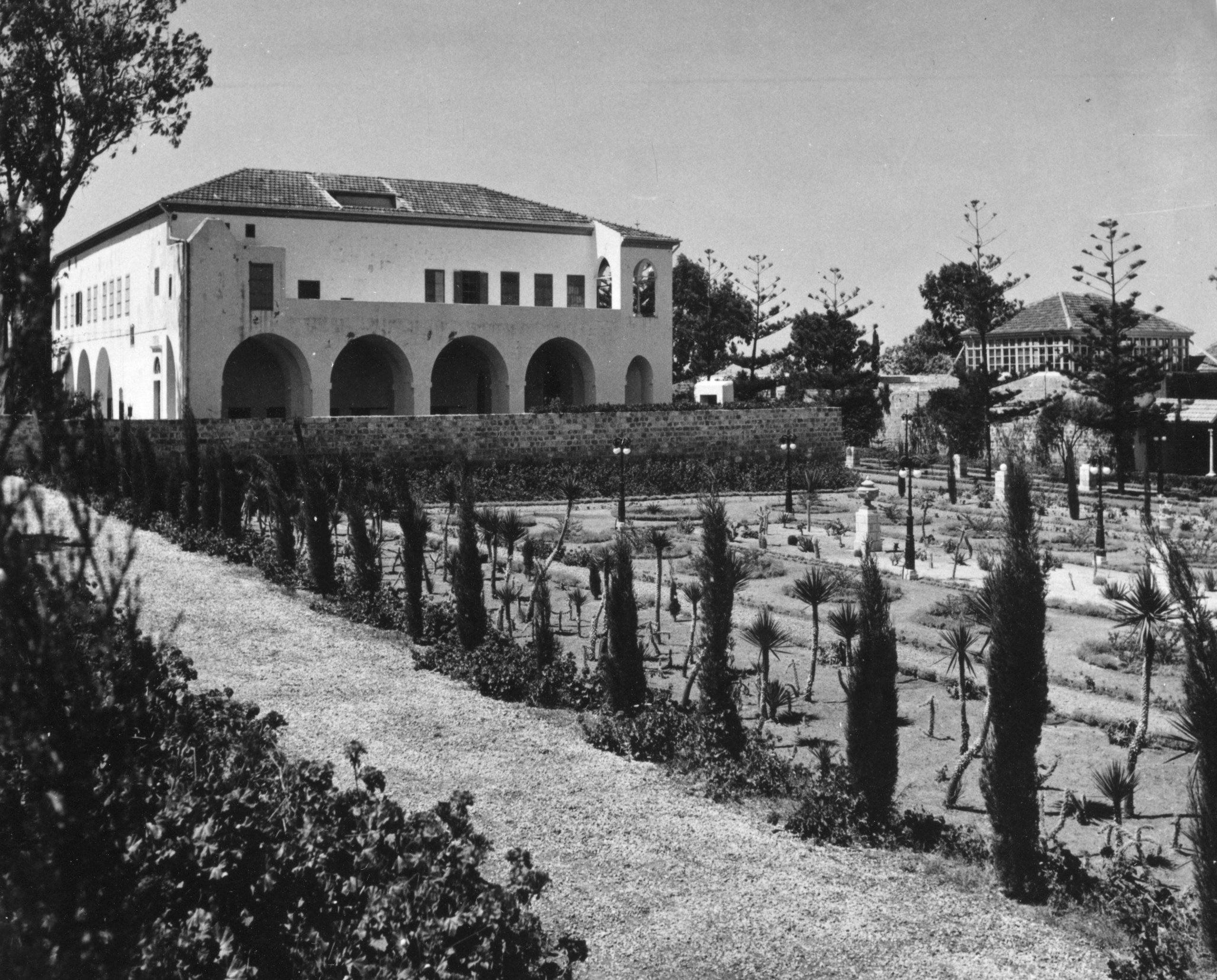
The Mansion of Bahjí and its surrounding gardens in 1958. Source: Bahá'í Media Bank, © Bahá'í International Community 2023.
Immediately after the Covenant-breakers had evacuated Bahjí and released it from their stench, the Guardian began beautifying the small plot of land to the north and west of the Shrine of Bahá'u'lláh and the small strip enclosed between the wall of the Mansion of Bahjí’s garden and the eastern side of the Shrine—the small edifice which had been used as an early Pilgrim House.
The Guardian planted tangerine trees and Araucaria—large, straight-as-an-arrow with horizontal, spreading branches covered in leathery needles. He also planted cypresses and orange trees in front of the Shrine of Bahá'u'lláh.
The remainder of the new land was a sea of sand, dotted, in places, by sand dunes. There was a large, deep pit, about a 130 meters away from the door of the Shrine of Bahá'u'lláh, which the Covenant-breakers had dug either to gather sand or to begin building something.
To the west, behind the Shrine, were olive and eucalyptus trees and very old pine trees which had already been standing at the time of Bahá'u'lláh, providing their shade even then. For four decades, these pines had been the only source of shade during the Holy Land’s brutal, torrid summers.
By 1952, the entire land of the Ḥaram-i-Aqdas would be transformed into a heavenly garden, but first, the Guardian had to restore the Mansion of Bahjí.
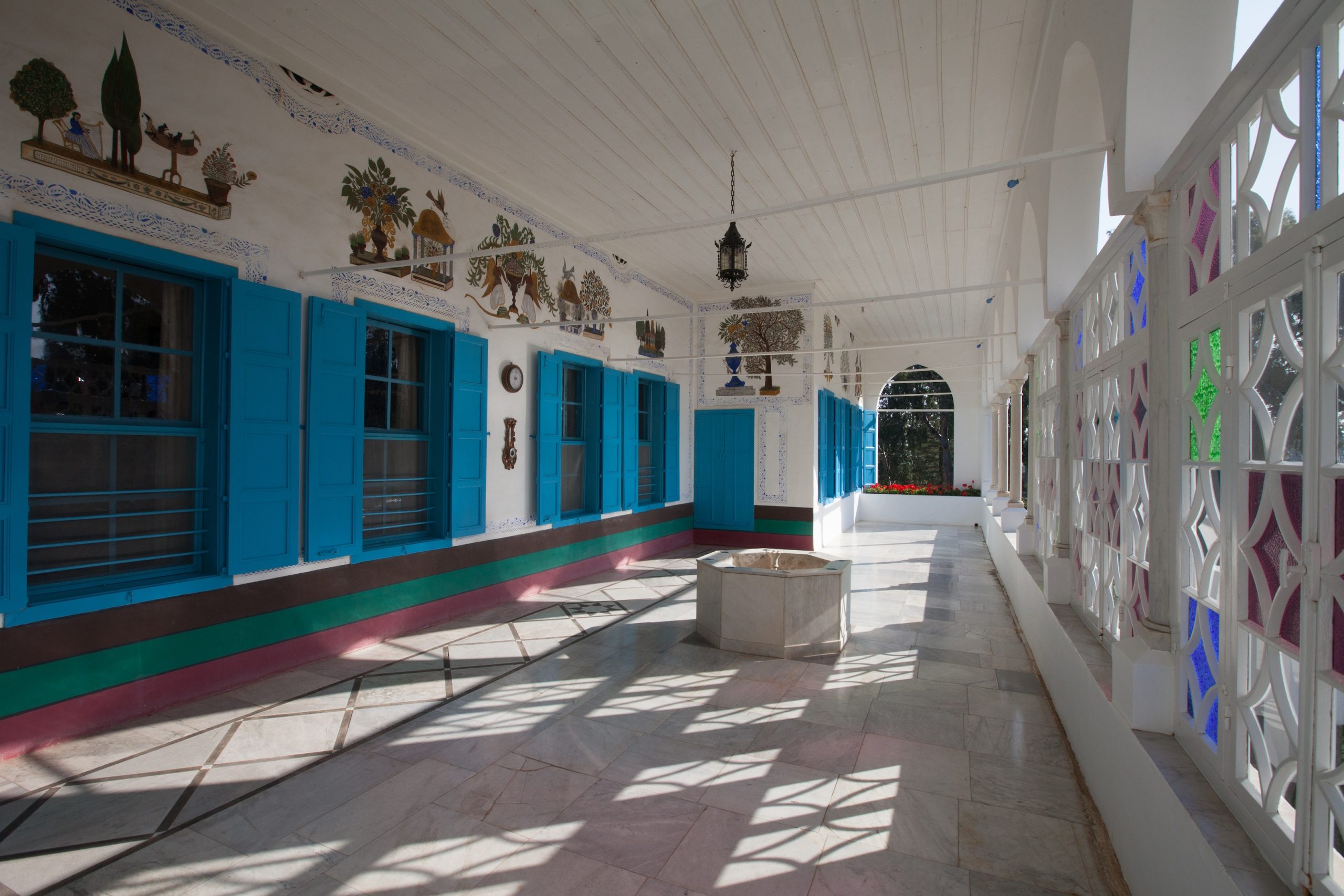
Balcony of the Mansion of Bahjí. Source: Bahá'í Media Bank, © Bahá'í International Community 2023.
Shoghi Effendi applied the same love of bargaining and ingenuity he displayed in building his gardens to decorating the Holy Places. He decorated the Mansion of Bahjí, the Mansion of Mazra’ih, the House of ‘Abbúd, the interiors of the Shrines of Bahá'u'lláh and the Báb, with singularly phenomenal taste.
Over the years, in Haifa, a large collection of beautiful antiques, period pieces, really, grew from the gifts of Bahá'ís and pilgrims. Shoghi Effendi used these gifts as well as ornaments he always bought at bargain prices, and ensured that decorating the Holy Places, came at the smallest possible cost for the Bahá'í world, always spending as little money as he could from the international funds and the Ḥuqúqu’lláh so sacrificially donated by the worldwide Bahá'í community.
After purchasing the items, the Guardian displayed a creative genius for decoration and design. He managed to gather together disparate elements—Japanese sculptures, Chinese lacquer cabinets, Persian carpets, English stone ornaments, in a way that they all looked like they not only fit together, but created what can only be described as a purely Bahá'í design of harmony in diversity.
Technically, artistically, the way the Guardian combined so many different styles and art periods should not have worked. It should, normally, have clashed and looked garish. But that was where Shoghi Effendi’s genius for design, and his artistic sense lay: he brought it all together, and made it a uniquely Bahá'í design.
Shoghi Effendi sublimated the Holy Places on a budget that would have floored any antiques dealer, and gathered them together in a harmonious whole in a way that continues to amaze professional interior decorators.

On 7 October 1930, Ruth White again wrote to the High Commissioner in Palestine saying that she had hired a British criminologist named Dr. Ainsworth Mitchell in England and sent him a photograph of ‘Abdu’l-Bahá’s Will. Dr. Ainsworth Mitchell—who, like Ruth White, could not read Persian—declared that the Will was a forgery but also stated that he could not give a final opinion without seeing the writing in the original.
After requesting that she send them copies of the photographed Will that she had supplied to Dr. Mitchell, the Government of Palestine contacted the Governor of Haifa who asked that Shoghi Effendi allow an expert to examine the Will and Testament.
The expert studied the Will and Testament of 'Abdu'l-Bahá with the copy that Ruth White had sent him and officially stated that they were identical, and written by the same person, and that Dr. Ainsworth Mitchell was incompetent.
Ruth White’s claim was so unfounded and ridiculous that the most undeniable proof of her insanity was that none of the prominent Covenant-breakers who could read Persian or Arabic ever took her side, backed her claims, or dared bring up the claim of the inauthenticity of the Master’s Will and Testament. Ahmad Sohrab and Faydu’lláh Subhi had both served Abdu'l-Bahá as His secretary and were intimately familiar with his writing and style. They knew, beyond the shadow of a doubt that the Will was authentic.
The Guardian had sent out photostatic copies, perfect, clear facsimiles of the Will to National Spiritual Assemblies around the world, but also to individual believers in Persia. Thousands of Persian-speakers had seen the original Will, and even 'Abdu'l-Bahá’s unfaithful family, even notorious Covenant-breakers, like the Arch-breaker of the Covenant, Mírzá Muḥammad-'Alí—who was strongly condemned in the Will—even his devious brother, Mírzá Badí’u’lláh, never questioned its authenticity.
The authenticity of the Master’s Will and Testament was not just a matter of 'Abdu'l-Bahá’s distinctive handwriting or his recognizable seals.
Another criterion for the Will and Testament of 'Abdu'l-Bahá’s authenticity was Abdu'l-Bahá's unique style and mode of expression, which was deeply familiar to all the Persian Bahá'ís. 'Abdu'l-Bahá’s style in Persian and Arabic was very characteristic and inimitable.
Abdu'l-Bahá's Will was 12 pages long in three parts, written at three different times in His life between 1901 and 1908. All three parts were in His handwriting, each was signed by the Master, and the envelope in which the Wills were contained was addressed to Shoghi Effendi, folded down and contained three signatures of 'Abdu'l-Bahá across the flap where the envelope was folded and sealed.
'Abdu'l-Bahá Himself had ensured the authenticity of His Will could never be denied.
The only challenge to the Will and Testament of 'Abdu'l-Bahá was from Ruth White, an American who did not read or understand Persian, and whose ulterior motive was to discredit the Administrative Order she had opposed for a decade because she didn’t understand it.
Only Ruth White ever pushed this deluded and completely unfounded claim.
All Ruth White managed to do with her baseless accusations was stir up a cloud of toxic dust and add more anxiety to the Guardian’s already full plate. Because of her actions, on top of everything else he had to do, the Guardian had to be on constant alert, increasingly vigilant, all at a time when he was immersed in his endless work.
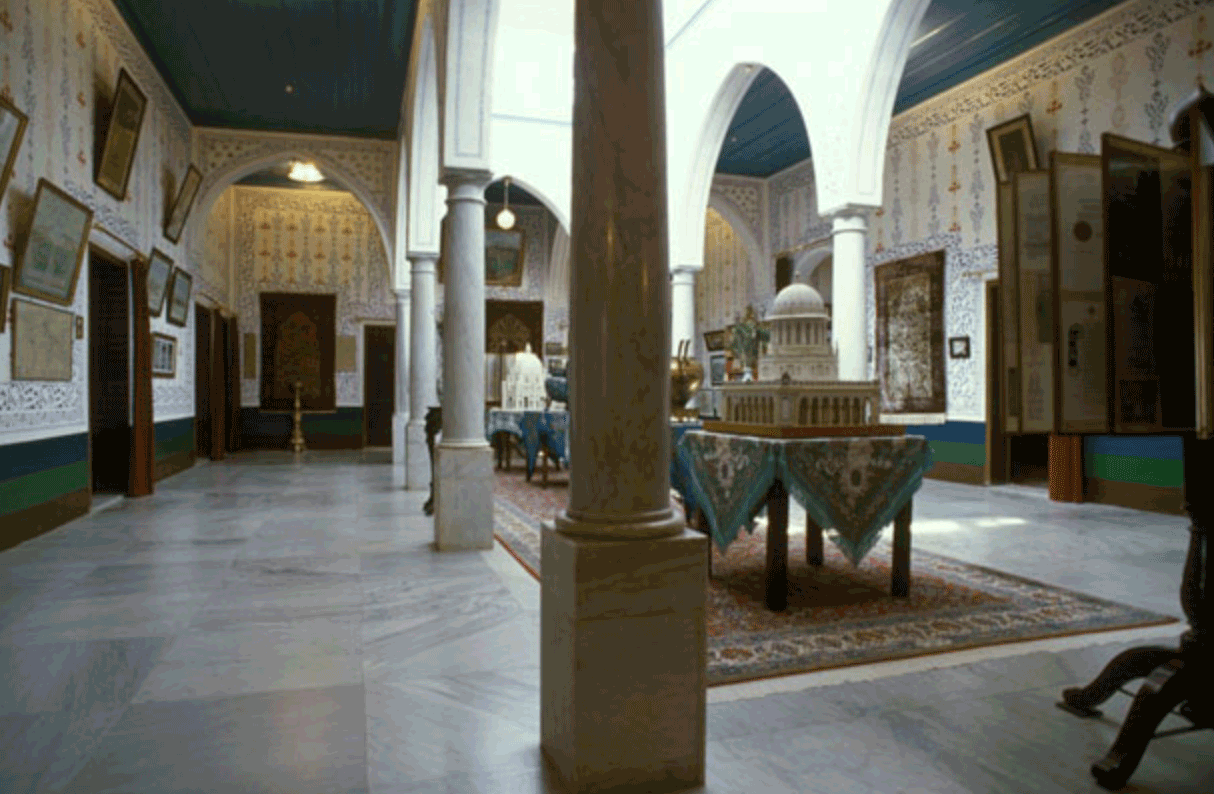
The Central Hall of the upper floor of the Mansion of Bahjí, entirely decorated by Shoghi Effendi. Source: Bahaimedia.
The Guardian undertook a compete restoration.
First, he renovated the Mansion. He fixed the roof, the walls, the floors, the woodwork, the frescoes on the balcony, the intricate stenciled decoration on the walls of the rooms on the upper floor, the fine wood beam ceilings.
Second, he tastefully and elegantly decorated the Mansion. He spread out the valuable rugs sent by the Bahá'ís in Persia, he hung rare illuminations in the writing of the famous Bahá'í calligraphist, Mishkín-Qalam, placed priceless sacred relics throughout the Mansion, hung countless of photographs and important Bahá’í historical documents on the walls, and filled the bookshelves of the Mansion with over 5,000 volumes of Bahá’í literature in 40 languages.
Third, Shoghi Effendi electrified the Mansion of Bahjí, fulfilling one of 'Abdu'l-Bahá’s longstanding dreams. Curtis Kelsey, an American Bahá'í who had arrived in the Holy Land 8 years ago in September 1921 to begin installing electric generators for the Holy Places at 'Abdu'l-Bahá’s request, completed the work for Shoghi Effendi.
Fourth, Third, the Guardian invited the British High commissioner to visit the Mansion, accompanying him on the tour of inspection himself. Shoghi Effendi asked His Excellency if the Mansion wasn’t more than a mere individual’s residence, if it did not deserve to be considered a holy place, with sacred meaning to pilgrims and Bahá'ís all over the world, and conserved as such. The British High Commissioner agreed, and the Mansion of Bahjí remained in Shoghi Effendi’s hands and he obtained a tax exemption from the British government for the Mansion—a tax exemption which already applied to other Bahá'í institutions and properties in 'Akká and Haifa.
Fifth, Shoghi Effendi had the Mansion of Bahjí’s statute converted from a private residence to a center of pilgrimage.
Shoghi Effendi accomplished all of this in 18 months, and the Mansion was ready by July 1931, when the first visitors arrived.
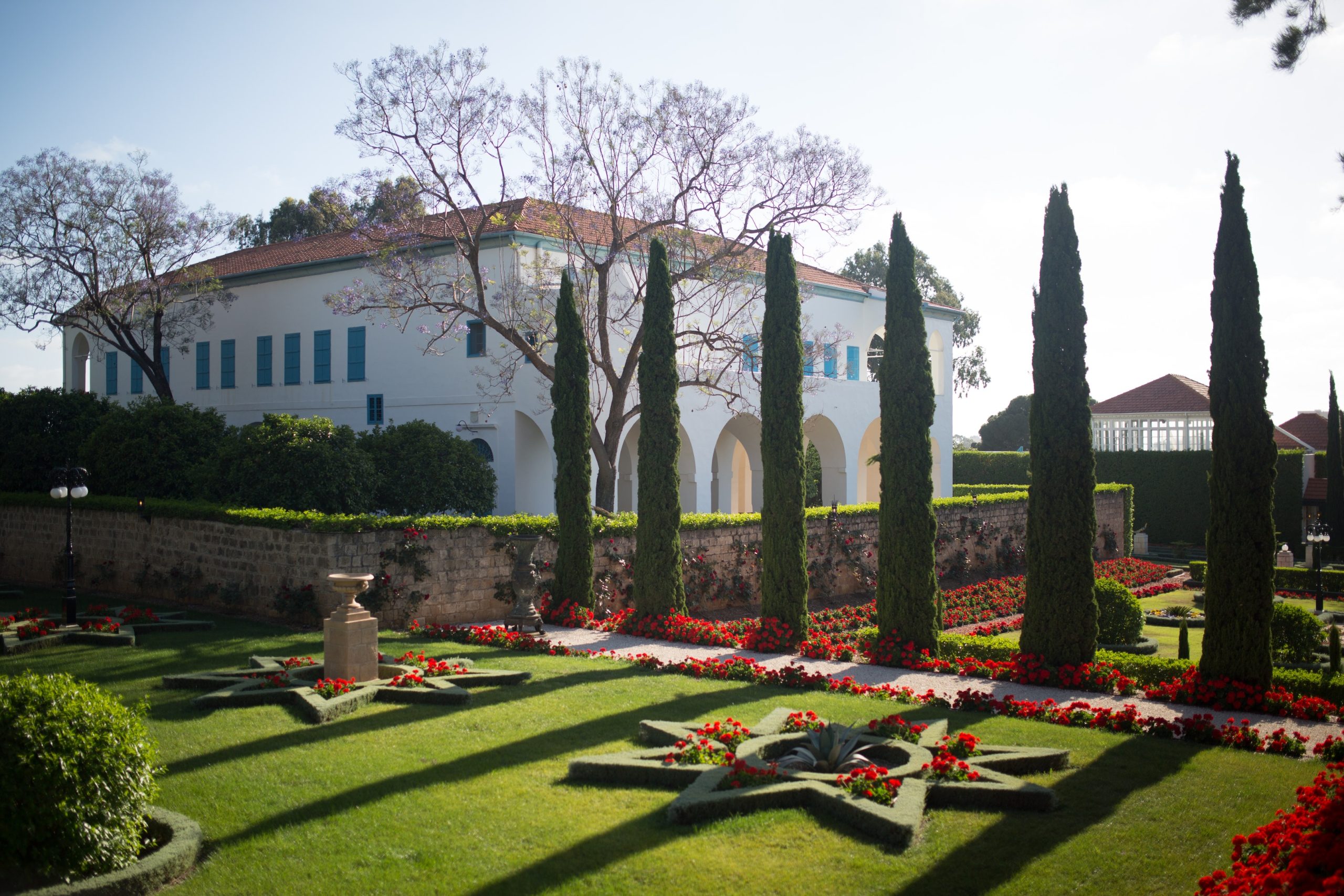
The Mansion of Bahjí, its surrounding gardens, and the Shrine of Bahá'u'lláh in the background. Source: Bahá'í Media Bank, © Bahá'í International Community 2023.
At long last, the Arabic inscription ‘Údí Khammár had placed in 1870, engraved on a marble tablet above the door of the Mansion of Bahjí was again prophetic, after four decades of occupation by the Covenant-breakers—as it had been when Bahá'u'lláh occupied the Mansion:
Greetings and salutations rest upon this Mansion, which increaseth in splendour through the passage of time. Manifold wonders and marvels are found therein, and pens are baffled in attempting to describe them.
When his restoration of the blessed Mansion was complete, the beloved Guardian arranged an elaborate surprise for the Greatest Holy Leaf to come and see how it had been furnished and decorated. He wanted her to be the first person to spend time at the Mansion of Bahjí.
A car brought the Greatest Holy Leaf to Bahjí with three people. When they arrived, the big southern entrance door was opened, and she stepped into the courtyard of the Mansion.
The Greatest Holy Leaf was 85 years old and too weak to climb the stairs, so a large chair was brought and Yadu’lláh Tabrízí and another Bahá'í carried her to the upper floor like a queen, and placed the chair down in the central hall of the Mansion.
As soon as the Greatest Holy Leaf entered the hall, she exclaimed loudly, weeping and laughing simultaneously:
O Bahá’u’lláh! The Guardian of your Cause has repaired, furnished and decorated your blessed Mansion. O 'Abdu'l-Bahá! What a wonderful Guardian you have chosen for the Cause of God! He has restored the glory of the blessed Mansion.
The Greatest Holy Leaf asked to see Bahá'u'lláh’s bedroom, the room in which her Father had passed away.
The Greatest Holy Leaf had thought of brining boxes of baklava—a very sweet, nutty, layered pastry dessert popular in the Middle East—for the Bahá'ís that day and the visitors, Bahá'í and non-Bahá'í who were coming to the Mansion the following day.
Bahíyyih Khánum spent six very happy days around the Mansion of Bahjí and the Shrine of Bahá'u'lláh. She spent one night in the Mansion and the other five in the pilgrim house.

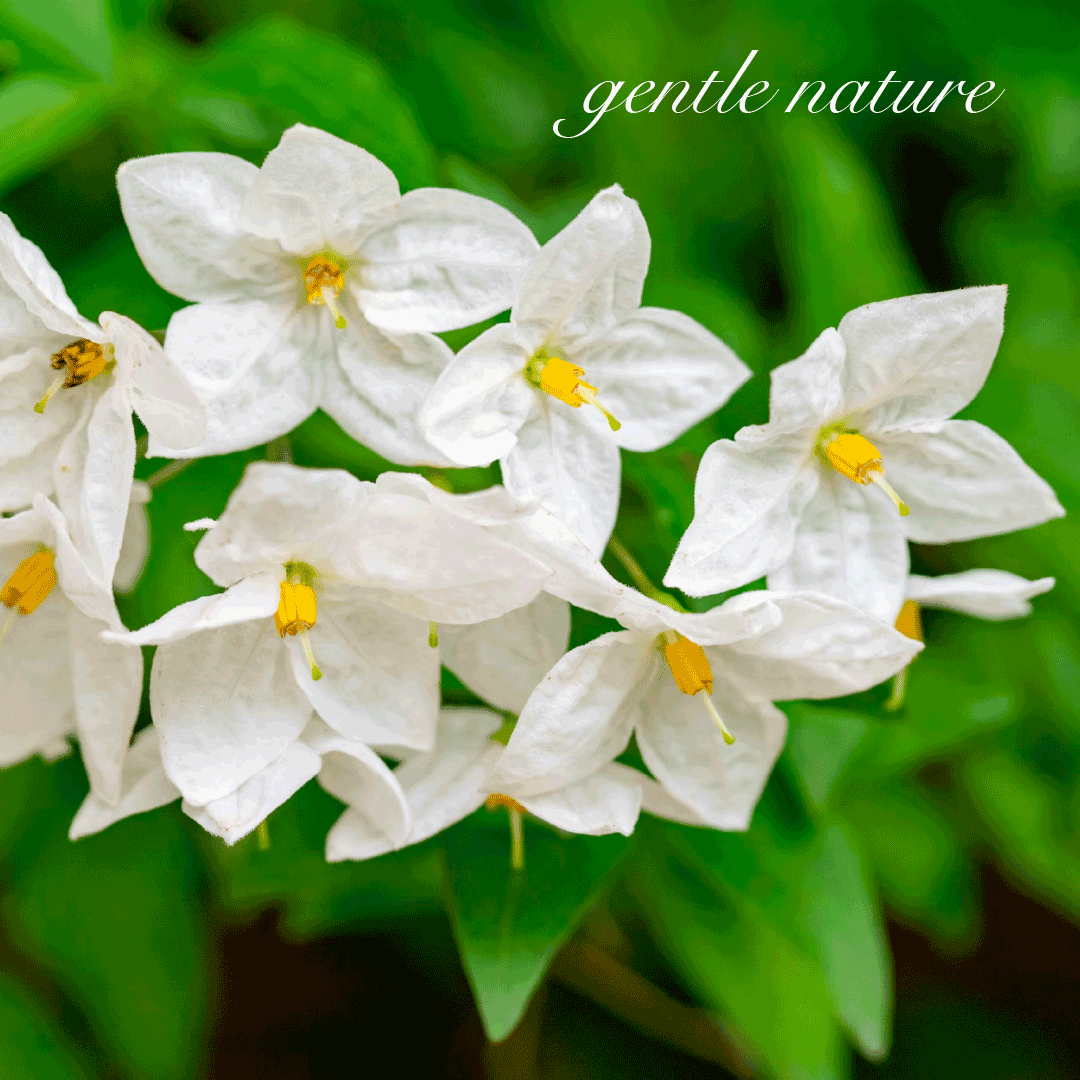
Background photo of jasmine, Shoghi Effendi’s favorite scent, by Geraldine Dukes on Unsplash.
Before a section in which various facets of Shoghi Effendi’s personality are extolled in detail, the first introduction to the entirety of Shoghi Effendi’s personality is a composite drawn from the first pages of Ugo Giachery’s memoirs of ten years at his side.
From the start of his Guardianship, Shoghi Effendi’s personality arose in crystalline clarity for those who were privileged to associate closely with him, and its many facets were a marvel, which, combined with the Guardian’s pure genius, lit, in all those privileged to serve him, an irrepressible admiration and an undying loyalty.
Shoghi Effendi had an eagerness for learning, a passion for knowledge and a drive for understanding. He had a refined artistic sense combined with a superhuman ability for pure action, and he was endowed with remarkable energy. Shoghi Effendi also had superior common sense—a quality which 'Abdu'l-Bahá had always displayed—but he was endowed with unique spiritual powers, and people who came in close contact with him were subjugated by his personality and spiritual qualities.
Shoghi Effendi was endowed with an indomitable will and extraordinary powers of self-control, which had been evident in the first months of his Guardianship in the way that he stoically bore not only the tragedy of the loss of his adored Grandfather, but the implications of the mantle of Head of the Bahá'í Faith which had been so suddenly and so unexpectedly dropped onto his shoulders at the age of 24.
The Guardian’s new station, new responsibilities, and new life had forced Shoghi Effendi to say farewell to who he had been and what he had loved: his youthful dreams, his fondness for sports, his love of photography. 28 November 1921 was a point of no return for the Guardian: all his worldly desires, interests, hobbies, feelings, emotions, were crushed to dust, scattered in the wind, with his new station as Guardian of the Cause.
Shoghi Effendi had a very gentle nature, and shared one characteristic which the three Central Figures of the Bahá'í Faith had all manifested in their life: exactly like the Báb, Bahá'u'lláh, and 'Abdu'l-Bahá, the Guardian had an otherworldly sense of courtesy, a lifelong trait that manifested itself in a myriad of deeply touching moments, and a quality very closely to his immense sense of reverence concerning with regards to everything concerning the faith.
Shoghi Effendi had a prodigious, astounding memory: he could remember and recall perfectly dates, places and circumstances with a clarity that aroused respect and admiration. This colossal faculty of memory was not limited to the history of the Bábí and Bahá'í Revelations, far from it. Shoghi Effendi, at all times, was in possession of full, comprehensive and detailed knowledge of the world and its nations, peoples, governments, religions, history and culture, and current events.
An overwhelming of striking purity, innocence and integrity emanated from Shoghi Effendi, making him the perfect vehicle for the tremendous divine forces channeled and coursing through him at all times, the source of his infallibility.
Shoghi Effendi exuded vitality, energy, and an infinite capacity for hard work, and he spoke with a modulated and resonant voice, speaking eagerly and passionately about the progress of the Faith, able to convey perfectly the very depths of his thoughts, which exerted on the listener a complete and captivating fascination.
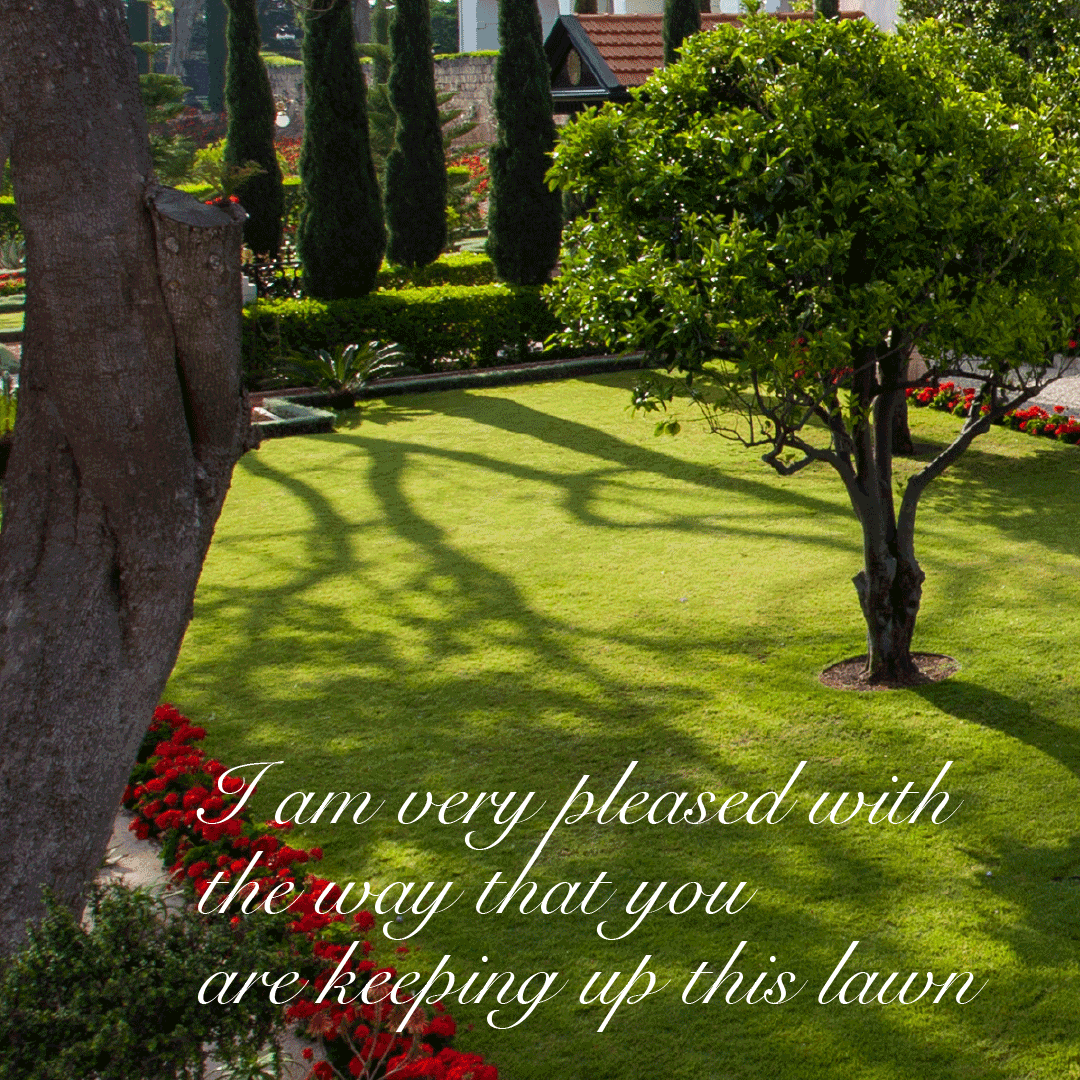
Perfectly manicured lawn around the Shrine of Bahá'u'lláh. Source: Bahá'í Media Bank, © Bahá'í International Community 2023.
This composite section assembling facets of Shoghi Effendi’s love of people and his compliments to them is based on several sections of a talk by Hand of the Cause Leroy Ioas.
Shoghi Effendi constantly complimented everyone around him, the members of the International Bahá'í Council, Bahá'í pilgrims, his Israeli gardeners. As he would walk through the gardens, it was his habit to compliment the gardeners on their work as he walked past them saying:
You planted that very beautifully. Your flowers are very beautiful. I am very pleased with the way that you are keeping up this lawn. And I would like you to do so and so, and it’s just very beautiful.
Shoghi Effendi was always thinking about what he could do to make everyone around him happy—even though his own family made his life a living hell. If anyone had any difficulty, he would think of what he could do to help them and ease their pain, lighten their load, help them to be more efficient, but he never applied that same train of thought to himself.
It is positively extraordinary to think how the Guardian could have the time, with all the problems he had, all the difficulties he was juggling, all the opposition he had to endure, how could he have time to think of these little things, yet the fact that he did, was what made him our beloved Guardian.
The Guardian’s love was amazing. He loved people, and he loved everyone, in everyone he saw the face of God, and he looked at them seeing their attributes, their qualities, and their virtues, and never their shortcomings. What registered for the Guardian was what that person was offering to Bahá'u'lláh, not their sins. What were their accomplishments, their good deeds, their virtues, their qualities, their character? That was how the Guardian saw them. He had no use or interest for anything else. He was always ready to forgive, ready to help.
This love of the Guardian, his tenderness, his gentleness, and the way that the Guardian simultaneously built up the entire Administrative Order of the Faith of Bahá'u'lláh, was a combination the world will never see again.
It was the Guardian.
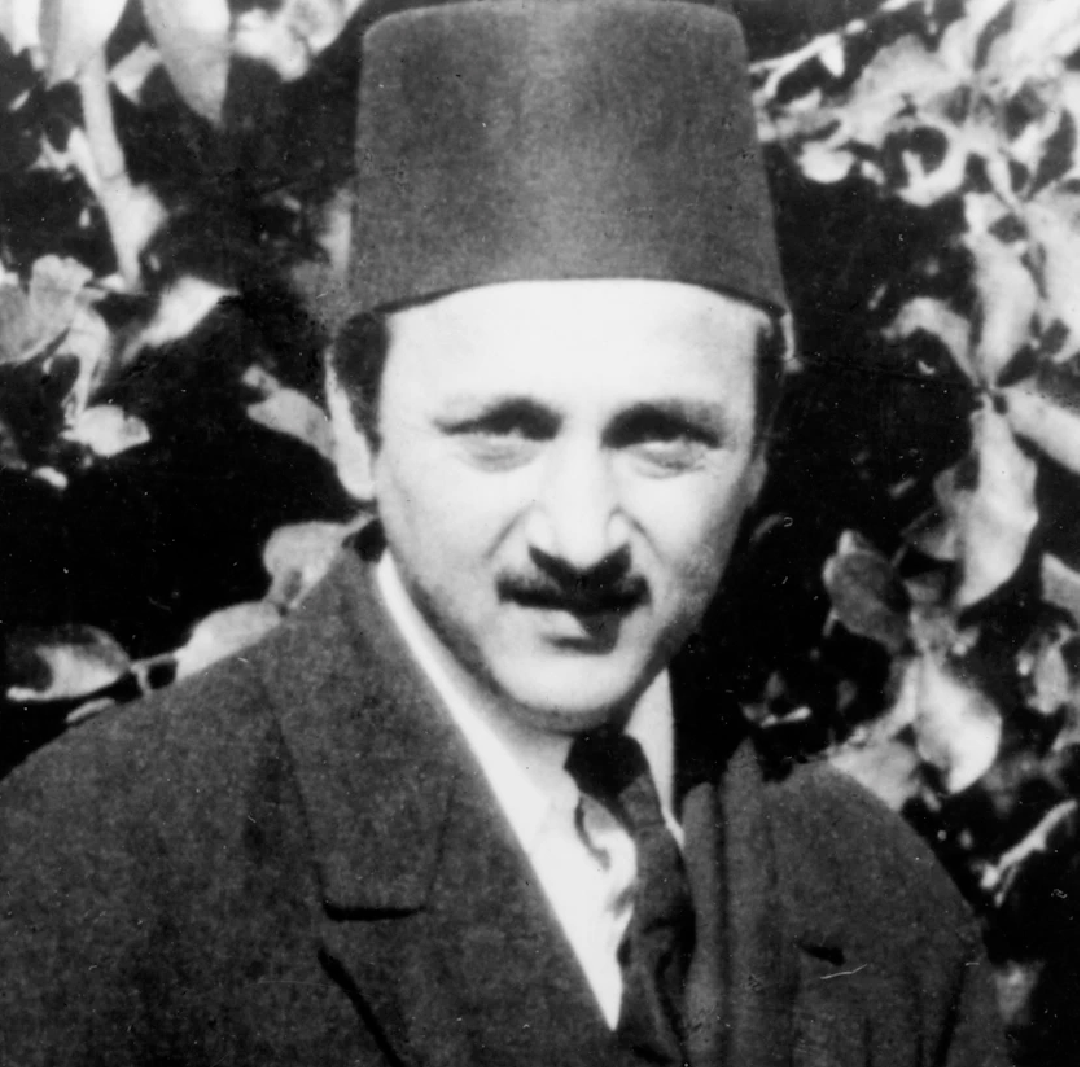
The Guardian was short in stature, with dark hair, which towards the end of his ministry began greying on the sides. He had an olive complexion, and his eyes were described by pilgrims to be of many different colors, dark, brown, but Rúḥíyyih Khánum, who gazed into them for 20 years, stated that the Guardian had immense eyes describing them as “of that deceptive hazel colour that sometimes led people who did not have the opportunity to look into them as often as I did to think they were brown or blue. The truth is they were a clear hazel which sometimes changed to a warm and luminous grey.”
Shoghi Effendi had fine, symmetrical features and was clean-shaven except for a small, dark mustache. He exuded energy, even when he was at rest, and he had a strong body, and when he hugged the pilgrims, they could feel his strength. He had very beautiful, small, slender hands, shapely and expressive, which the Greatest Holy Leaf said were exactly like the hands of her Father, Bahá'u'lláh. There was always an air of grace about the Guardian. All his gestures were graceful.
He often wore a rust-colored coat, always wore a tie, sometimes black, sometimes brown but he always wore his distinctive black fez, and a gold Bahá'í ring on the second finger of his right hand.

Construction project image by Guilherme Cunha on Unsplash.
In an excerpt of her private diary, Rúḥíyyih Khánum describes the resistless, unstoppable, formidable temperament of Shoghi Effendi, comparing his energy, his persistence, his drive to something utterly irresistible:
Temperamentally Shoghi Effendi is a doer, a builder, an organizer, and loathes abstractions!...No one, observing Shoghi Effendi, could doubt for a moment that he was not perfectly equipped for this phase of the Cause and I believe he was created for it to do just what he is doing. He is the most extraordinarily uni-directional person I have ever seen. His whole nature and tastes and likes and dislikes are intense. He is like something travelling at high speed in one direction, which gives him almost infinite driving power. His persistence is irresistible; there is no dissipation of his forces. He only wants one thing, he wants it passionately, immediately, completely, perfectly. The Temple built - or a flight of steps here in the garden. He descends on it like a hurricane and never lets up until it is done. He drives ahead. It is extraordinary.
In this magnificent excerpt of Rúḥíyyih Khánum’s diary, she returns to the theme of the power inherent in Shoghi Effendi’s unstoppable energy, comparing him at first to an object hurtling through space at insurmountable speed, then to a chemical, successively created through the agency of both Bahá'u'lláh and 'Abdu'l-Bahá:
The strongest impression I always get of Shoghi Effendi is of an object travelling uni-directionally with terrific force and speed. If Bahá'u'lláh shone like the sun, and the Master gently went on radiating His light, like the moon, Shoghi Effendi is an entirely different phenomenon, as different as an object hurtling towards its goal is from something stationary and radiating. Or one could liken him to a chemical. Bahá'u'lláh assembled everything that we needed, the Master mixed everything together and prepared it; then God adds to it "one "element, a sort of universal precipitant, needed to make the whole clarify and go on to fulfil its nature—this is the Guardian...he is made exactly to fulfil the needs of the Cause—and consequently of the planet itself—at this time.

Photo by Markus Spiske on Unsplash.
This perhaps may not be the facet of Shoghi Effendi’s character that immediately springs to mind, but he was very open and frank, and confided in Bahá'ís.
One of the Guardian’s mesmerizing qualities, when he was speaking with Bahá'ís was a fascinating mixture of several characteristics. He was free, but at the same time dignified, he was reserved, but also deeply enduring, he was refreshingly open, and more than anything, he had a captivating self-confidence and self-assuredness.
The Guardian hated secrecy above all, and so he brought into his confidence the pilgrims he talked to, sharing with them his projects, plans, ideas, interpretations of the Teachings. In fact, Shoghi Effendi, although he communicated officially with National Spiritual Assemblies, shared his plans in great detail with pilgrims.
He would discuss the affairs and conditions of the Faith with astonishing openness and frankness, and repeatedly emphasized to the pilgrims that openness, frankness and truthfulness among the friends was one of the greatest and most powerful remedies for struggling communities, and in the way he spoke to them, he was, in fact, setting for the pilgrims the example of free and open consultation.
Shoghi Effendi was so enthusiastic and generous in sharing his plans that he sometimes even drew little sketches of his ongoing projects at the dinner table, sharing what he was working on in the gardens, the Shrine of Bahá'u'lláh, or the Shrine of the Báb.
With an endearing simplicity and modesty, the Guardian encouraged Bahá'ís—pilgrims, visitors, staff, or his close collaborators—to ask him questions, offer their suggestions and consult with him.
When they did, the Guardian listened to every suggestion with utmost intent, courtesy and seriousness, before shedding on the suggestion the light of his wonderfully lucid mind, his clear and all-comprehensive thought, and his powerful and penetrative judgment.
But although Shoghi Effendi was open, transparent and frank, although he was eager to hear thoughts, he was deeply attuned to the sincerity of the speaker. The Guardian had the innate capacity to instantly detect any trace of insincerity, any underlying motive, and any effort to sway him or influence him in any way, or in any direction, and he would not stand for it.
The Guardian could never be influenced or swayed. He was, after all, invested by divine authority and infallibility.

Photo by Robert Lukeman on Unsplash.
One day a woman asked to come on pilgrimage to visit Shoghi Effendi. To Rúḥíyyih Khánum’s astonishment, the Guardian said:
Yes, come.
The woman was not a Bahá'í.
She was the widow of an early American Bahá'í who had passed away, and she wanted to go on pilgrimage because she knew her husband would have wanted to. The woman would never become a Bahá'í, but she came to Haifa on pilgrimage for 9 days, and during this time, she was Shoghi Effendi’s guest at the western Pilgrim House along with Bahá'í pilgrims.
Shoghi Effendi took great care of the woman. He made sure that the conversations around the dinner table were pleasant for her and didn’t include excessive talk about the work of the Bahá'í Faith, all subjects she would have been completely unfamiliar with, and which would have made her feel perhaps unwelcome or excluded.
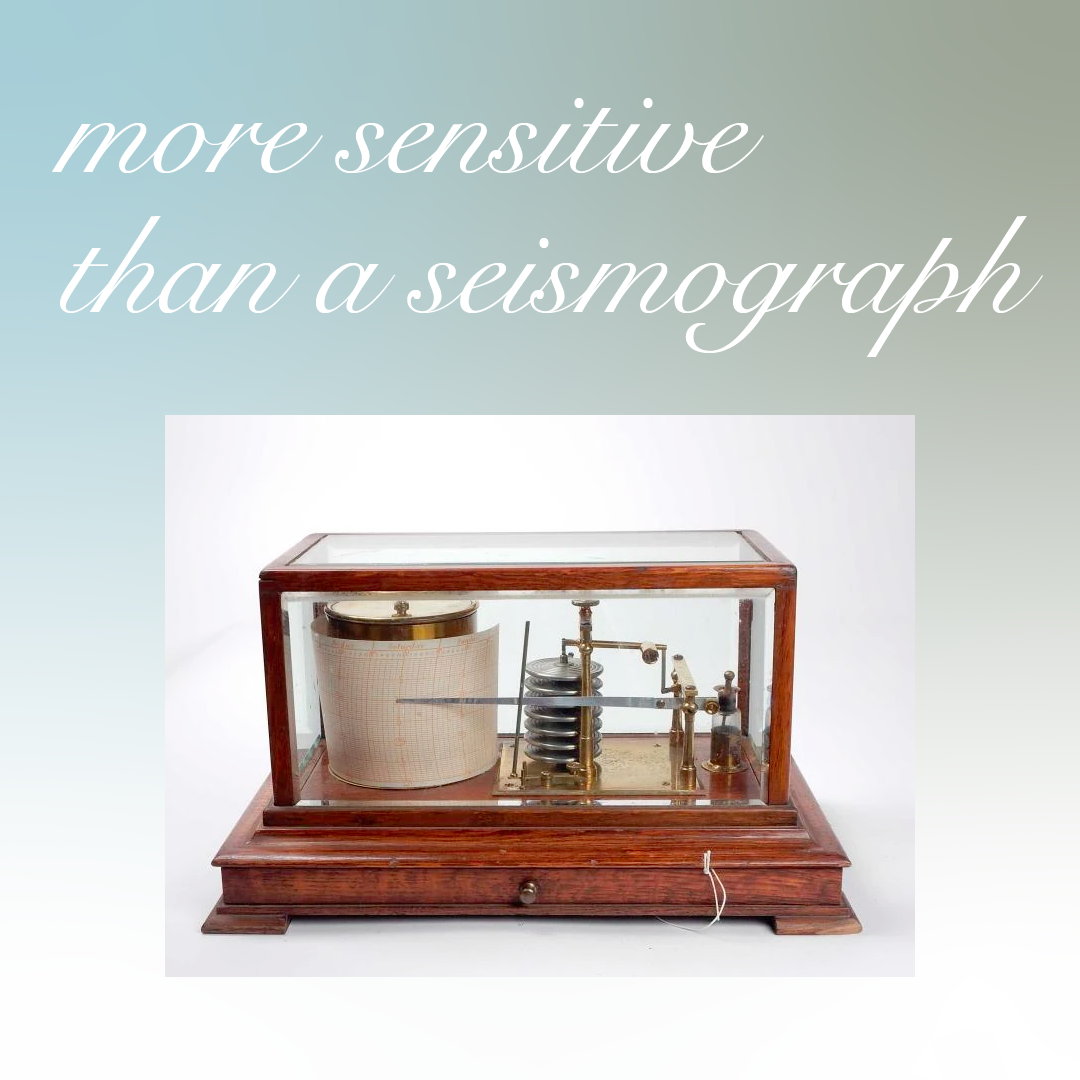
Charles Francis Richter’s seismograph, to measure the magnitude of earthquakes. Richter was an American seismologist and physicist and is most famous as the creator of the Richter magnitude scale for earthquakes. Source: Warehouse 13 Artifact Database Wiki.
In this first excerpt of her diary, Rúḥíyyih Khánum describes the superhuman sensitivity of Shoghi Effendi, the sensitivity of the infallible Guardian who is perfectly attuned to what she terms “the tuning fork of the teachings,” and perceives things in the individual they themselves are unaware of:
The Guardian is more sensitive than a seismograph, something in him, far deeper than intelligence or any outward information he may have, registers the state of the individual, registers things even the individual may not yet be aware of. I believe we should use him as our index and if he finds fault with some subtle attitude in us we should search ourselves til we find out what it is.
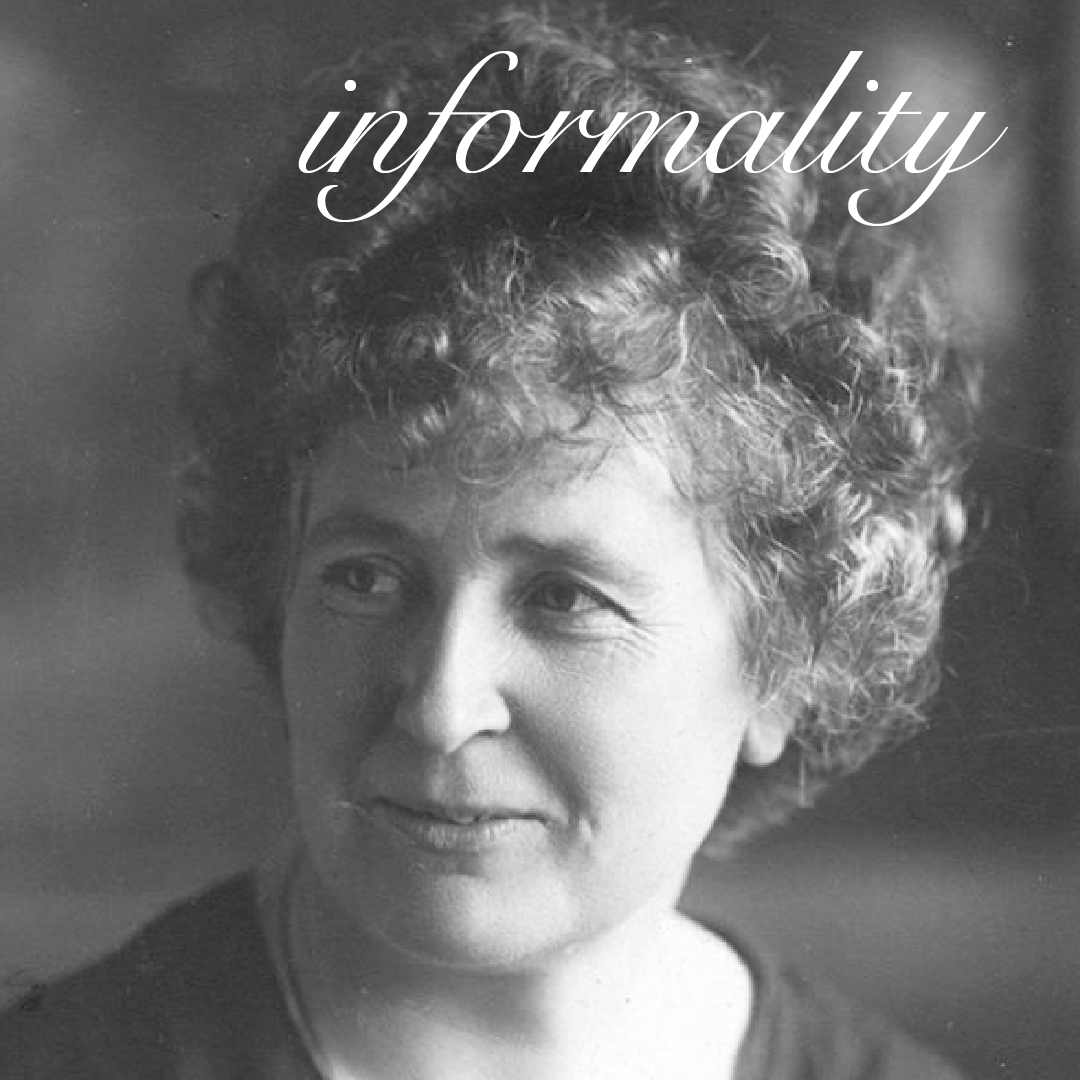
Victory Bedekian, “Auntie Victoria.” Source: Brilliant Star Magazine.
Shoghi Effendi had a particular quality of knowing how every single person or thing he encountered could serve the Faith, and he had a great informality with some of his partnerships and sources of information.
For example, one of Shoghi Effendi’s collaborators was a woman named Victoria Bedekian, better known as “Auntie Victoria.” Auntie Victoria wrote letters which were very widely circulated throughout the world, and the Guardian encouraged her to keep writing her letters, at times even advising her on content.
Shoghi Effendi was also sometimes informal in terms of happy news. He would share information about a victory, a new pioneer settling at their post or another piece of good news in his messages, instead of waiting several weeks for the confirmation.
This allowed Shoghi Effendi latitude, and the work of the Faith did not grind to a halt, waiting for official channels to confirm this or that piece of news. This is one of the reasons why the work of Shoghi Effendi advanced so fast. The encouragement Bahá'ís received from his letters, filled with so much good news, stimulated the collective unconscious of the community. Shoghi Effendi understood that this piece of news was fresh, and needed to be shared, that it would not survive if he had to wait for weeks before sharing it.
However, when it came to his data, statistics, and maps, that was entirely a different side of the Guardian. Their exactitude, minute precision and exactitude were works of wonder, truly astonishing feats, transforming data into art.
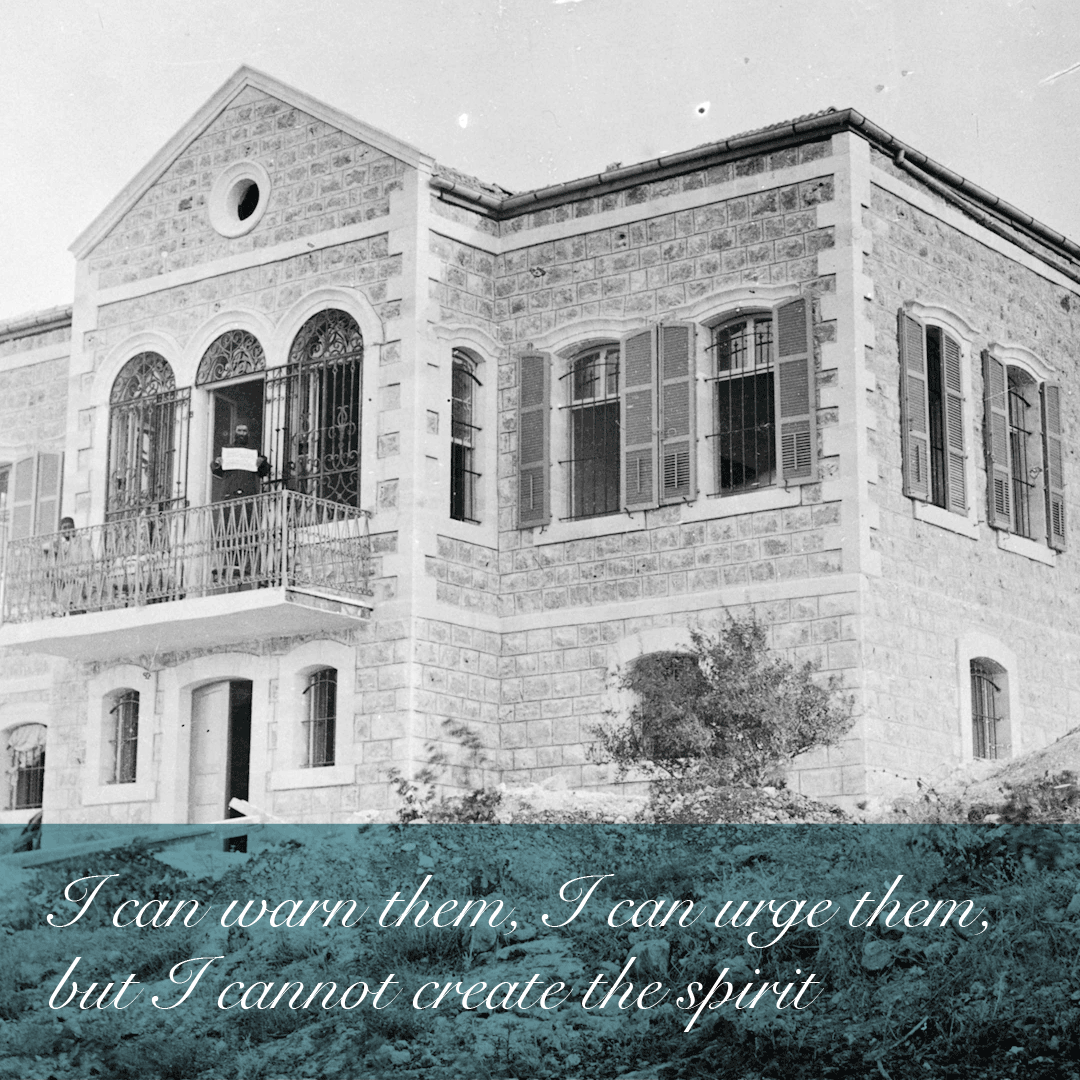
The Eastern Pilgrim House in Haifa, near the Shrine of the Báb. Bahá'í Source: Bahá'í Media Bank, © Bahá'í International Community 2023.
One of the Guardian’s most endearing qualities was his straightforwardness, which, combined with his courtesy, his graciousness as a host, his kindness, had a tremendous impact on the success of his work.
Through his beautiful character, endearing personality, unmatched qualities as a leader, Shoghi Effendi was a spiritual leaven to the worldwide Bahá'í community. He had the ability to stimulate the Bahá'ís to exert themselves more through service, to make better efforts, and he managed to make all Bahá'ís, especially those who never had the honor of meeting him in person, feel like they knew him, feel like the connected with him.
The Guardian’s qualities created a sense of nearness between the worldwide Bahá'í community and the Bahá'í World Centre. No other method could have come close to producing these amazing results.
When the Guardian met with pilgrims, he could convey in eloquent, straightforward words how he felt on certain subjects and issues.
Sometime in 1954, for example, Shoghi Effendi was speaking emphatically to pilgrims on the needs of the Ten Year Crusade and the Bahá'ís’ attitude towards pioneering:
I can warn them, I can urge them, but I cannot create the spirit - it is unhappiness for me and danger for the believers, that really results…
Shoghi Effendi did not mince his words when speaking about the Bahá'í Faith’s resilience despite unfavorable odds:
The Cause triumphs in spite of the inaction of a large number of its supporters, in a mysterious way it works.
The Guardian could also be very straightforward about a deficient attitude in pioneers, when it could be a lesson for those who were listening to him:
They bring into the schools the American mode of life instead of driving it out and establishing the Bahá'í mode of life.
There was another aspect of the Guardian’s unflinching frankness. If ever a Bahá'í would express their joy at the honor of meeting him, Shoghi Effendi would immediately brush the compliment aside and refocus the priorities of the well-meaning pilgrim.
The goal of pilgrimage was to visit the Holy Shrines, not the Guardian.
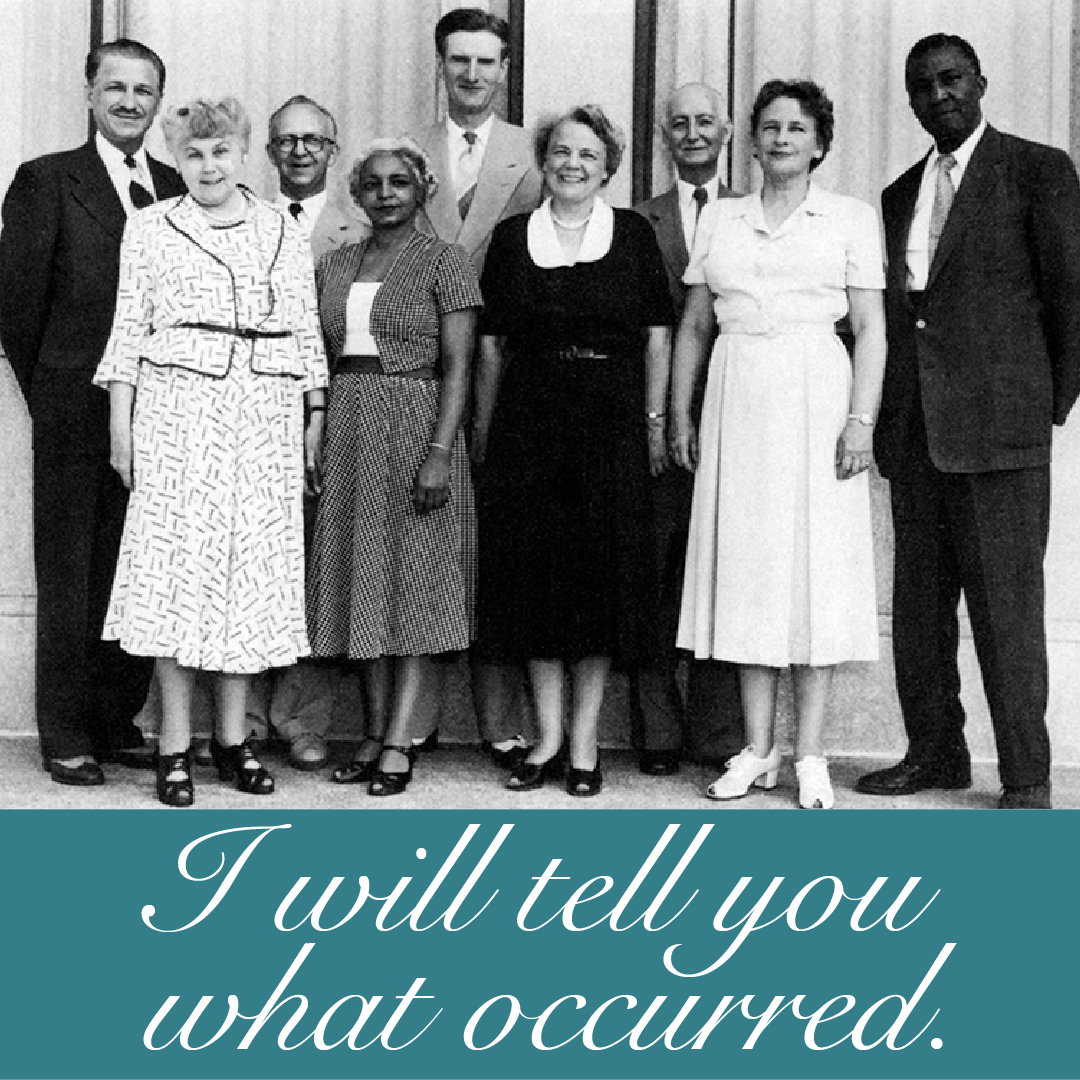
Photograph of the National Spiritual Assembly of the United States in 1953. Source: Bahaimedia.
Shoghi Effendi had a penetrating power, able to feel the questions in the minds of Bahá'ís and answer them just as they had finished thinking them. There are countless testimonies of this ability which never ceased to amaze the Bahá'ís, as if they had just felt the raw power of the Guardian.
One night Shoghi Effendi was speaking about how the Universal House of Justice and the National Spiritual Assemblies would work together in the future and Leroy Ioas thought to himself that this might not work in some circumstances. As soon as he had thought this, the Guardian took a sip of coffee and turned to him, saying:
You wouldn't think this would work under certain circumstances, but I will explain to you how it does.
Another time, when the Guardian was very concerned about a decision that the National Spiritual Assembly of the United States had taken, he asked Leroy Ioas:
You were on the Assembly when this was first discussed; tell me what their thinking was.
Leroy Ioas began to explain when the Guardian stopped him and said:
I will tell you what occurred.
The Guardian proceeded to explain what had happened as if he himself had been present at the meeting and asked Leroy Ioas if he was right or wrong. Leroy Ioas said:
You are exactly right, Shoghi Effendi, even to the details.
The penetrating power of the Guardian into people’s minds and past events was immediate and precise.
At times, during May Maxwell’s 1923 pilgrimage in Haifa, the Guardian would say to her:
Mrs. Maxwell, the thoughts you are thinking are not true.

Strong trees bent by the wind, a symbol of flexibility. Source: Explanders.
Under the influence of divine guidance, Shoghi Effendi often showed flexibility, and was able to change course constantly. His plans would change as he was inspired. These are a few examples of ideas the Guardian had, which he later changed:
- For a short while, he contemplated building a Shrine of Bahá'u'lláh and re-interring Him on Mount Carmel, but he gave up on this idea entirely and fixed Bahá'u'lláh’s permanent resting place in Bahjí;
- He first announce the Ten Year Crusade as the Seven Year Plan;
- He originally announced that one Temple would be built during the Ten Year Crusade, and later brought that total to three Temples;
- He originally had 8 European goal countries, and later increased the number to 10.
The point is that Shoghi Effendi was not strict, unchanging, inflexible, his priorities were the growth of the Faith and its safety, and when he was moved to change anything, it was always for the best interest of the Cause.
Of course, if outside forces frustrated his plans, such as the Bahá'í community not being able to get custody of the Most Great House of Bahá'u'lláh in Baghdád, Shoghi Effendi immediately compensated, so that if any temporary defeat or humiliation blemished the Bahá'í Faith, it would always, he ensured, come out on top, with some sort of victory, or a richer endowment.
Shoghi Effendi’s attitude was that, even if he was deflected from his goal, he was never defeated in his purpose. The Guardian always displayed a remarkable degree of creativity and ingenuity.
An example of Shoghi Effendi’s ingenuity was how he managed the simultaneous design and construction of two of the three Temples which were announced as goals for the Ten Year Crusade, the Continental Houses of Worship for Africa and Australasia in Kampala, Uganda, and Sydney, Australia.
First, Shoghi Effendi chose two suitable designs by his architect, Mason Remey, for each of the Temples, which he felt filled several criteria: they were dignified, had pleasing proportions, a conservative style, and not too expensive to build. Because Mason Remey could not supervise construction at the same time in Uganda and Australia, two opposite corners of the planet, Shoghi Effendi came up with an ingenious plan.
He instructed the National Spiritual Assemblies of Central and East Africa, and Australia to hire local architectural firms to build the Continental Houses of Worship, and when the firms made expensive suggestions, the Guardian himself modified them until he felt the cost was reasonable for the Faith.

Photo by Andrik Langfield on Unsplash.
Time is short, tasks ahead manifold, pressing, momentous.
Time is short. Sands chaotic despairing civilization steadily running out.
Time is short, and the obligation sacred, paramount and urgent.
Time is short. Opportunities, though multiplying with every passing hour, will not recur, some for another century, others never again.
“Time is short” was one of Shoghi Effendi’s phrases, and it perfectly described his eagerness, which he had shown since birth, and when he was five, asking 'Abdu'l-Bahá, again and again to reveal a Tablet for him, and again when he was at Oxford, convincing his professor to take a shorter break and teach him, and again, as the Guardian spurring on the Bahá'ís to win victories in the Ten Year Crusade.
The Guardian’s eagerness was one of the first things Ugo Giachery noticed about Shoghi Effendi when he first met him:
I became aware of this burning flame within his soul, for it was manifested in the emphasis of his speech, in the penetrating and searching gaze of his intelligent eyes, in the swiftness of his action and in the rewarding smile with which he recompensed those who acted promptly.

Photo by Hugo Jehanne on Unsplash.
One day when Rúḥíyyih Khánum was with the Guardian, he was speaking about what must have been a delicate situation, and Rúḥíyyih Khánum said to him:
Shoghi Effendi, you're so suspicious.
And Shoghi Effendi responded:
I am suspicious? You should have known ‘Abdu’l-Bahá. He was much more suspicious than I am.
And Rúḥíyyih Khánum had a revelation.
The Guardian’s suspicion—and 'Abdu'l-Bahá’s before him—were not paranoia without any basis in fact.
Rúḥíyyih Khánum understood that the Center of the Covenant and the Guardian of the Cause could not protect the Faith without the element of suspicion. In a deeply perceptive analysis of Bahá'í mentality, Rúḥíyyih Khánum described what Bahá'ís believed about 'Abdu'l-Bahá and how they believed they should act, as “good” Bahá'ís:
We always think of ‘Abdu’l-Bahá kissing the babies and walking around and showering love on everybody and being so patient, and so forbearing. And always we Bahá’ís should look on the good and never on the bad and so on, and mention the good and not the evil.
But the problem when one is a Center of the Covenant, or a Guardian of the cause is that Evil, most definitely, most assuredly, exists and thrives on forbearing, conciliatory, patient, unsuspicious believers. Covenant-breakers lurk in that half-light of trust, they prey on it, and they use it as a Trojan horse to inflict damage on the Cause and its Head. As Rúḥíyyih Khánum said:
And then I understood from the Guardian that you couldn't possibly protect the Faith unless you were suspicious. You see, suspicion puts you on your guard. If you don't visualize that something can happen, how can you protect yourself? …To protect the Bahá’ís, to protect the Faith, to protect the Cause of God from enemies—it doesn't have to be Covenant-breakers—from any attack, from any entity. We should be vigilant.
A better word than suspicious to describe the Guardian would have to be vigilant. The Guardian was ever-vigilant, always watchful, permanently on his guard, ready for anything, at any moment, from any person, in any direction.
SOURCES FOR PART VIII
17 October 1927: Internal opposition: The Guardian expels Avárih
The Covenant of Bahá’u’lláh, Adib Taherzadeh, George Ronald, Oxford, 1992 Chapter 31: Rebellion in the West.
The Priceless Pearl, Rúḥíyyih Rabbání, Bahá’í Publishing Trust, London, 1969, page 120.
Bahá’í Administration, Shoghi Effendi: Letter of 17 October 1927.
Encyclopaedia Iranica: Āyatī, ʿabd-Al-Ḥosayn.
Wikipedia: Abd al-Hosayn Ayati.
1928: Shoghi Effendi and ‘Alí Yazdí are reunited after 8 years
Blessings Beyond Measure: Recollections of ‘Abdu’l-Bahá and Shoghi Effendi. Ali M Yazdí, Bahá’í Publishing Trust, 1988, pages xi-xii, 35-37 and 88-89.
Wikipedia: Marion Carpenter Yazdí.
Before July 1928: “Apostle of Bahá’u’lláh”: The passing of Hand of the Cause Ḥájí Amín
The Revelation of Baha’u’llah, Volume 3, Adib Taherzadeh, George Ronald, Oxford, 1983, pages 74-87.
The Revelation of Baha’u’llah, Volume 4, Adib Taherzadeh, George Ronald, Oxford, 1983, pages 23,
Amin, Haji Abu’l-Hasan on Bahá’í Library Online, Moojan Momen.
Lights of Fortitude: Glimpses into the Lives of the Hands of the Cause of God. Barron Deems Harper, George Ronald, 1997, pages 53-54.
Arches over the Years. Marzieh Gail, George Ronald, 1991, page 225.
Door of Hope. David S. Ruhe, George Ronald, Oxford, 1983, page 30.
Child of the Covenant: A Study Guide to the Will and Testament of ‘Abdu’l-Bahá. Adib Taherzadeh, George Ronald, 2000, page 398.
Bahaipedia: Ḥájí Amín.
Email communication with Fuad and Faruq Izadinia dated 30 November 2023 containing the original letter from the Guardian in Persian elevating Ḥájí Amín to the rank of Hand of the Cause.
Email communication with Adib Masumian dated 30 November 2023 containing the provisional translation into English of the letter from the Guardian in Persian elevating Ḥájí Amín to the rank of Hand of the Cause.
Source of the Persian message regarding Ḥájí Amín found in the compilation (توقیعات مبارکه، ج2، 1927-1939، ص93) (Letters from the Guardian, Volume 2, 1927-1939, page 93).
22 June 1928: External opposition: The Soviet Union seizes the House of Worship in ‘Ishqábád
Shoghi Effendi’s statements on the seizure of the House of Worship of ‘Ishqábád
REFERENCES FOR THE PREVIOUS TWO STORIES:
The Priceless Pearl, Rúḥíyyih Rabbání, Bahá’í Publishing Trust, London, 1969, pages 312-316.
The Bábí and the Bahá’í Religions (1844–1944): Some Contemporary Western Accounts, Moojan Momen, George Ronald, Oxford, 1981, pages 473-474.
6 December 1928: Shoghi Effendi’s attachment to The Bahá’í World
The Priceless Pearl, Rúḥíyyih Rabbání, Bahá’í Publishing Trust, London, 1969, pages 211-212.
Bahá’í Administration, Shoghi Effendi, Letter of 6 December 1928.
13 December 1928: A full-scale investigation of the Bahá’í Faith in Turkey
The Priceless Pearl, Rúḥíyyih Rabbání, Bahá’í Publishing Trust, London, 1969, pages 316-318.
Dissent and Heterodoxy in the Late Ottoman Empire: Reformers, Babis and Baha’is, Dr. Necati Alkan, Ph.D. Thesis, Isis Press, Istanbul (2008), pages 198 and 210.
The Priceless Pearl, Rúḥíyyih Rabbání, Bahá’í Publishing Trust, London, 1969, pages 119-120.
The Covenant of Bahá’u’lláh, Adib Taherzadeh, George Ronald, Oxford, 1992 Chapter 31: Rebellion in the West.
Shoghi Effendi Through the Pilgrim’s Eye Volume 1 Building the Administrative Order, 1922-1952. Earl Redman, George Ronald, Oxford, 2015, Kindle Edition, Location 3575-3613.
Wikipedia: Ruth Berkeley White.
The Light of Divine Guidance, Shoghi Effendi, Letter dated 8 April 1931, pages 17-18.
Bahá’í Administration, Shoghi Effendi.
Shoghi Effendi: The Range and Power of His Pen, ‘Alí Nakhjávání, Acuto 2006, Casa Editrice Bahá’í, pages 134-137.
Compilation of Compilations, Volume 1, pages 187-234: The Importance of Deepening Our Knowledge and Understanding of the Faith, by Bahá’u’lláh, Abdu’l-Bahá, and Shoghi Effendi, (1991): Excerpt 120: From a letter dated 9 May 1934 written on behalf of Shoghi Effendi to the National Spiritual Assembly of the Bahá’ís of India.
1928 – 1929: External opposition: The Most Great House of Bahá’u’lláh in Baghdad
The Priceless Pearl, Rúḥíyyih Rabbání, Bahá’í Publishing Trust, London, 1969, pages 94-97.
The Bahá’í World, Volume 3, pages 50-55 and 198-206.
The Case of Bahá’u’lláh’s House in Baghdád Before the League of Nations, Petition to the Permanent Mandates Commission of the League of Nations, The Bahá’ís of Iráq.
Shoghi Effendi Through the Pilgrim’s Eye Volume 1 Building the Administrative Order, 1922-1952. Earl Redman, George Ronald, Oxford, 2015, Kindle Edition, Location 3805.
Chronology on Bahá’í Library Online: The House of Bahá’u’lláh.
Letters and Extracts of Writings from the Guardian Published in the US Bahá’í News 1924 – 1934, Shoghi Effendi, Cable dated February 1929.
God Passes By, Shoghi Effendi.
An excerpt from the World Order of Bahá’u’lláh
REFERENCES FOR THE PREVIOUS THREE STORIES:
The Priceless Pearl, Rúḥíyyih Rabbání, Bahá’í Publishing Trust, London, 1969, page 212.
The World Order of Bahá’u’lláh, Shoghi Effendi.
The World Order of Bahá’u’lláh: Further Considerations, Shoghi Effendi.
Shoghi Effendi: The Range and Power of His Pen, ‘Alí Nakhjávání, Acuto 2006, Casa Editrice Bahá’í, pages 137-140.
Before 8 March 1929: Pilgrim Notes: Shoghi Effendi’s instructions for prayer and meditation
Maxwells of Montreal, The: Middle Years 1923-1937 Late Years 1937-1952. Violette Nakhjavani, George Ronald, Oxford (2011), Kindle Edition, Location 1943-1964.
Bahá’í Library Online: Principles of Bahá’í Administration by Bahá’u’lláh, Abdu’l-Bahá, and Shoghi Effendi, compiled by National Spiritual Assembly of the Bahá’ís of the United Kingdom, London: Bahá’í Publishing Trust, 1950/1973, pages 90-91.
1929 – 1957: Horace Holley and the titles of Shoghi Effendi’s letters
The Priceless Pearl, Rúḥíyyih Rabbání, Bahá’í Publishing Trust, London, 1969, page 205.
Some Bahá’ís to Remember. O. Z. Whitehead, George Ronald, Oxford, 1983, pages 237-238.
4 May 1929: The Guardian obtains full recognition for the Bahá’í Faith in Palestine
The Priceless Pearl, Rúḥíyyih Rabbání, Bahá’í Publishing Trust, London, 1969, page 284.
God Passes By, Shoghi Effendi.
1929: An Indian Bahá’í brushes a portrait of Shoghi Effendi
The Priceless Pearl, Rúḥíyyih Rabbání, Bahá’í Publishing Trust, London, 1969, pages 78-79.
1929: Ahmad Sohrab’s “New History Society” and his path to Covenant-breaking
The Covenant of Bahá’u’lláh, Adib Taherzadeh, George Ronald, Oxford, 1992 Chapter 31: Rebellion in the West.
The Priceless Pearl, Rúḥíyyih Rabbání, Bahá’í Publishing Trust, London, 1969, pages 120.
Bahá’í News, Issue 83 (May 1934).
Wikipedia: Ahmad Sohrab.
This Decisive Hour, Shoghi Effendi, Unconquerable Power, 12 August 1941.
12 December 1929: The Bahá’í world is not ready for an International Bahá’í Secretariat
The Priceless Pearl, Rúḥíyyih Rabbání, Bahá’í Publishing Trust, London, 1969, pages 248-251.
Summer – October 1929: Shoghi Effendi crosses Africa from Cape Town to Cairo
The Priceless Pearl, Rúḥíyyih Rabbání, Bahá’í Publishing Trust, London, 1969, page 180.
Shoghi Effendi Through the Pilgrim’s Eye Volume 1 Building the Administrative Order, 1922-1952. Earl Redman, George Ronald, Oxford, 2015, Kindle Edition, Location 3704-3724.
Early 1930: Shoghi Effendi completes the last three rooms of the Shrine of the Báb
The Priceless Pearl, Rúḥíyyih Rabbání, Bahá’í Publishing Trust, London, 1969, pages 85-86 and 263.
Coronation on Carmel: The Story of the Shrine of the Báb Volume II: 1922-1963, Michael V. Day, George Ronald, 2018, pages 49, 51, and 54.
Shoghi Effendi: Recollections, Ugo Giachery, George Ronald, 1973, pages 61-62.
Early 1930: The first International Bahá’í Archives
The Priceless Pearl, Rúḥíyyih Rabbání, Bahá’í Publishing Trust, London, 1969, pages 85-86 and 263.
Coronation on Carmel: The Story of the Shrine of the Báb Volume II: 1922-1963, Michael V. Day, George Ronald, 2018, pages 49, 51, and 54.
Shoghi Effendi: Recollections, Ugo Giachery, George Ronald, 1973, page 62.
3 February 1930: The 19 Apostles and 19 Disciples
The 19 Apostles of Bahá’u’lláh are:
The 19 Disciples of ‘Abdu’l-Bahá are:
REFERENCES FOR THE PREVIOUS THREE STORIES:
Maxwells of Montreal, The: Middle Years 1923-1937 Late Years 1937-1952. Violette Nakhjavani, George Ronald, Oxford (2011), Kindle Edition, Location 3306-3345.
Wikipedia: Apostles of Bahá’u’lláh.
The Bahá’í World Volume 3: The Disciples of ‘Abdu’l-Bahá.
Bahaipedia: Disciples of ‘Abdu’l-Bahá.
30 March 1930: The missed visit of Queen Marie of Romania
REFERENCES FOR THE PREVIOUS TWO STORIES:
The Priceless Pearl, Rúḥíyyih Rabbání, Bahá’í Publishing Trust, London, 1969, pages 113-116.
Queen Marie and the Baha’i Faith, Robert Postlethwaite, pages 76-77 and 79.
1929 – May 1930: The Guardian’s translation of the Kitáb-i-Íqán
A work of unsurpassed beauty in English
REFERENCES FOR THE PREVIOUS THREE STORIES:
The Kitáb-i-Íqán, Bahá’u’lláh.
The Priceless Pearl, Rúḥíyyih Rabbání, Bahá’í Publishing Trust, London, 1969, page 214.
George Townshend. David Hofman, George Ronald, Oxford, 1983, Chapter 6: Relationship with the Guardian.
Violetta Zein, The Blessed Beauty: The illustrated chronology of the life and Revelation of Bahá’u’lláh, Part IV: Baghdad.
God Passes By, Shoghi Effendi.
28 – 29 May 1930: Commemorating the Ascension of Bahá’u’lláh with the Guardian at Bahjí
1930: The Administrative Order
Shoghi Effendi Through the Pilgrim’s Eye Volume 1 Building the Administrative Order, 1922-1952, Earl Redman, George Ronald, Oxford, 2015, Kindle Edition, Locations 4004-4024.
1930: The development of National and Local Spiritual Assemblies
Shoghi Effendi trains Assemblies and Committees to provide accurate reporting
Shoghi Effendi’s encouragement of local publications
REFERENCES FOR THE PREVIOUS THREE STORIES:
The Priceless Pearl, Rúḥíyyih Rabbání, Bahá’í Publishing Trust, London, 1969, pages 344-357 and 362..
The Faith of Bahá’u’lláh: A World Religion, Shoghi Effendi, July 1947.
7 December 1930: How Shoghi Effendi received letters
Shoghi Effendi: The Range and Power of His Pen, ‘Alí Nakhjávání, Acuto 2006, Casa Editrice Bahá’í, pages 223-225.
Principles of Bahá’í Administration, A Compilation. (3rd edition) Bahá’í Publishing Trust, London, 1973, Appendices: A. Selected clarifying statements of the Guardian: Concerning letters from Haifa, page 89.
1929 – 1932: Shoghi Effendi’s summer retreats
The importance of Shoghi Effendi’s retreats in Switzerland
REFERENCES FOR THE PREVIOUS TWO STORIES:
The Priceless Pearl, Rúḥíyyih Rabbání, Bahá’í Publishing Trust, London, 1969, page 60.
17 February – 1 April 1931: Marion Jack’s second pilgrimage
A love which does not wait : the stories of Lua Getsinger, May Maxwell, Martha Root, Keith Ransom-Kehler, Hyde Dunn, Susan Moody, Dorothy Baker, Ella Bailey, and Marion Jack, Janet Ruhe-Schoen, Palabra Publications (1998), pages 268-269 and 274.
Shoghi Effendi Through the Pilgrim’s Eye Volume 1 Building the Administrative Order, 1922-1952. Earl Redman, George Ronald, Oxford, 2015.
1931: The local Bahá’í center of ‘Adasiyyíh
‘Adasiyyah: A Study in Agriculture and Rural Development, Iraj Poostchi Baha’i Studies Review, Volume 16, Number 1, 1 April 2010, pp. 61-105(45).
March 1931: Shoghi Effendi discovers the original Tablets of the Báb to the Letters of the Living
Corinne True: Faithful Handmaid of ‘Abdu’l-Bahá, Nathan Rutstein with the assistance of Edna True, George Ronald, Oxford (1987), page 176.
May 1931: Palestine/Israel branches of Bahá’í National Spiritual Assemblies
The Priceless Pearl, Rúḥíyyih Rabbání, Bahá’í Publishing Trust, London, 1969, pages 267-268 and 284.
The Faith of Bahá’u’lláh: A World Religion, Shoghi Effendi: Cover Letter.
29 May 1892 – 27 November 1929: 37 years of ruin
27 November 1929: At long last, the Guardian obtains the keys to the Mansion of Bahjí
27 November 1929 – 1930: The Guardian beautifies the Mansion of Bahjí
REFERENCES FOR THE THREE PREVIOUS STORIES:
The Priceless Pearl, Rúḥíyyih Rabbání, Bahá’í Publishing Trust, London, 1969, page 233. Leaves of the Twin Divine Trees, Baharieh Rouhani Ma’ani, George Ronald, Oxford, 2013, Kindle Edition, Chapter 7: Bahá’íyyih Khánum, the Most Outstanding Heroine of the Bahá’í Dispensation.
Wives of Baha’u’llah, Letter dated 23 October 1995 on behalf of the Universal House of Justice.
Bahá’í Library Online chronology: Bahjí.
Bahá’í News, Issue 42 (July 1930).
God Passes By, Shoghi Effendi.
The Extraordinary Life of ‘Abdu’l-Bahá Part VIII: The Return to the Holy Land, September – November 1921 – HAIFA – ‘Abdu’l-Bahá brings electricity to the Holy Places.
Bahá’í News, Issue 53 (July 1931).
Shoghi Effendi: Recollections, Ugo Giachery, George Ronald, 1973, page 123.
Shoghi Effendi’s decoration of the Holy Places
Transcript of: Amatul’Bahá Rúḥíyyih Khánum’s concluding address at the First Bahá’í World Congress in London, 1963, Timestamp: 01:15:30.
The Priceless Pearl, Rúḥíyyih Rabbání, Bahá’í Publishing Trust, London, 1969, pages 119-120.
The Covenant of Bahá’u’lláh, Adib Taherzadeh, George Ronald, Oxford, 1992 Chapter 31: Rebellion in the West.
Shoghi Effendi Through the Pilgrim’s Eye Volume 1 Building the Administrative Order, 1922-1952. Earl Redman, George Ronald, Oxford, 2015, Kindle Edition, Location 3575-3613.
Wikipedia: Ruth Berkeley White.
The Light of Divine Guidance, Shoghi Effendi, Letter dated 8 April 1931, pages 17-18.
1930 – July 1931: The Guardian restores the Mansion of Bahjí
The Greatest Holy Leaf visits the Mansion of Bahjí for the first time in four decades
REFERENCES FOR THE TWO PREVIOUS STORIES
The Priceless Pearl, Rúḥíyyih Rabbání, Bahá’í Publishing Trust, London, 1969, page 233. Leaves of the Twin Divine Trees, Baharieh Rouhani Ma’ani, George Ronald, Oxford, 2013, Kindle Edition, Chapter 7: Bahá’íyyih Khánum, the Most Outstanding Heroine of the Bahá’í Dispensation.
Wives of Baha’u’llah, Letter dated 23 October 1995 on behalf of the Universal House of Justice.
Bahá’í Library Online chronology: Bahjí.
Bahá’í News, Issue 42 (July 1930).
God Passes By, Shoghi Effendi.
The Extraordinary Life of ‘Abdu’l-Bahá Part VIII: The Return to the Holy Land, September – November 1921 – HAIFA – ‘Abdu’l-Bahá brings electricity to the Holy Places.
Bahá’í News, Issue 53 (July 1931).
Shoghi Effendi: Recollections, Ugo Giachery, George Ronald, 1973, page 123.
Shoghi Effendi: Recollections, Ugo Giachery, George Ronald, 1973, pages 6-9.
In the Days of the Guardian: Transcript of a talk by Hand of the Cause of God Leroy Ioas, Johannesburg, South Africa, 1958.
Shoghi Effendi’s physical appearance
The Priceless Pearl, Rúḥíyyih Rabbání, Bahá’í Publishing Trust, London, 1969, pages 6-7.
Bahá’í Library Online: Pilgrimage to Haifa and ‘Akká: Parts 2 and 3, (Part 1 missing), Bill Sears, page 4.
Shoghi Effendi’s irrepressible energy
The Priceless Pearl, Rúḥíyyih Rabbání, Bahá’í Publishing Trust, London, 1969, page2 81-83.
The Priceless Pearl, Rúḥíyyih Rabbání, Bahá’í Publishing Trust, London, 1969, pages 131-132.
Conversations with Shoghi Effendi, (1924), May Maxwell, pages 2-3.
Shoghi Effendi’s inclusiveness
Transcript of: Amatul’Bahá Rúḥíyyih Khánum’s concluding address at the First Bahá’í World Congress in London, 1963, Timestamp: 01:11:00.
Shoghi Effendi’s superhuman sensitivity
The Priceless Pearl, Rúḥíyyih Rabbání, Bahá’í Publishing Trust, London, 1969, page 81.
The Priceless Pearl, Rúḥíyyih Rabbání, Bahá’í Publishing Trust, London, 1969, pages 127-128.
Shoghi Effendi’s straightforwardness
The Priceless Pearl, Rúḥíyyih Rabbání, Bahá’í Publishing Trust, London, 1969, pages 132-133.
Shoghi Effendi’s penetrating power
Leroy Ioas: Hand of the Cause of God. Anita Ioas Chapman, George Ronald, 1998, page 287
Shoghi Effendi Through the Pilgrim’s Eye Volume 1 Building the Administrative Order, 1922-1952. Earl Redman, George Ronald, Oxford, 2015, Kindle Edition, Location 1708.
Shoghi Effendi’s flexibility and ingenuity
The Priceless Pearl, Rúḥíyyih Rabbání, Bahá’í Publishing Trust, London, 1969, pages 130-131.
Wikipedia: Sydney Bahá’í Temple.
Wikipedia: Bahá’í House of Worship.
Shoghi Effendi: Recollections, Ugo Giachery, George Ronald, 1973, page 23.
Transcript of: Amatul’Bahá Rúḥíyyih Khánum’s talk with pioneers in Petionville, Haiti, 20 November 1981, Timestamp: 01:36:21.
![]()
 Shoghi Effendi’s statements on the seizure of the House of Worship of ‘Ishqábád
Shoghi Effendi’s statements on the seizure of the House of Worship of ‘Ishqábád
